This post was originally published on CounterPunch.org.
-



































































Photograph Source: Embajada de EEUU en Argentina – CC BY 2.0
During his confirmation hearings to serve as Secretary of Health and Human Services (HHS), Robert F. Kennedy Jr. emphatically pledged to prioritize tackling Long COVID, a debilitating chronic condition that develops after COVID-19 infections and leaves many patients with lasting symptoms, such as fatigue, brain fog, and respiratory problems. Sen. Todd Young (R-Indiana) asked Kennedy if he would commit to funding research into treatments and diagnostics for Long COVID. Kennedy’s response? “Absolutely, senator, with enthusiasm.”
Fast forward to August 2025, and Kennedy has dismantled not only federal COVID prevention programs but also much of the research infrastructure devoted to understanding and treating Long COVID. He closed the Office of Long COVID Research and Practice, a central coordinating body established in 2023 to unify agency efforts on Long COVID, and failed to meaningfully replace it. His sweeping reorganization of HHS eliminated or consolidated key centers essential for disease surveillance and chronic illness response, including the National Center for Chronic Disease Prevention and Health Promotion. Reckless funding cuts have dealt a significant blow to ongoing research, derailing NIH-funded clinical trials on antivirals and immunotherapies for Long COVID, halting large-scale cohort studies that track patient outcomes, and stalling the development of new diagnostics to improve detection and classification.
Long COVID is a chronic, multisystem condition that follows COVID‑19 infection. It can arise regardless of the severity of the initial illness and is characterized by symptoms that may persist or emerge weeks to months after the acute phase of infection. Researchers have drawn parallels between Long COVID’s impact and that of a stroke or Parkinson’s. Long COVID also shares similarities with other post-viral syndromes such as myalgic encephalomyelitis/chronic fatigue syndrome (ME/CFS), which similarly involve long-term fatigue and autonomic dysfunction. Studies have shown that both Long COVID and ME/CFS can lead to quality-of-life impairments that outstrip many advanced cancers.
Additional research suggests that Long COVID may be just the tip of the iceberg. Studies of large patient cohorts have found that COVID infection significantly increases the risk of cardiovascular complications, including myocarditis, arrhythmias, heart failure, and blood clots, even in people without prior heart disease. Other studies have documented a higher incidence of metabolic conditions such as new-onset diabetes. There are also neurological sequelae; COVID infections can cause or accelerate cognitive decline and dementia. Evidence suggests that repeated infection may accelerate cancer risk, in part due to inflammation and immune dysregulation. Taken together, these findings suggest that the long-term burden of COVID may extend far beyond what is captured by “Long COVID” alone.
Kennedy is not a solo actor in this. Closing the Long COVID office, for example, coincided with a Trump executive order to “reduce the federal bureaucracy.” The involvement of others does not absolve Kennedy — the head of HHS — of responsibility for what takes place in his agency on his watch. It does, however, suggest that this is not a one-man problem but something more systemic and entrenched. The issue is not limited to HHS; the Occupational Safety and Health Administration (OSHA), for example, is currently seeking to remove the few remaining emergency reporting requirements for hospitals.
Creating Barriers to COVID Vaccines
Of course, one of the best ways to avoid Long COVID is to avoid getting infected with COVID. Kennedy has spoken about wanting to address root causes, and the root cause of post-COVID complications is infection with COVID, making prevention efforts a key way to prevent new health problems. Unfortunately, Kennedy has approached COVID prevention the same way he has approached measles prevention. He has gone after COVID vaccines, both the currently available shots and promising research into improved versions.
As a form of protection from Long COVID, the current vaccines appear to be useful, albeit insufficient on their own. Most studies indicate that vaccination reduces the risk of Long COVID, and several find additional benefits from boosters, although this varies by timing and variant. One meta-analysis found that COVID vaccination reduces the risk of developing Long COVID by around 30 percent, depending on variant and timing of vaccination. A more recent study suggested that vaccination had played a major role in observed declines in new cases of Long COVID during later infection waves. Primary series vaccinations appear to be the most effective in reducing the risk of developing Long COVID following infection. Subsequent variant-specific shots appear largely helpful as a means of preventing infection (as imperfectly measured by symptomatic disease), which in turn lowers the downstream risk of Long COVID. However, such protection is limited and short-lived. Vaccine effectiveness against symptomatic disease peaks at 50 to 70 percent within a few weeks of administration and declines substantially over the following months. It often approached negligible levels within six months, particularly in the face of immune-evasive variants like XBB and its descendants. Taken together, the evidence suggests that vaccines, although far from a silver bullet, are a useful tool for reducing Long COVID. Cutting off access to vaccines will almost certainly mean more Long COVID cases and more people with lasting complications.
Unfortunately, Kennedy’s leadership thus far has culminated in new barriers to COVID vaccination that threaten to severely limit this year’s uptake (assuming new vaccines become available at all). The Food and Drug Administration (FDA) declined to approve COVID vaccines for those under age 65 without high-risk conditions, instead requiring randomized controlled trials in those groups before considering future approval. This includes both primary series vaccinations and additional variant-specific shots for those who have already received their primary series. The FDA also revoked the Emergency Use Authorization for Pfizer’s vaccinein children under the age of 5, leaving Moderna’s formulation as the only authorized option for high-risk children in this age group. For healthy children under 5, the only remaining path to vaccination is now through off-label use by a healthcare provider. The new framework imposes similar restrictions on adults: as of August 22, individuals under the age of 65 without high-risk conditions became ineligible to receive COVID vaccines through standard authorization channels.
The effort was touted as a cautious, evidence-driven approach, but its effect is to delay and potentially deny broad access to vaccines that were previously available (if not always affordable) to a much wider population. Limited access for children younger than 5 years old could be especially devastating. This age group has experienced some of the highest COVID-19 hospitalization rates of any pediatric cohort. Emerging data suggests that Long COVID may have overtaken asthma as the most common chronic illness affecting US children, with nearly 5.8 million affected by post-COVID conditions.
Kennedy has gone after public health officials who don’t share his approach to vaccination. Earlier this summer, Kennedy fired every member of the Centers for Disease Control and Prevention (CDC) Advisory Committee on Immunization Practices (ACIP), a critical advisory body, replacing many of them with known vaccine skeptics. The ACIP’s role is to make recommendations within the boundaries of FDA approval; its personnel shake-up suggests that even within the FDA’s more restrictive framework, the CDC’s recommendations will be guided by an anti-vaccine political agenda rather than science. While ACIP had not always taken Long COVID seriously before, it did greenlight broad COVID vaccine eligibility in 2024, even if said vaccines remained financially out of reach for far too many.
Kennedy, CDC Firings, and Massive Research Cuts
And this past week, President Trump (at Kennedy’s behest) fired Susan Monarez, the director of the Centers for Disease Control and Prevention (CDC). A wave of protest resignations followed across senior leadership, including Chief Medical Officer Dr. Debra Houry, Director of the National Center for Immunization and Respiratory Diseases Dr. Demetre Daskalakis, and Director of the National Center for Emerging and Zoonotic Infectious Diseases Dr. Daniel Jernigan. In his resignation letter, Daskalakis opined, “Having worked in local and national public health for years, I have never experienced such radical non-transparency, nor have I seen such unskilled manipulation of data to achieve a political end rather than the good of the American people.”
The insufficient protection afforded by current vaccines makes ongoing research into the next generation of prophylactics that much more crucial. But this month, Kennedy unilaterally slashed $500 million from mRNA-related research, which encompassed, among other things, vaccines targeting COVID, H5N1 bird flu, and RSV. Kennedy justified the cuts in part by suggesting that mRNA technology is inherently unsafe, an assertion not supported by scientific evidence. Earlier this year, Kennedy’s HHS issued a stop-work order to CastleVax for its development of an intranasal COVID vaccine. Intranasal vaccines have shown promise in inducing the mucosal immunity necessary to better prevent transmission. The Trump government, however, has declared COVID “over” (despite evidence to the contrary), and thus all further research related to it is considered expendable.
This month, Kennedy’s HHS also took aim at wastewater surveillance, a crucial tool for people trying to use real-world data to calibrate their preventive measures. Wastewater monitoring provides an early warning system for spikes in COVID and other infectious diseases, helping immunocompromised individuals — such as those recovering from cancer — decide when it may be safer to risk exposure from necessary activities like visiting the dentist. Kennedy’s HHS has doubled down on a favorite minimization tactic of the previous administration, and has changed the thresholds for transmission categories, such that virus levels that were previously categorized as “high” are now considered “very low.” More alarmingly, under Kennedy, the CDC has quietly stopped normalizing wastewater data (that is, adjusting for things like rainfall levels), a technical change that will significantly degrade its quality and comparability over time. Without normalization, raw viral counts are misleading, making it far harder for individuals, communities, and health systems to gauge real infection trends. This change threatens to undermine one of the most important and cost-effective surveillance tools still available.
Kennedy is clearly not interested in keeping the promise he made to the American people to tackle Long COVID. His behavior does, however, track with the ableist healthism that Julie Doubleday lucidly identifies as the beating heart of Kennedy’s “Make America Healthy Again” (MAHA) movement. Ableist healthism is an ideology that equates being healthy with virtue and reframes public health as an individual lifestyle project rather than a collective obligation. It also conflates “natural” with “good,” which explains why MAHA advocates seem so unfazed by preventable deaths from ‘natural’ diseases like measles. Given MAHA’s complacency in the face of preventable death and disability from measles, it’s unsurprising that they would shun interventions like vaccines and other preventative medical interventions for COVID.
To be sure, Kennedy has capitalized on the earned mistrust of his predecessors. That mistrust was fueled by a series of blunders, including but not limited to downplaying the threat of long-term COVID sequelae, failing to fully grapple with the reality of airborne transmission, and an unwillingness to meaningfully revisit the “vax and relax” strategy even as evidence increasingly failed to support that approach. Many but not all of these blunders appeared to originate from corporate pressure to return to a “normal” with a weaker social state and fewer protections for workers.
However, rather than building back trust based on sound science, Kennedy has doubled down on misinformation. Rather than leveling with people about both the benefits and limitations of existing COVID vaccines, for example, he has cast ill-founded aspersions on their safety profile (and the safety profile of other preventative medicine). He has also actively made it more difficult for those who want to use vaccines to protect themselves to do so. Where the agency once sowed confusion through poor messaging, Kennedy has actively weaponized that communications weakness to recast scientific uncertainty as evidence of conspiracy, replacing cautious half-truths with clear falsehoods.
It is abundantly evident that Kennedy does not intend to prioritize the well-being of Long COVID patients. Instead of using his immense power to expedite research to help current patients and prevent new cases, he has taken a hatchet to the limited systems of care that were already in place. But disabled lives are not expendable. Millions of people living with Long COVID and other post-viral and chronic conditions deserve dignity, care, and a government that values their survival and well-being. Investing in scientific research and robust public health infrastructure is not charity, but a commitment to a collective future that values and includes everyone in our community. The Trump government’s abandonment of Long COVID patients and disdain for prevention is not acceptable and should be recognized for what it is: a political choice to deepen suffering rather than relieve it.
This first appeared on CEPR.
The post RFK Jr Doesn’t Care About Long COVID appeared first on CounterPunch.org.
This post was originally published on CounterPunch.org.
-
The Trump administration’s immigration crackdown efforts have begun interfering directly with frontline responders of recent disasters – raising substantial fears about what could happen when more serious disasters strike.
On August 27, the Seattle Times reported that two firefighter crews deployed to fight the Bear Gulch fire on the Olympic Peninsula were held by Border Patrol agents, and two firefighters were eventually arrested after being accused of living in the country illegally. As the Times reported in what must be the most incredible understatement of the year, “It is unusual for federal border agents to make arrests during the fighting of an active fire, especially in a remote area.” The move is baffling, as it is pretty well known that nationwide, recruiting and retaining wildland firefighters has been an ongoing challenge. This issue, highlighted by the Government Accountability Office, stems from factors such as low wages, poor work/life balance, mental health challenges, and a lack of workforce diversity. The situation is so dire that California uses incarcerated labor. The recent arrests are likely to exacerbate the problem significantly. The administration is now prioritizing statistics, like the number of undocumented immigrants caught in Immigration and Customs Enforcement’s (ICE) sweeps, over the country’s ability to combat destructive fires. And doing that in the middle of an active fire is deadly for everyone involved.
The White House is taking other steps that clearly prioritizing immigration detention over disaster relief. The Washington Post reported on the same day of the ICE raid in Washington state that new Department of Homeland Security contracts for aid organizations responding to disasters require these organizations to act as agents of ICE. The latest Fiscal Year 2025 DHS Standard Terms and Conditions for grants, cooperative agreements, fixed-amount awards, and financial assistance now includes a “Communication and Cooperation with the Department of Homeland Security and Immigration Officials” section. Within that section, recipients are required to share information, assist in immigration operations (including temporarily detaining people), provide access to information on disaster survivors, and maintain confidentiality around ICE operations. To be clear, this means that if an organization such as the Red Cross receives federal funding to set up a temporary shelter for evacuees, they are required to identify undocumented immigrants, detain them, and let ICE know.
There are so many logistical and ethical issues with this that it’s hard to know even where to start. Aid organizations are not equipped to meet these requirements, particularly for detaining someone. Their core mission revolves around saving lives, not enforcing immigration law. Aid organizations, many of which are faith-based, have expressed concerns that the requirements “violate First Amendment freedoms, undermine religious neutrality, and force institutions to betray core values.” Another problem is that these requirements will deter survivors from seeking aid or services from any organization that receives DHS funding. This can be a death sentence for survivors of a disaster.
These are just two examples out of many in which the administration’s decisions at FEMA are creating a scenario in which all the worst possible things can and will go wrong simultaneously. It is a fear that is not going unnoticed inside the government. Last week, 182 current and former Federal Emergency Management Agency (FEMA) employees addressed a letter to Trump’s FEMA Review Council and Congress stating recent decisions at the agency were putting the US at risk of another Hurricane Katrina-level disaster. Not surprisingly, the next day, about two dozen employees who had signed the letter were placed on leave. This reflects a pattern within the administration of replacing experienced and knowledgeable personnel who may disagree with policies with individuals who prioritize praising the president during meetings.
To be blunt, Trump’s interference with ongoing disaster recovery and relief efforts is dangerous. And as this pattern of politically motivated interference continues, the nation faces an escalating risk of failures in disaster response and an erosion of trust in the institutions that are supposed to keep people safe. With disasters increasing every year, lives are hanging in the balance. The US can’t afford political theater over doing what’s best for communities.
This first appeared on CEPR.
The post Immigration Interference in Disaster Relief Efforts Invites Catastrophe appeared first on CounterPunch.org.
This post was originally published on CounterPunch.org.
-



































































Photograph by Nathaniel St. Clair
Donald Trump’s blatant campaign for a Nobel Peace Prize has a new claim for his resume—his “diplomacy” is contributing to a new world order. Unfortunately, it is a world order that not only lacks a place for the United States, but actively excludes the United States. This world order is contributing to the burgeoning ties between Russia and China, which are without precedent, as well as among China, India, North Korea, and Russia. U.S. relations with each of them are in decline. Relations between the United States and India are the most recent victim in the formation of the new world order.
The United States had been the key to understanding the world order created at the end of World War II. For the first time in 80 years, the United States is on the outside looking in, not only in Europe but in the Indo-Pacific as well. Washington’s decline can be perceived in terms of power, influence, credibility, and standing. For the first time in 80 years, the United States lacks an influential national security team that can work closely with a president who has peculiar ideas about policy and process. The fact that Marco Rubio serves as both secretary of state and acting national security adviser (and has very limited influence in either capacity) speaks to the problem. As a result, Rubio has thrown his powers into limiting visas for foreigners, particularly for foreign students, a key factor in U.S. isolation.
Trump has gone out of his way to isolate the United States in the global community. His latest action was the denial and revocation of members of the Palestinian Authority and the Palestine Liberation Organization to attend this month’s UN General Assembly in New York. This comes at a time when key U.S. allies (Britain, France, Canada, and Australia) are planning to join with 147 UN members that already recognize a Palestinian state.
The denial of the visas for the PLO violates the 1947 UN charter, which states the United States “shall not impose any impediment” to the travel of representatives of the UN missions to the “headquarter district” in New York City. This visa ban will affect more than 80 Palestinians as well as the president of the Palestinian Authority, Mahmoud Abbas. (In 1988, the General Assembly met in Geneva so that Palestinian leader Yasser Arafat could address the assembly.) This week, the Trump administration suspended all types of visas for all Palestinians.
Sino-Russia: China and Russia have never had a relationship as close as the one that currently exists. There are multiple reasons for this, but the actions of the Trump administration are central to the forging of these close ties. Joint military exercises are a key part of the current situation as well as the generous exchange of military intelligence and weaponry. The convergence of Moscow and Beijing contrasts with the growing discord between the United States and its allies in Europe and Asia.
Sino-Russia-India: This week’s summit of the Shanghai Cooperation Organization, a Eurasian security group led by Moscow and Beijing, brought Indian Prime Minister Narendra Modi to China for the first time in seven years. Again, Trump was the catalyst for Modi’s decision due to Trump’s tariff policies and taking false credit for the cease-fire between India and Pakistan several months ago. Xi’s diplomacy played a major role in bringing India closer to both Moscow and Beijing. Xi gained from making sure that India would not join Washington’s policy of containment against China.
Sino-Russia-North Korea: Kim Jong-un’s attendance at the summit in China marks an important step in ending the discord between Beijing and Pyongyang. Kim’s relations with Moscow are also on solid ground in view of the military support from North Korea for Russia’s war with Ukraine. Trump’s mishandling of the recent meeting with South Korean President Lee Jae Myung and a tough trade policy with Japan are additional points of contrast.
BRICS: The founding countries of Brazil, Russia, India, China, and South Africa have added Egypt, Ethiopia, Indonesia, and the United Arab Emirates to the fold in an effort to form an alternative to the G7. Its objectives are anti-Western and anti-US. The Israeli genocide and US complicity, as well as Trump’s tariff and trade policies, have added to BRICS’ popularity and credibility.
U.S.-India: Until recently, India, the world’s largest democracy, and the United States were on course to create a cordial and reciprocal diplomatic and economic policy where both sides could accommodate each other. Trump has virtually brought this policy line to a halt with a doubling of tariffs on India exports. At the same time, the United States and India have created troubled democracies.
Finally, the Trump and Biden administrations have both contributed to the isolation and alienation of the United States in the international community with their complicity in Israel’s profane genocide of the Palestinians in Gaza. Trump’s postwar plan, modeled on his notion to make Gaza the “Riviera of the Middle East,” would create a U.S.-administered trusteeship in Gaza for at least ten years, while it is turned into a tourist resort. Only real estate barons such as Trump, his son-in-law Jared Kushner and Steve Wytkoff could come up with such a cynical and exploitative idea. The fact that some of the same Israelis who created the dysfunctional Gaza Humanitarian Foundation that failed to distribute food to the starving masses in Gaza completes the hideous picture of Israeli genocide.
Meanwhile, the rubble in Gaza continues to mount, and deceitful Israelis continue to deny that famine exists.
The post Trump and the Post-American World appeared first on CounterPunch.org.
This post was originally published on CounterPunch.org.
-



































































Photograph by Nathaniel St. Clair
I endlessly hear people complaining that we should tax billionaires, which we should. But the more fundamental question that is rarely asked is, why do we structure markets to allow people to become billionaires and now centi-billionaires?
It is mind boggling how there is so little questioning of the ways that markets have been structured to shift massive amounts of income upward. I always harp on government-granted patent and copyright monopolies as the most obvious way in which the government structures markets to redistribute income upward.
I focus on these monopolies both because there is an enormous amount of money at stake, almost certainly well over $1 trillion a year ($8,000 per household), and the nature of intervention should be obvious to anyone who is not determined to ignore reality. Capitalism without government-granted patent and copyright monopolies is still capitalism. We can make these monopolies shorter and weaker, rather than longer and stronger, and also use alternative, more efficient mechanisms to support innovation and creative work.
Unions and Labor Law
But that is only part of the story of how the rich have structured the market to make themselves richer. To take another example, since this is Labor Day, we should note how they have structured labor law to advantage employers at the expense of workers.
We often think of labor law as protecting workers, and to some extent it does. But it also protects employers. The most obvious way is by banning secondary boycotts. Some months back I wrongly said that this prohibited unions from honoring each other’s picket lines. That is not true, although a contract may prohibit honoring another union’s picket line.
But the prohibition on secondary boycotts does ban a union from picketing at a company’s major supplier or customer. This means, for example, that if the UAW had a conflict with GM, they could not picket a steel company or some other company supplying inputs to GM. Similarly, if the Steelworkers were striking a major steel company, they could not picket or take other actions against the auto companies that used their steel. These could be very effective tactics that the government will arrest union leaders for if their union was to undertake them.
So-called “right to work” laws also are measures that the government imposes to benefit employers. The government has a hands-off attitude towards the conditions that employers impose on their workers. They can require them to wear silly uniforms or make obsequious greetings to customers, which workers have to live with. The argument is that they can quit and work elsewhere if they don’t like the employers’ rules.
But if workers choose to unionize and want to have everyone at the workplace share in the cost of supporting the union, the government in most states says they can’t. And this is the case even if the employer is willing to sign a contract that has paying a union representation fee as a condition of employment. This is a clear violation of the principle of freedom of contract. Incredibly, in US politics, it is the union contract itself which is presented as an interference with individual freedom.
Governments Create Corporations, not the Free Market
Going further into the basics of the economy, the legal structure of corporations is an obvious intervention in the free market. Individuals can freely form partnerships, but a corporation as a legal entity requires the government.
There is a plausible argument that allowing the establishment of corporations as legal entities can foster economic development, most importantly by making it easier to raise capital for major investments. If individuals or partners sought to raise money without corporate status, they would put their entire wealth at risk if the business went bad. The limited liability associated with corporate status means that only the assets of the corporation can be tapped to repay loans or other liabilities, not the shareholders’ personal assets.
The quid pro quo for corporate status used to be that corporations paid the corporate income tax. Profits that were leftover after paying the corporate income tax were available to be paid as dividends, re-invested, or whatever the management of the company desired.
This has changed hugely in the last 70 years, as Congress created the “S-corporation.” These are corporations that enjoy the benefits of corporate status, including limited liability, without having to pay the corporate income tax.
Originally, the S-Corp was established to benefit small businesses, but the restrictions on S-Corps have been widened over time so that many of the richest people in the country now run businesses as S-corps. Also, many partnerships formed by the very rich, like hedge funds and private equity companies, are now structured as limited liability corporations, which also do not have to pay the corporate income tax.
There is no reason that the government should separate corporate status, or the privilege of limited liability, from the corporate income tax. No one forces people to incorporate, if they want corporate status, they can pay the corporate income tax.
Bankruptcy Laws
The existence of and rules around bankruptcy are not written in the Bible. The government can and does change them all the time. Much of the business model of private equity (PE) depends on the abuse of bankruptcy laws. A standard practice of PE companies is to buy up portfolio companies, strip them of assets — like the real estate a store or hospital may be built on top of — and also load them up with debt which can be used to pay dividends to the PE company.
If the portfolio company manages to survive and become a profitable company, the PE company can then take it public and make a huge profit on selling shares. If it can’t, the portfolio company declares bankruptcy and the PE company moves on to its next project.
The profitability of this neat trick would be largely removed if the PE company were liable for the debts of its portfolio companies. This could be done by making a company liable for the debts of another company that it controls, as is certainly the case with the portfolio companies held by PE companies. The Stop Wall Street Looting Act, proposed by Senator Elizabeth Warren, would have done this. If we had changed the bankruptcy laws along these lines, many of the great fortunes accumulated by PE partners would not exist.
Reform Section 230 to Make Facebook and X Less Profitable
Section 230 gives Mark Zuckerberg and Elon Musk protection from liability for spreading defamatory material on their platforms. While print and broadcast media can be held liable for spreading lies, as Fox was when it paid $787 million to Dominion for promoting lies about Trump winning the 2020 election, social media platforms have no similar concerns because of Section 230 protection.
There is an argument that they can’t possibly be responsible for monitoring the hundreds of millions of items that are posted daily, but they could be required to respond to takedown notices as they already do in the case of copyright infringement. It would also be possible to structure a reform of Section 230 to allow sites that do not rely on advertising or sell personal information to continue to enjoy the same protection they do now.
Change the Rules So the Billionaires Aren’t So Rich
In a society with enormous inequality, it is understandable that many people (including me) want to tax the billionaires. But massive inequality of wealth also translates into massive inequality of power. The billionaires won’t nicely agree to have their massive wealth taxed.
If anyone had paid attention to how they had been rigging the rules, we would have many fewer and poorer billionaires today. We can and should continue to push to make the billionaires pay higher taxes, but we should also push to restructure the rules for the market so that less money goes to the top in the first place.
This first appeared on Dean Baker’s Beat the Press blog.
The post The Rich Wrote the Laws So that They Get all the Money, While the Left Was Sleeping appeared first on CounterPunch.org.
This post was originally published on CounterPunch.org.
-



































































Pentagon image of airstrike on alleged “drug boat” in international waters off the coast of Venezuela.
On September 2, the US government claimed that military operators acting on its behalf murdered 11 foreign nationals aboard a boat in international waters off the coast of Venezuela.
I say “claimed” because Venezuelan communications minister Freddy Ñáñez suggests that a video of the murders released by the US government is an AI-generated “deepfake.” Regimes lie, and it’s not obvious which regime is lying in this particular instance.
But let’s assume that US regime officials, including US secretary of defense Pete Hegseth and US secretary of state Marco Rubio, were truthful in their claims.
If so, it’s reasonable to also assume they’re truthful when they claim that these 11 murders are just the start of a “campaign,” and that the US government intends to “blow up and get rid of” (per Rubio) even more victims.
When someone credibly confesses to murder, announces an intent to commit further murders, and clearly possesses the means to do so, it seems to me that whatever law applies should be brought to bear.
Under 18 U.S. Code § 1111, “Within the special maritime and territorial jurisdiction of the United States, Whoever is guilty of murder in the first degree shall be punished by death or by imprisonment for life; Whoever is guilty of murder in the second degree, shall be imprisoned for any term of years or for life.”
Said jurisdiction is defined in 18 U.S. Code § 7. It includes any vessel or aircraft belonging in whole or in part to the United States, meaning that the military personnel involved in the murder mission are themselves criminals … IF the law is applied.
Similarly, the entire chain of command, all the way up to US president Donald Trump (who has publicly admitted to approving the crime) are clearly on the hook for “conspiracy to murder” under 18 U.S. Code § 1117 … IF the law is applied.
Unfortunately, the US Supreme Court ruled last year that presidents enjoy immunity for all “official acts,” even illegal ones like, say, ordering 11 murders. So Trump himself is as unlikely to be held accountable for this atrocity as for other crimes he’s ordered, such as the murder of eight-year-old American girl Nawar Anwar al-Awlaki in 2017.
But what about Hegseth, Rubio, and the various military officers who must have been involved in planning and directing the operation?
Holding them legally culpable may be as unlikely as bringing Trump himself to justice, but it’s theoretically possible. So far as I can tell there’s nothing to prevent a grand jury from indicting some or all of them.
The biggest hurdle to get over is that the US Department of Justice answers to Trump and likely won’t ASK a grand jury to do any such thing.
So, once again, the US government will get away with murdering anyone it announces is a “terrorist,” “drug smuggler,” etc., without having to prove the charges.
The only unique aspect of this particular mass murder is that its sole purpose seems to have been to distract us from the matter of Donald Trump’s relationship with Jeffrey Epstein.
Did it work?
The post Murder on the High Seas: Trump May Be Immune, But Are His Accomplices? appeared first on CounterPunch.org.
This post was originally published on CounterPunch.org.
-



































































Why is there such a rush to resurrect the Palisades nuclear plant in Michigan? The lights have not gone out in Michigan since Palisades closed; there are no current AI data centers in Michigan clamoring for the power.
Once upon a time in Michigan, there was an aged nuclear power plant called Palisades. Since it started operation in 1971 until it was permanently closed in 2022, it ran about 73% of the time, about three days out of every four. But the old nuclear plant could not financially compete against renewables, and after its electric subsidy from Michigan expired in 2022, Palisades was closed and sold for scrap metal.
Holtec, the scrap company that bought the Palisades’ carcass, had never designed, constructed or operated a nuclear power plant. Its expertise was demolishing (decommissioning) them. So it neglected the aging steel pipes, allowing them to sit idle and deteriorate. It should come as no surprise that, like everything metallic, the nuclear pipes began to corrode and crack from that neglect.
In essence, Holtec deliberately pushed Humpty Dumpty off the wall and claimed that it “wasn’t unexpected” that cracks developed in the nuclear plant’s pipes. They were supposed to be demolishing Palisades so the cracks did not matter!
Now here is where things get weird. In 2024, after two years of neglect, Holtec decided to “resurrect” the carcass of Palisades (resurrect is Holtec’s own word!). The State of Michigan gave Holtec hundreds of millions of dollars and the Department of Energy (DOE) promised billions in additional funds for the resurrection. And the Department of Agriculture even awarded subsidies to Rural Electric Cooperatives to buy power from Palisades.
Everyone seemed to forget how the nursery rhyme ends, the part about “All the king’s horses and all the king’s men couldn’t put Humpty Dumpty together again”! To no one’s surprise, when Palisades nuclear reactor components were examined in 2024 and 2025, it had extensive cracks! Everywhere!
Two years after acquiring Palisades, Holtec finally performed inspections to see how extensive Humpty Dumpty’s cracks really were. Those new inspections showed that stress corrosion cracking, SCC, was extensive throughout all the nuclear reactor components. Only one tube was found damaged in the 2020 inspection before Holtec bought the facility while more than 700 tubes were found to be damaged under Holtec in 2024.
Unlike Palisades previous owner, Holtec ignored the need to maintain excellent water chemistry inside the nuclear plant’s pipes. Holtec acknowledged that proper “wet layup” water chemistry was NOT maintained for about two years and also recognized that cracks “were not unanticipated.”
Without adequate control of water chemistry through the addition of oxygen scavengers and proper pH control, Palisades tubes and pipes had rapidly deteriorated. Holtec put no priority on maintaining excellent water chemistry inside the nuclear plant’s pipes. Their indifference to industry standards pushed Humpty Dumpty off the wall and made cracking inevitable.
The cracked components could have, should have, been replaced. In fact, Holtec acknowledged to DOE that many components were unrepairable. Half a billion dollars of DOE funds were requested “to replace old worn-out hardware such as the Steam Generators[1]”. After securing DOE funding, Holtec chose not to replace any of the cracked nuclear components.
Rather than replace key nuclear components as they promised the DOE, Holtec asked the Nuclear Regulatory Commission (NRC) for permission to apply Band-Aids to the cracked, broken pieces, to stick them back together. These Band-Aids were called “relief requests” or “license amendment requests”.
If Humpty Dumpty were really an extensively cracked egg, the Food and Drug Administration would never have allowed consumers to eat it. But our Humpty Dumpty is an extensively cracked nuclear power plant, subject to oversight and regulation by the NRC. And the NRC has never met a nuclear plant it didn’t like.
And what did the NRC do when they were asked to analyze and regulate Humpty Dumpty’s cracks? It approved restarting Palisades without replacing the cracked components!
A retired former Palisades executive and I have independently and repeatedly asked, no, we’ve begged the NRC to consider the totality of the crack damage at Palisades. To look at Holtec’s incompetence as the real root cause of the cracking in the first place. To understand the technical literature that shows the cracks will worsen if the reactor is pressurized and heated back up. To do their job and regulate, not perpetuate Humpty Dumpty’s flawed repair scheme.
Under executive orders from the Trump administration to speed up nuclear approvals, the NRC chose not to place public safety at the forefront of the Palisades resurrection. Rather, it placed legal constraints around the applicability of the expert reports, allowing my engineering analysis in those reports to be ignored. Last month, the NRC granted Holtec permission to load fuel and begin startup testing of the aged reactor in spite of the known cracks and the likelihood that they will grow larger.
So I thought that perhaps I was wrong, possibly Holtec did not push Humpty Dumpty off the wall after all. Perhaps the NRC was right and the cracks could be repaired. Maybe the cracks would not grow when heat and pressure were applied. So, for an independent analysis, as any 2025 college grad would do, I asked Grok and ChatGPT.
Here is what GROK said:
Hundreds more indications, possibly 10-20% additional plugging needed within 1-2 years, risking loss-of-coolant accidents if unchecked.
Here is what ChatGPT said:
It’s not far-fetched to think of a worst-case where a tube could leak or rupture soon after …We could anticipate one or more tube leak events in 2025–2026 if the plant runs without replacing SGs [Steam Generators].… the likelihood of a serious tube event is undoubtedly higher now than it was historically.
Ironically, Holtec claims the power from Palisades is needed due to increased electric demands from AI Data Centers, yet the AI programs identify that Palisades would be unreliable and unsafe. Catch 22!
Why is there such a rush to resurrect Palisades? The lights have not gone out in Michigan since Palisades closed; there are no current AI data centers in Michigan clamoring for the power, and indeed, the power that Palisades plans on providing will need to be subsidized to be competitive with renewable energy sources.
WHY? Follow the lobbyists and the money. Holtec is a privately held company. It plans an Initial Public Offering (IPO) early in 2026 that has been valued at between $5 billion and $10 billion. The cornerstone of that IPO is the resurrection of Palisades. When discussing the IPO, Barrons states:
“ Nuclear Power’s Biggest IPO in Years Is on the Way…
Holtec is also on the verge of doing something never before attempted in America—bringing back a decommissioned nuclear plant. The company is restoring a reactor at the Palisades Nuclear Plant in Michigan, which had been shut down in 2022 for financial reasons. It has received hundreds of millions of dollars of support from the state of Michigan and the Department of Energy for the project.[2]”
Ten Billion Dollars is a lot of money. Does Holtec plan on being rewarded for pushing Humpty Dumpty off the wall? I pray that my analysis is wrong, and that Palisades will not suffer radiation releases that could result in evacuating parts of Michigan if it is allowed to restart. But I know there is no second verse, no happy ending to the Humpty Dumpty nursery rhyme. There is no “And they all lived happily ever after”.
Author’s note: This short piece is based on several months of detailed supporting analysis. Three longer, more complete reports including my expert report, testimony and the complete AI analysis are available at this link: https://beyondnuclear.org/9472-2/
NOTES
1. Page 2, HOLTEC INTERNATIONAL APPLICATION FOR FEDERAL AND STATE SUPPORT TO ENABLE THE RESURRECTION OF THE PALISADES NUCLEAR GENERATION STATION SUBMITTED JULY 5, 2022 ↑
2. https://www.barrons.com/articles/nuclear-power-holtec-ipo-6d2f07ae ↑
The post A Nuclear Power Parable appeared first on CounterPunch.org.
This post was originally published on CounterPunch.org.
-












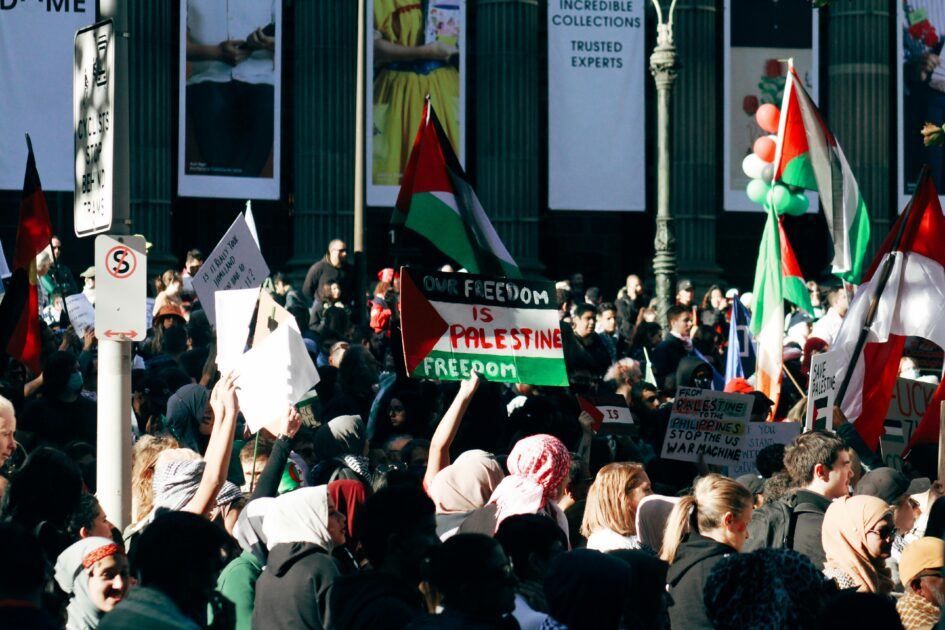






















































“Are we liberal imperialists who take a knee for antiracism when it’s fashionable, but fall silent when an ethnostate openly conducts a campaign of extermination?” Photo by Daniel Pelaez Duque.
The following remarks were delivered at the “Take Back Our University” Rally held at Cornell University on August 28, 2025.
We are witnessing a wholesale, systematic attack on black and brown people, at home and abroad, and, true to form, much of the white majority either stands by passively or actively colludes, willfully ignorant to the reality that Du Bois described in 1935: namely, that white nationalist reaction is disguised class warfare against the bottom 90 percent of society.
We knew the institutional commitment to racial justice was paper-thin. We knew the DEI regime was a bland half-measure that allowed higher ed to claim social relevance and moral legitimacy. But even the cynics among us marvel at how rapidly craven administrators dismantle the diversity apparatus through which the corporate university once signaled virtue. DEI was the cream smeared on the face of structural racism. Now that it is inexpedient, look how easily it evaporates!
Make no mistake: white supremacy is the force behind the colossal disrespect, the sheer contempt, to which this society and this university routinely subject black and brown people.
What the colonizer cannot comprehend is that white supremacy degrades us all. It convinces us that settler-colonialism is natural or inevitable. It assures us that the concentration camp is built for someone else. White supremacy is the reason we believe a Palestinian child is less precious to her parents than our own children are to us. It allows us to watch a little girl being vaporized on social media while we continue to insist that the situation is dreadfully complicated.
Palestinians, you see, lack the protections of whiteness that their colonizers have mostly acquired, to disastrous effect.
White supremacy says who is expendable. It tells us who may be massacred with minimal opposition. At the same time, it convinces us that drones over Gaza do not prefigure drones over our heads. And yet, imperialism boomerangs. Militarism comes home to roost. One experiments in Gaza to execute at home. Technologies of repression, tested abroad, are deployed against domestic enemies.
Those of us who have experienced colonialism, whose families have experienced colonialism, can never forget this. We know that ANY racialized slaughter is a prelude to our subjection.
Every time we accept the erasure or exceptionalization of Palestinians, we reaffirm a human hierarchy that we disavow in every other aspect of our lives.
What hypocrisy! We decry the targeting of immigrants on our streets while condoning the kidnapping, torture, and indefinite detention of scores of Palestinians. We condemn attacks on higher ed while ignoring the criminalization of students who have somehow found the temerity to oppose a holocaust. Indeed, we let a handful of soulless bureaucrats cast into exile our best and our brightest. (Imagine how utterly hollow you must be, how cowardly…
to keep rolling out new codes of conduct as the children of Gaza, desperate and hungry, are annihilated.)
We lament the growth of a police state on our own soil while denying the transnational and collaborative nature of authoritarianism. Somehow we forget that violations of due process and human rights are the very terms of colonialism and occupation. We fail to realize, until too late, that Palestine is the tip of the spear that now points at our hearts.
You don’t have to be an Ivy League professor to see the links between militarized checkpoints in Washington, D.C., and militarized checkpoints overseas. Perhaps it is precisely the status and privilege of such professors that keeps them from publicly acknowledging the connection.
Remember, fascism feeds on silence. You don’t have to bend a knee for it to thrive. Just shut your mouth. Truth is, ALL that we do here is tainted by genocide. The whole enterprise. Every exchange, in the classroom and beyond, occurs under the pall of institutional and personal complicity.
One is tempted to ask: who are we, really? Are we liberal imperialists who take a knee for antiracism when it’s fashionable, but fall silent when an ethnostate openly conducts a campaign of extermination? Are we self-absorbed scions of the professional-managerial class, destined to lead lives of decadence and indifference? Are we hirelings of the Pentagon and the weapons industry? Are we narrow careerists? Are we mercenaries? Because, if we’re just scared, then goddamn us. We deserve the hellscape that the billionaires are preparing for us.
It’s been almost two years. Starving children are foraging amid carnage and debris. For God’s sake. Do SOMETHING. A humanist acts not because she lacks fear, but in spite of it.
Our silence exposes us. It mocks our professions of enlightenment. It defiles our land acknowledgements and decolonial metaphors and “Be kind” lawn signs. Our hands are drenched in blood. Our hands are drenched in blood. It may not be too late to redeem ourselves, to salvage some modicum of decency and morality. But the sun is setting.
What would it mean to refuse? Refuse to participate. Refuse to lie. Refuse to labor. Today the challenge is simply to declare, collectively and unequivocally, that we are horrified. We are heartsick. We are ashamed. We are ready to act.
I’ll end with a message to the donor class and their retainers in Day Hall. Please understand that we will NEVER abandon the Palestinian people. Solidarity is more precious to us than prestige or rank or any of the petty rewards you may dangle before us. And now that we have found our voice, we cannot return to the shadows of docility and compliance.
Free Palestine. Free Congo. Free Sudan. Free Los Angeles. Free Washington, DC. Hands off Venezuela. Hands off Cuba. US out of Africa. Resist! Resist! Resist!
The post Take Back Our University! appeared first on CounterPunch.org.
This post was originally published on CounterPunch.org.
-












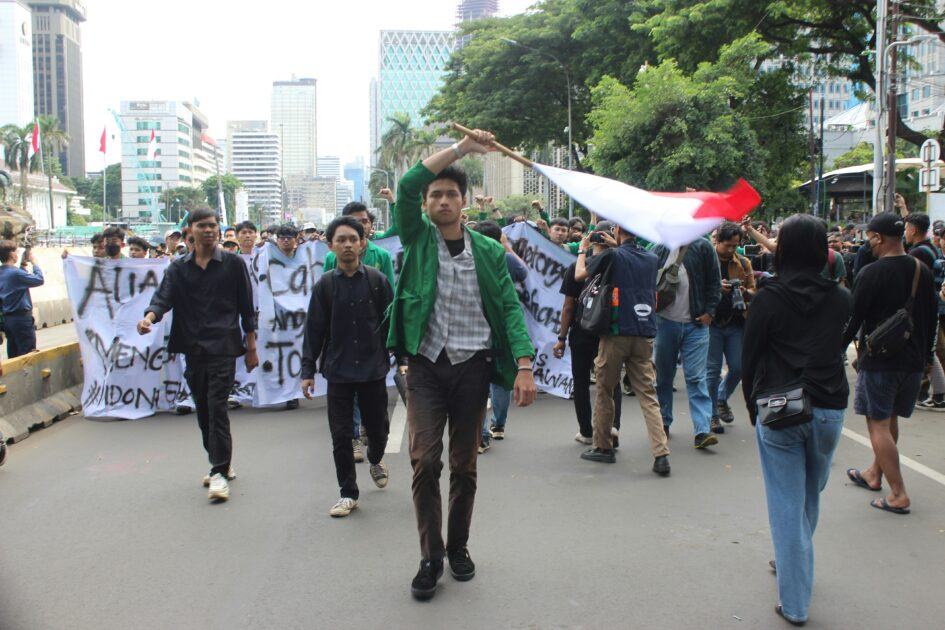






















































In Indonesia, there is fear that if militant protests continue, state violence may become even more murderous—photograph by Angiola Harry.
Less than a year after taking office, Indonesian President Prabowo Subianto is facing the most militant anti-government protests in years. Recent street actions are caused by the country’s incredible inequality and rule by an entrenched political class. Inequality in Indonesia is extreme, and the gap between rich and poor is widening. While the middle class is shrinking, the elite is becoming ever more wealthy, and arrogantly so. The parliament recently voted themselves a substantial hike in monthly housing allowances, bringing their total monthly income to over 100 million rupiah, more than $6000. Meanwhile, the average monthly wage for workers in February 2025 was 3.09 million rupiah, less than $200. The country’s unemployment rate hovers at 15%, more for youth, the highest in Southeast Asia.
On Thursday morning, August 28, labor unions peacefully assembled outside the parliament building to call for higher wages, tax reform and adherence to existing labor laws. After workers dispersed, students surged around the building, demanding cancellation of politicians’ new housing allowances and dissolution of parliament. That night, Affan Kurniawan, a 21-year old Ojek driver (an online motorcycle delivery/taxi service) was run over and killed by a 14-ton police water cannon and riot control vehicle. A co-worker suffered a broken leg.
Dismissed from his role as one of the most powerful generals 30 years ago for his involvement in the disappearance of pro-democracy student activists, president Probowo now claims to be ‘shocked and amazed’ by the death of the Ojek driver. He urges calm and ordered an investigation into ‘ethical’ issues related to Affan’s death. The sudden eruption of militant actions across the peninsula compelled him to visit the family of the slain driver and promise that the government would support them for their lifetimes. Affan’s funeral procession was made up of hundreds of green uniformed Ojek motorcycle drivers.
These marginalized workers daily come face to face with Indonesia’s stark inequality. They routinely pick up food at luxurious malls and deliver it to middle-class homes. Their financial situation is so precarious that on December 8, 2024, Darwin Mangudut Simanjutak starved to death in Medan as he waited for a customer’s order. The night before he died, he had complained to a friend that he hadn’t eaten because he didn’t have any money. Six months later, on May 20, 2025, thousands of drivers who worked for the Gojek online platform took to the streets in 18 cities. The Indonesia Online Drivers Union reported that at least 12 of their members had died due to fatigue because workers sometimes were on the job 18 hours per day. These drivers represent thousands of others who have been denied the benefits of the country’s economic development. For years, they have struggled to get improvements to their wages and conditions only to suffer from recent tax increases and wage reductions.
Despite the president’s appeal for calm, people refused to obey. After Affan’s killing, ‘Pembunuh’ (murderer) graffiti suddenly appeared on the streets of many cities. A leading student organization called on all citizens to join them in the streets, noting that, ‘An institution that should protect has turned into uniformed executioners, trampling the dignity of civilian citizens.’ On Friday, August 29, rallies and protests were organized across the archipelago. Regional parliament buildings were set afire and the national parliament in Jakarta was surrounded and besieged. More than a dozen bus and subway stations were destroyed, as were highway toll booths and carefully selected police buildings. The basement and first floor of a large police headquarters in East Jakarta was heavily damaged by fire. Hundreds of protesters massed outside the headquarters of the Jakarta Police’s elite Mobile Brigade (Brimob), the unit blamed for Affan’s death, throwing firecrackers as police responded with tear gas. A determined group of protesters, screaming ‘Pembunuh,’ tried to tear down the gates of the notorious unit, and pulled down a sign from the building’s exterior. Protests spread to other major cities, including Bandung in West Java, Semarang in Central Java, Surabaya in East Java and Medan in North Sumatra. In Yogyakarta, people besieged the regional police headquarters for five hours. Several government vehicles, a police service center, and a traffic post were set afire. Water barriers were attacked as well, forcing closure of the northern ring road.
The next day, Saturday, August 30, people’s anger continued to be expressed. Large buildings containing the regional parliament and city council in Makassar, Sulawesi went up in flames. Three government workers were trapped in the buildings and jumped to their deaths from the third floor. Another person was mistaken for a police spy and perished after being attacked by a crowd. In Solo, former President Jokowi’s hometown, the parliament building was also torched. In Jambi, the vice-governor’s official residence burned. In Martaram, protesters set on fire the massive regional parliament. Across the country, dozens of motorcycles, cars and buses were burnt.
At a televised press conference on August 30, the head of the country’s police and the army commander refused to apologize for the murderous state violence. Instead, they blamed anarchists. By dawn, stunned citizens observed dozens of burnt shells of cars surrounded by rocks and bottle fragments in many urban areas. As television news teams surveyed the damages from the street fights, their headlines uniformly declared, ‘anarchists harm the public good.’
Elite Arrogance Spurs Popular Response
After students called for the dissolution of parliament, Ahmad Sahroni, an influential member of parliament, called that perspective ‘a foolish mentality…That kind of person is the most stupid person in the world.’ After Sahroni repeated his remark, he left for Singapore. While he was gone, hundreds of outraged people surged into his private residence. They looted it while soldiers stood by, pleading with people not to burn the house. The army watched as people carried away the bathtub, refrigerator, washing machine, furniture, and expensive designer bags. A watch valued at more than $300,000 was among the appropriated items. Liberated dollars and rupiah were thrown into the air for all to share in the expropriated cash.
Eko Patrio, another member of parliament and a popular social media influencer, served as DJ for a dance party in parliament after pay raises were enacted. His outspoken celebration led people to converge on his residence. He engaged the protesters, claiming ‘everybody makes content.’ After he left for China, his residence was looted. People also streamed into the house of Finance Minister Sri Mulyani and Uya Kuya before taking all their belongings.
Crass public statements made by leading Indonesian government officials have continually made news. When a journalist asked minister of human development Pratikno about a large worm killing a young child, he publicly laughed out loud. Pratikno pointed to his ‘tired eyes’ before breaking into laughter. The five-year-old child named Raya had been diagnosed with tuberculosis. Once in the hospital, a worm began to come out out her nose. After she died, tapeworms weighing approximately one kilogram were found inside her body. The country’s minister of health later claimed infection, not worms, were the cause of death.
Although no one knows what will happen next, clean-up crews work at a feverish pace to clear streets of burnt out vehicles and to repair public transportation infrastructure. Of more than 500 people injured, dozens are still hospitalized, according to Street Paramedics Organization. Negotiations are underway for the release of more than 600 arrested people and for punishment of police involved in the killing of Affan. One eyewitness to Affan’s murder publicly stated that the Brimob vehicle ‘suddenly sped through the middle of the road without paying attention to the gathered crowd.’ Officials have detained seven Brimob officers for ‘ethical’ questions in connection with the driver’s death. Not surprisingly, government investigators have yet even to determine who was behind the wheel.
Political reforms of little consequence to the poor have been swiftly publicized. Probowo suspended the new housing allowances. Eko has been suspended as secretary-general of National Mandate Party (PAN). Apparently the final straw came after people criticized parliament members dancing to celebrate their housing allowance raise. Eko posted a video mocking people angered by the dancing. Ahmad Sahroni was also suspended from parliament by his NasDem Party, mentioning his statements ‘have offended and hurt the feelings of the people.’ Another party member, Uya Kuya, was shown dancing over a caption reading, ‘just dance with it, you guys thought that Rp3million a day was a lot.’ She was also suspended.
New repressive measures have also been enacted. Probowo warned that the protests could be considered ‘treason and terrorism.’ Three newly created mobile patrols of hundreds of heavily armed police now roam Jakarta. The country’s police chief ordered his officers to shoot with rubber bullets anyone who enters Brimob headquarters. The University of Indonesia has suspended all in-person classes and replaced them with online formats for at least the next week. At the same moment, preliminary reports indicate that protests continue to erupt across the archipelago.
Clearly, recent street actions and looting have stoked fear among the elite and middle class. The uprising has also provided new energy and pride to Ojek drivers and marginalized citizens, a palpable change that could be one of its most important outcomes. Prabowo canceled a trip to Beijing, where he had long planned to attend a summit of leaders of countries opposed to US imperial actions. While he has expressed sympathy for Affan’s family, he has also promised that firm responses will meet ‘anarchist acts,’ damage to public facilities, and looting of public and private properties. Many people fear that if militant protests continue, state violence may become more murderous.
The post Inside Indonesia’s Growing Class Struggle appeared first on CounterPunch.org.
This post was originally published on CounterPunch.org.
-









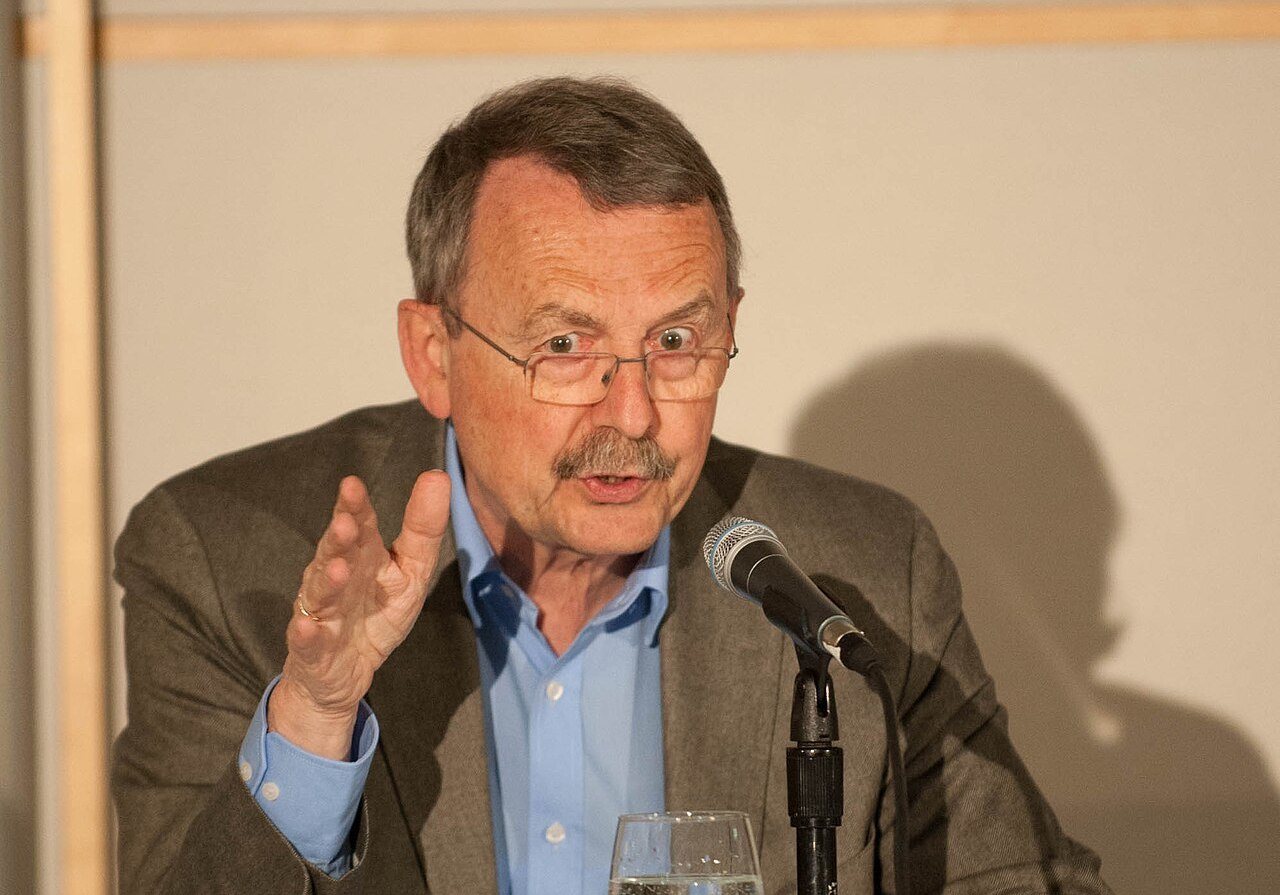


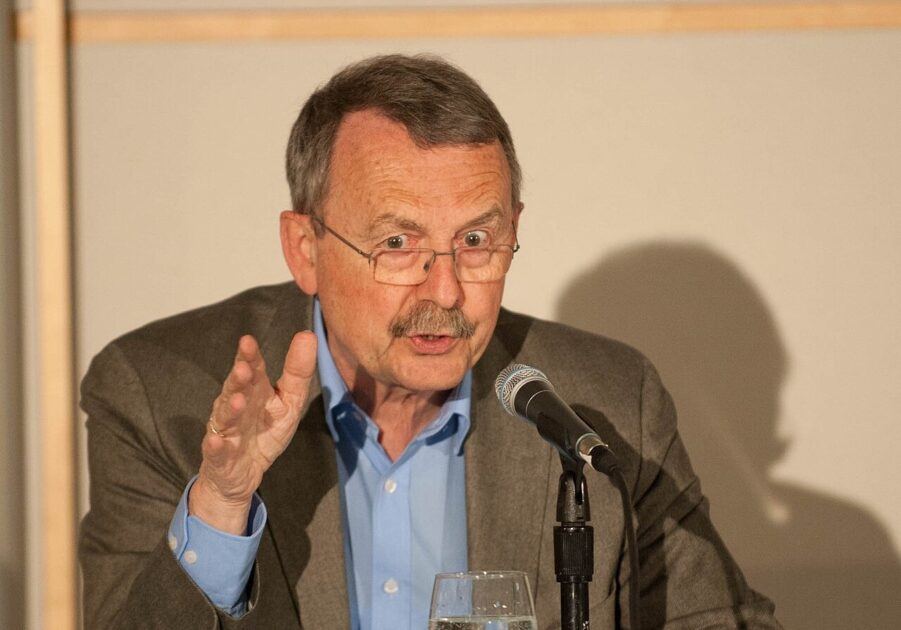






















































How Will Capitalism End: Reflections on a Failing System – A Lecture by Wolfgang Streeck. Tuesday, April 4, 2017. Photograph Source: Center for the Study of Europe Boston University – CC BY-SA 2.0
Wolfgang Streeck, director emeritus of the Max Planck Institute for the Study of Societies in Cologne, is in the front ranks of Europe’s social thinkers, having come out with some of the most penetrating analyses of the crises of neoliberal economics and the ills of neoliberal society over the last 30 years. No stranger to controversy, he has criticized the technocratic elites in Europe and the United States for placing adherence to so-called “universal values” rather than the democratic process as the basis of the right to rule, called for an end to Europe’s subjection to the United States, dismissed the Russian threat as a fiction manufactured by the Baltic states, and called for the transformation of Europe and the global order into systems of small states. Though a man of the left, he has distanced himself from both the German Social Democratic Party (SPD) and Die Linke (The Left Party) on matters of peace, immigration, and social policy and become identified as a strong supporter of the party (BSW) of the controversial Sahra Wagenknecht in the lead-up to the 2025 Bundestag elections. His latest book is Taking Back Control? States and State Systems after Globalism (2024)
Trump: Purveyor of Chaos and Uncertainty
WB: Let me turn to another issue. What do you think is going to happen with Trump and Europe?
WS: Before I address that issue, let me say that we have, in Germany, 40,000 American troops, the same as Okinawa. In addition, we have an unknown number of American nuclear warheads stationed in Germany. In Ramstein and Wiesbaden, we have the two most important command centers of the American military apart from the Pacific. Anything that is being done in the Middle East is being done out of the American military command in Wiesbaden, Germany. So, German foreign policy must always be seen in this perspective. And we have a political elite that over decades has been trained that Germany on its own cannot do anything unless the United States supports us.
Now to Trump, I’ve never been in a situation where it’s so difficult to make predictions. As a leader this man is a source of chaos—chaos means you don’t know what’s going to happen next. For this reason, one needs to look at the deep state in the United States. Trump is sitting on something. That something is the biggest military in the history of mankind and the biggest espionage and sabotage operation. In Europe, the two former fascist countries that were defeated in the Second World War, Germany and Italy, are still basically occupied by the United States. By the US military. Will they leave if Trump tells them to? I don’t think so. What they’ve dug into the ground in terms of technology, you can’t even speculate on this sort of thing. But there must be billions and billions worth of high technology on German soil, or underground. Will they pull it out? Career opportunities in the U.S. military have to do with their 750 military bases around the world. 750! If Trump is thinking about making “America Great Again” by rebuilding American society, finally building decent high schools and finally getting a decent health care system in place and ending the drug epidemic, then he would have to bring these people back into the real life on the American ground. They would have to learn to be decent policemen or decent doctors. Can you imagine this? This is what I think what Trump will have to get done to keep himself in office if MAGA is about the United States as a society rather than an empire.
WB: Let’s talk a bit about the deep state and how there might be dissatisfaction there with Trump’s policies. Do you think there are people in the US military who would be willing to move against Trump?
WS: It’s hard to think about someone in the U.S. military who would want to become a dictator. But J.D. Vance might fit the bill. To me he seems like someone who’s both very intelligent and absolutely ruthless. There’s a procedure in the American constitution, the 25th Amendment, to declare the president incapable. The procedure has to be started by the vice president. If he can convince the Speaker of the House and the Senate Majority Leader that Trump is mentally incapable, according to the constitutional procedure for removing the president from office if he’s no longer mentally fit, he might do it. Then he will be president.
Will Capitalism Again Reorganize Itself through War?
WB: Do you see the relations between Europe and the US as irreversibly deteriorating?
WS: When Trump came in during his first term and also at the start of his second term, there was this sense that European countries must have a common foreign policy and security capacity because the United States will leave. Then in a very short time, we had the NATO chief sucking up to Trump. From one extreme to the other. My view is that we need to have something different from both a United States of Europe and from Europe as a trans-Atlantic extension of America. In recent writings I have tried to point out the difficulties involved in both extremes, in order to really understand what Europe is and where it should go.
But before discussing that, let me share my biggest nightmare, which is capitalism reorganizing itself through war. Capitalism, in fact, has again and again organized itself through war. Capitalism was reorganized when the Dutch took over from Genoa and the center of capitalism moved from the Mediterranean to the Atlantic, then the British defeated the Dutch and the center moved to London, then came the First World War which destroyed the old quasi-feudal European empires, replacing them with the modern nation-states, after which came the chaos of the 1930s, when Britain could no longer maintain world order while the United States still refused to do the task, leading to the Second World War, which saw Germany and Japan become allies, each seeking their own “zone of influence,” modeled after the Monroe Doctrine, then the postwar settlement—the second after 1918—which gave rise to the bipolar order and the colonial wars of liberation, and finally the end of the Cold War—without bloodshed only because of the wisdom of Gorbachev—making the United States the new hegemon, bringing in three decades of neoliberalism—George H. W. Bush’s New World Order—which is now in ruins. Around which power, or powers, will capitalism reorganize itself this time? And will it, once more, be reorganized by war? There are just two candidates, the United States and China.
What is frequently being discussed in the United States is the scenario Thucydides gives when trying to account for why Athens, the leading power of its time, lost the Peloponnesian War. As he recounts it, Athens was defeated by Sparta because it didn’t strike early enough, when it still had the strategic advantage. It watched the new hegemon rise until it was too late, Sparta having become too strong to be defeated. Note the ambivalence in Trump’s posture in relation to China. Sometimes he sounds very warlike, sometimes you’re not so sure. If Trump told an American military planner today that 10 years from now the United States would probably have to go to war with China, the answer might be that this would be too late because the Chinese would by that time have become too strong. So, the army might prefer to do the job now. Europe would inevitably be dragged into this conflict, unless it takes steps now to move away from its dependence on the United States.
Europe’s Crisis and the German Question
WB: So where is the thinking among European elites on this question?
WS: Since German unity in 1990, the rhetoric was always that Germany must accept its responsibility and act as the leading country in Europe. What this meant, however, was that Germany would pay the costs of keeping Europe together, but that being the leader did not mean telling others what to do. And that led to Merkel in particular, always hiding behind other countries, especially France.
The present German government, under Friedrich Merz, the new chancellor, has changed the tone. Now the rhetoric is about Germany as Europe’s most powerful nation. What this really means is that they actually want to lead, not just to pay. This makes for conflict, certainly with France. For the French always saw the Europe of the European Union as being led by a tandem, with them steering and the Germans sitting at the back. Now, things seem have to become different. Recently, someone suggested that one reason why the current German government has taken on such a lot of debt is to preempt Italy and France from getting their way by allowing the EU to take on debt on their behalf and with the Germans providing the de facto collateral. If the EU would now acquire debt on a large scale, interest rates would become prohibitive. Generally, I think that the new German leadership under Merz now aspires to a leading role of Germany in EU and Europe beyond just picking up the bill, basically out of political necessity, to avoid having to act in the interest of others instead of its own interest. In a longer perspective that points to Germany as the hegemon of the Western European state system in a multi-polar world.
My view, as I have said several times, is that Germany does not have the military capacity to support this kind of project. Since the 1960s, when France set up the Force de Frappe, the French governments have always had a deal in mind along the following lines: their nuclear force is expensive, so if we promise to extend our nuclear deterrence to the defense of Germany, Germans can pay for some of it. Since they don’t and can’t have a nuclear force, they have enough money to pay for a strong conventional army, the opposite of the French situation. There were several efforts by France to set up a deal like this, and Germany was sometimes willing to entertain something like it, paying part of the costs of the Force de Frappe in exchange for French nuclear protection. But when the Germans asked for the target catalogue for the French nuclear missiles, they heard that targeting had to remain a French prerogative as a sovereign nation. The problem behind this was that most of the targets were in Germany, since the idea was to stop the Russian army from getting to France, and where you stopped them was and could only have been in Germany. So, they never even came close to a deal, and this reinforced the dependence of Germany on the United States.
Interestingly, the new floor leader of the CDU in the Bundestag recently raised the question of whether Europe would need a nuclear umbrella of its own and where Germany would fit in this. If my memory serves me right, this had not been discussed since the 1960s. He repeated in an interview that Europe would need its own nuclear capacity but left unanswered who would be in charge of the nukes, saying it was still a problem that needed a solution and going on to propose something completely ridiculous like in the likelihood of war, countries could draw lots. Can you imagine giving Giorgia Meloni or Marine Le Pen the nuclear trigger? So, the implication is, if you can’t have a European nuclear weapon, then it has to be a national nuclear capacity for Europe, and if you don’t want it to be a French one, then Germany is the obvious candidate to develop this.
Is Russia the Enemy?
WB: Let me go to the question of Russia. Is Russia the enemy?
WS: No, I don’t see that. The official rhetoric in Europe is that Russia is the enemy, and that in five years’ time, the Russians will be ready to march on Europe. Now this is a picture that is above all spread by the Baltic states. The three Baltics countries are very small. They need someone else to fight their wars for them, and this can only be the Germans. They had tried this alliance in the last world war, and it did not end very well for them. They, in fact, wanted German protection so much that they armed several SS regiments fighting Russia under German command and assisted the Nazis in the persecution of the local Jewry. Very much like Ukraine.
Realistically, it seems totally ridiculous to think that Putin would want to conquer Germany or any other West European country. In principle they can sell gas and oil and other resources to the West Europeans and prosper. Why should they want to rule Germany or, for that matter, Finland, if they have a hard time ruling their own country?
One reason why the Baltics are so excited is that they have sizeable Russian minorities that some of them treat very badly. The tensions with Russia might be more manageable, without these immense preparations for war, if the Russian minorities would be given full citizenship and language rights and federal autonomy. That would mean they would no longer call on Moscow to help them against their governments. The worse they treat their Russians, the more Moscow might feel forced to do something for their compatriots. It is up to the Baltic states to decide how much pressure to put on their Russian minorities so that at some stage they will turn secessionist or irredentist. Instead there are wild dreams about getting the West to defeat Russia for the benefit of the smaller nations on the Russian periphery. For example, Kaja Kallas, the former Prime Minister of Estonia, who is now responsible for the foreign policy of the European Union, is said to have once suggested that Russia should be sliced up into four or five different states, and that only then will Europeans—that is, the Baltics—be safe. This, of course, has been tried before, and it turned out a disaster, including costing the lives of 15 million Russians alone. I claim that a safe life in Europe and in Germany is only possible if we find an arrangement to coexist in peace with Russia on the Eurasian continent, and this is linked to the bigger question of where Europe should go.
Is Another Europe Possible?
WB: And where is that?
WS: Europe is a collection of old societies and states, and the idea that someone can come and merge this into one, either a United States of Europe or as a trans-Atlantic extension of America—that is a very mistaken idea. So, my view is that if we can talk the Baltics out of dragging us into a war with Russia, we need to move into something that is both realistic and good for everyone.
That is, European countries cooperating voluntarily, and extending their freely chosen relations to the rest of the world. Nowadays, logistics are much easier than the 1930s. Germany, or other European countries, could develop amicable relationships with places like the Philippines or South America, or whoever. We could deliver things these countries urgently need, take desalination plants for example, and they could deliver things to us that we need. So, if different European countries on their own initiative, moving together with other European countries that have similar interests, could strike up relations with countries on the Southern side of the world, but also inside the continent of Eurasia, in particular with Russia, that would be something. In this context, we must deal with Russia in a positive way. In a Eurasian perspective, the old idea from Gorbachev to Yeltsin to Putin, “a zone of peace and prosperity from Vladivostok to Lisbon,” if that could be constructed, then we could see the end of our dependence on the United Sates, a dependence which partly depends on resources, since Russia has all the resources the Americans have. There will, of course, be security issues, but there needs to be shared security, with arms control, disarmament, confidence-building measures—none of this is new. If we manage to have a stable system of international security in Eurasia, the Americans can go wherever they want, hopefully in peace. Is that an illusion? I don’t know but if you ask me, what could be a positive legacy for our children and grandchildren, I’d say something like that.
The post Is Another Europe Possible? appeared first on CounterPunch.org.
This post was originally published on CounterPunch.org.
-









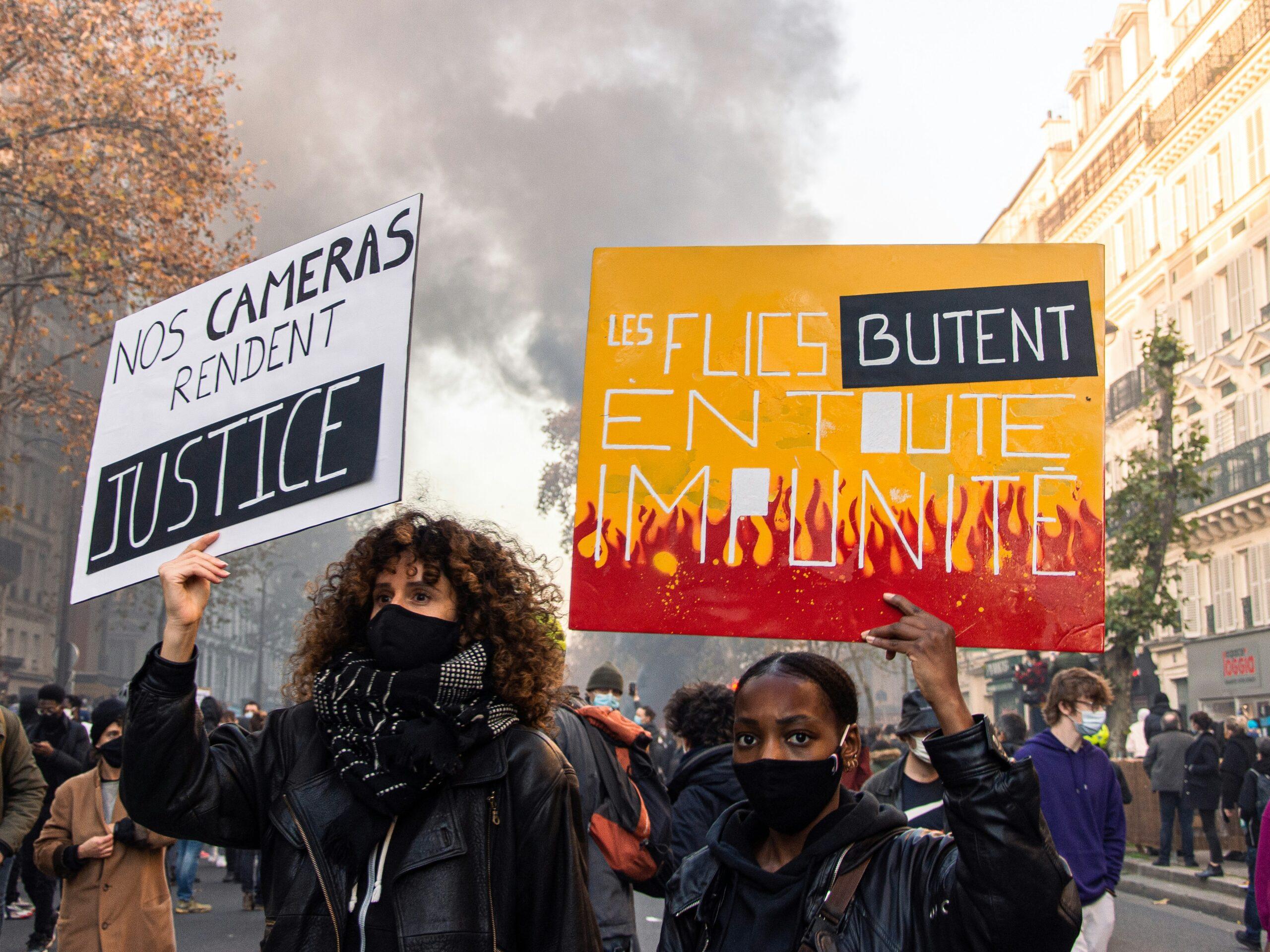

























































Image by Koshu Kunii.
I have spent the bulk of my career — on and off since the late Carter Administration — following the money that drives war and repression. What I have finally learned after so many decades of doing research on the war machine is that while research is critical, it must be in the service of a smart strategy backed by a lot of hard work by organizers from all walks of life.
My interest in using research to promote social change was sparked by my years at Columbia University in the 1970s, when I was a researcher and advocate in the divestment movement targeting the apartheid regime of South Africa and a participant in other social justice movements like the boycott in support of the United Farmworkers Union and the opposition to the Pinochet dictatorship in Chile.
Henry Kissinger’s justification for the U.S.-backed coup in Chile that put Augusto Pinochet in power still sticks in my mind: “I don’t see why we need to stand by and watch a country go Communist due to the irresponsibility of its own people.”
So much for the land of the free and the beacon of global democracy.
The U.S. role in the coup was eventually recounted by many media outlets, but for me the first and most important was the North American Congress on Latin America (NACLA), which devoted several issues of its magazine, then called The Latin America and Empire Report, to the origins of the coup, including the role of U.S. corporations. I was so impressed with their research and commitment that I applied to work at NACLA after graduating from Columbia in January 1978. They wisely demurred, since my background on Latin America was largely limited to what I had read in their own reports. Still, their skill in deploying detailed research to debunk the official lies that surrounded the coup stuck with me.
Research Against Apartheid
My real schooling in research, however, came in the anti-apartheid movement, starting with the divestment campaign at Columbia and expanding into my work with national anti-apartheid organizations like the American Committee on Africa (ACOA). Again, research was front and center. In order to make effective demands for divestment, we needed to know which companies were supporting the apartheid regime, and which of those companies our universities held stock in. ACOA was of great help in this, including through Richard Knight, who worked in a back room of their offices at 198 Broadway and had what may well have been the messiest desk in the history of progressive politics. But if my memory serves me correctly, he seemed to be able to remember exactly where he put a given document in one of the many piles of paper that obscured his desktop. The work he did, along with colleagues at ACOA, helped fuel the student divestment movement, along with research by students on campuses around the country.
Another key group at that time was Corporate Data Exchange (CDE). Tina Simcich, who worked at CDE and was also part of the New York Committee to Oppose Bank Loans to South Africa (COBLSA), did the definitive research on which banks were lending to the apartheid regime.
At Columbia, we made an interesting discovery that put the lie to the university’s position on divestment. In response to demands to divest from firms involved with the apartheid regime, university leaders argued that, if there were objections to the actions of companies they were invested in, they felt it would be more productive to support shareholder resolutions seeking to change their conduct than to divest from those companies’ stocks.
But after digging around in past Columbia University documents, we found a memo from a prior year in which the university had responded to a request to support a shareholder resolution on behalf of trade unionists in Chile, some of whom had been murdered by the Pinochet regime. The university’s position then proved to be precisely the opposite of what it said just a few years later when asked to divest from companies involved in South Africa: they didn’t think it was productive to engage in shareholder resolutions. If there was an ethical issue with one of their holdings, their preference was to divest from the stock of that company.
Although it was a small instance of hypocrisy, it was nonetheless revealing. At that point, the university had been determined to do absolutely nothing to hold companies that were complicit in repression accountable. Our divestment campaign of the mid-1970s did not succeed, but in 1985, another cohort of student activists did finally persuade Columbia to divest. The next year, in 1986, Congress passed comprehensive sanctions on South Africa, overriding a veto attempt by President Ronald Reagan.
Obviously, research was only partly responsible for our success. It was research in the service of organizing and sound strategy that won the day. The fact that the liberation movements in South Africa, including the African National Congress and the Black Consciousness Movement, were calling for divestment greatly strengthened our case. And inspiring organizers and speakers like the incomparable Prexy Nesbitt and the late Dumisani Kumalo, a South African exile who went on to be liberated South Africa’s first representative to the United Nations, played a huge role, as did thousands of campus activists, religious leaders, trade unionists, state and local officials, and heads of pension funds.
Eight years later, in 1994, Nelson Mandela was sworn in as the first president of a free South Africa. The vast bulk of the credit for that historic change goes to the people of South Africa, but the divestment campaign and the larger global boycott of the apartheid regime played an important supporting role, a role much appreciated by activists in South Africa.
As for me, my work in the anti-apartheid movement shaped my career. I worked for a while as part of the collective that put out Southern Africa magazine, an independent journal that supported the anti-apartheid movement and the liberation movements in Southern Africa. The original editor was Jennifer Davis, the brilliant exiled South African economist who went on to direct ACOA. I wrote articles about the divestment campaign, violations of the arms embargo on South Africa, and the role of U.S. firms in propping up the apartheid regime. The skills and values I learned there were far more important to my career than my philosophy degree from Columbia, an institution whose leaders have now covered themselves in shame by cracking down on students speaking out against U.S.-financed Israeli genocide in Gaza.
The Impact of ‘68
Our work against apartheid was inspired in part by the generation of 1968, whose research exposed the role of companies fueling the war in Vietnam, including Dow Chemical, which produced napalm that was used to kill and maim untold numbers of people. We were also influenced by publications like “Who Rules Columbia,” as well as a handy publication on how to research the corporate ties of one’s university, published by the ever-relevant and crucial NACLA. And groups like National Action Research on the Military-Industrial Complex (NARMIC) were invaluable for peace activists from the anti-Vietnam War period onward.
Other influences on me from that generation of researchers and analysts included Michael Klare, whose reports and books like Supplying Repression, War Without End: American Planning for the Next Vietnams, and Rogue States and Nuclear Outlaws: America’s Search for a New Foreign Policy were foundational in forming my understanding of U.S. military spending and strategy. And my perspective on the domestic factors driving Pentagon spending began with The Iron Triangle, written by my friend and mentor Gordon Adams (now Abby Ross).
The Corporate Role in Fueling Genocide in Gaza
Activists pushing universities to divest from companies profiting from Israel’s war in Gaza have made connections with the earlier generation of researchers described above, from webinars with members of NARMIC to essays that link to documents like “Who Rules Columbia?”
A key organization in the middle of current efforts is Little Sis — a powerful research organization whose name is based on the idea that they are the opposite of Big Brother. They facilitate research and make connections on a wide range of issues, but at this moment one of their most important products is a webinar they did with Dissenters, a youth anti-militarism group based in Chicago, on how to research the corporate ties of universities. It’s a tutorial on researching university ties to war profiteers, going well beyond the issue of stock holdings in arms makers to look at the connections of trustees, financial institutions, and other relevant ties to weapons makers.
Groups of dedicated students within the ceasefire and anti-genocide movements on U.S campuses have done excellent work in researching the corporate ties of their own universities. I appeared on Santita Jackson’s radio show in February 2025 and connected with Bryce Greene, a student at the University of Indiana involved in the ceasefire/Gaza movement there. He and his fellow students were researching the military ties of the university and they wanted me to review their research to see if they were missing anything. As it happened, they had dug up far more information than I would have, in part because of local connections. Their biggest find was related to the university’s ties to the Naval Surface Warfare Center (NSWC), Crane Division, which provides technical support for everything from missile defense systems to Special Operations Forces. University professors had gone back and forth between Crane and campus, and Crane had a direct presence at the school. Students then started a “keep Crane off campus” campaign.
Researchers focused specifically on Israel/Gaza include the American Friends Service Committee, which has a web page on “Companies Profiting from the Gaza Genocide,” and No Tech for Apartheid, which, among other things, reaches out to workers at Google and Amazon to encourage them to take a stand against technology from tech firms going to support the Israeli war effort. One of the most valuable current resources is the United Nations report, “From the Economy of Occupation to the Economy of Genocide,” produced under the supervision of Special Rapporteur Francesca Albanese, which describes its purpose this way:
“This report investigates the corporate machinery sustaining Israel’s settler-colonial project of displacement and replacement of the Palestinians in the occupied territory. While political leaders and governments shirk their obligations, far too many corporate entities have profited from Israel’s economy of illegal occupation, apartheid and now, genocide. The complicity exposed by this report is just the tip of the iceberg; ending it will not happen without holding the private sector accountable, including its executives.”
Models of Research and Strategy
The most effective current model for using data to shape the debate on security issues is the Costs of War Project at Brown University. Their work on the costs of America’s post-9/11 wars ($8 trillion and counting), the number of overseas U.S. counter-terror missions, the cost of U.S. military aid and military operations in support of Israel (over $22 billion in the first year of the war in Gaza) is routinely cited in the press and by political leaders, and provides fuel for activists in their writing and public education efforts.
The best current example of merging research, organizing, and strategy is the new Poor People’s Campaign, co-chaired by Reverend William Barber of Repairers of the Breach and Reverend Liz Theoharis of the Kairos Center. Their campaign was inspired by the effort of the same name announced by Martin Luther King Jr. in November 1967. King was assassinated before his campaign came to fruition, but the National Welfare Rights Organization (NWRO) and other groups picked up the work of making its signature event, The Poor People’s March on Washington, happen.
One of the bedrock principles of the current Poor People’s Campaign is that the people most impacted by poverty should lead the movement. But cultivating such leadership, especially among those who have been excluded from the halls of power and influence for so long, requires an ongoing process of research, education, and training. Theoharis, director of the Kairos Center and co-chair of the Poor People’s Campaign, underscores this point in her new book on the history of poor people’s organizing, co-authored with Noam Sandweiss-Back:
“Without a continual process of learning, reflecting, and growing intellectually, our organizing is reduced to mobilizing, an exercise in moving bodies without supporting existing leaders and developing new ones . . . mobilizing people is important, but when it becomes our sole focus, we sacrifice long-term power for short-term action.”
As Theoharis notes, King made a similar point in Where Do We Go From Here?:
“Education without social action is a one-sided value because it has no true power potential. Social action without education is a weak expression of pure energy… Our policies should have the strength of deep analysis beneath them to be able to challenge the clever sophistries of our opponents.”
In the midst of the torrent of lies and repressive practices emanating from Washington, the use of research to guide strategy and support organizing is more important than ever. But as the Trump administration stops collecting some kinds of data and destroys other kinds altogether, the job of research will be ever more difficult. That can be partially compensated for by drawing on the collective knowledge of researchers, organizers, and community members alike, taking our lead from people who are on the front lines of dealing with repressive policies.
Occasionally, when I am giving a talk on how to reduce the influence of the war machine, I point out that, if there were not people organizing for change, my research would be little more than a peculiar hobby. That is only a slight exaggeration. We need to bring together researchers, organizers, and strategists, taking our lead from members of impacted communities, to work in partnership against the challenges we now face on a daily, at times hourly, basis.
This means the content of our work may take different forms. Rather than reports and briefings, we may need to rely on music, storytelling, art, and ritual to share insights on the political terrain and tales of resistance and revival in these times of escalating crisis. This may become even more to the point as traditional forms of protest continue to be criminalized.
We have a rich history to guide and inspire us, but the task is ours.
The post The Role of Information in Building a New World appeared first on CounterPunch.org.
This post was originally published on CounterPunch.org.
-









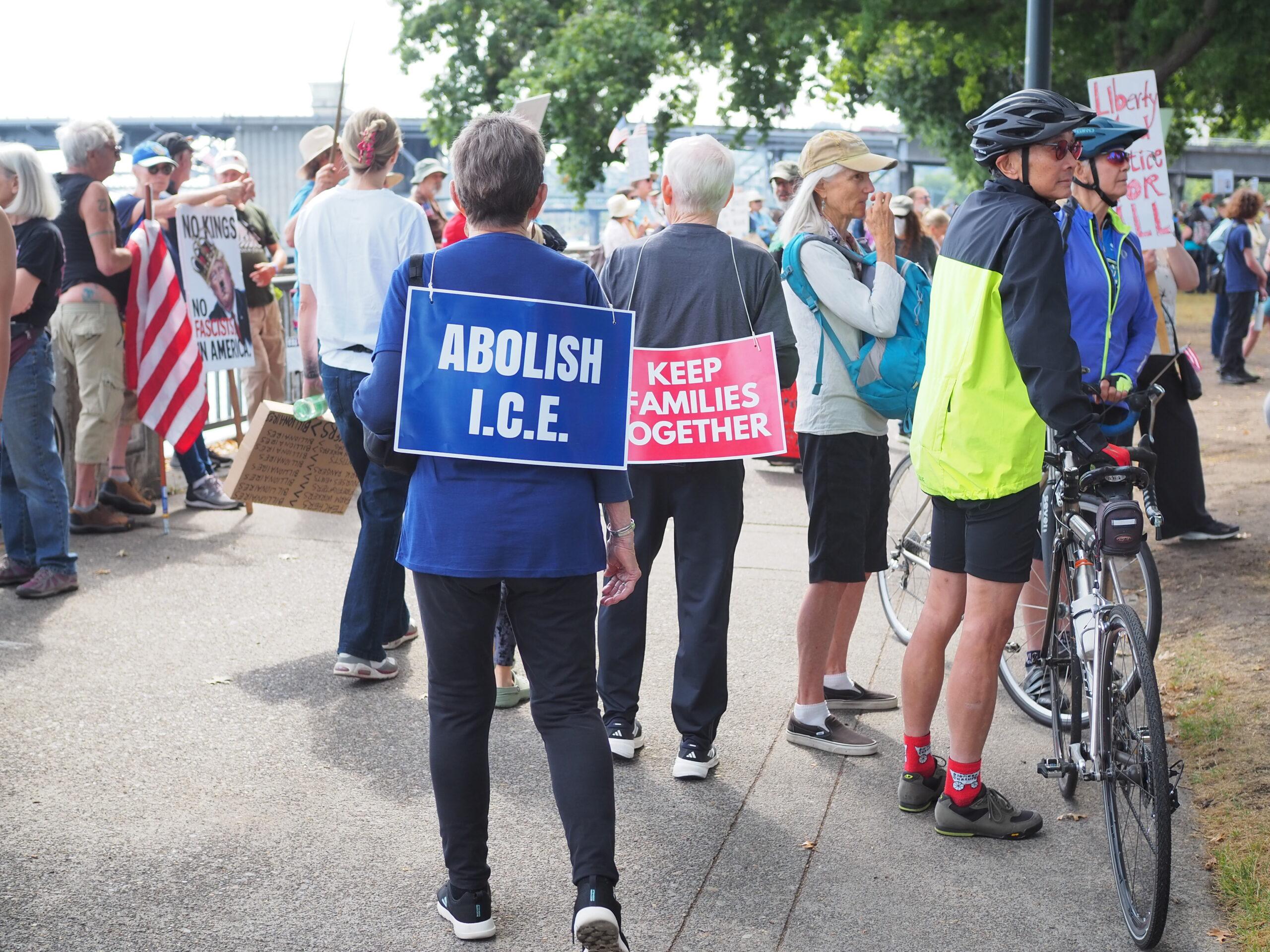


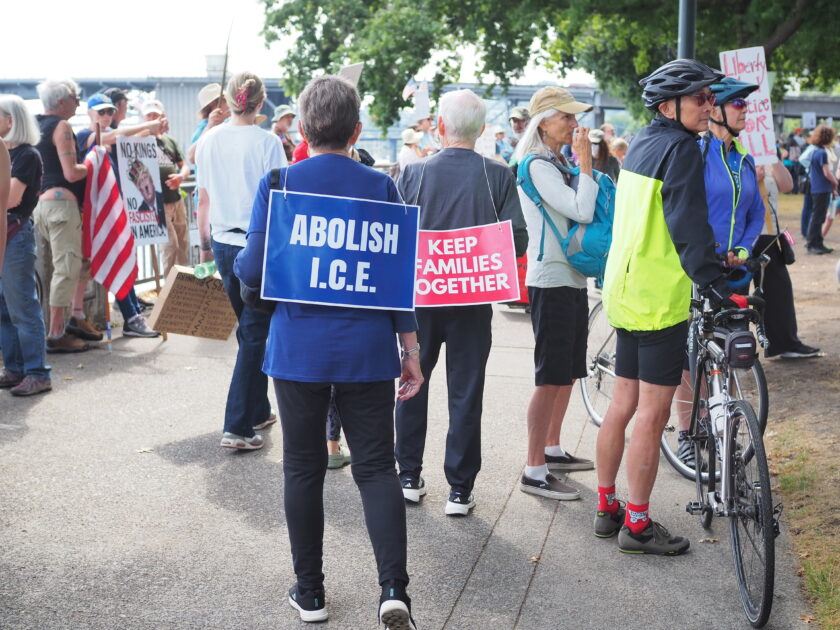

































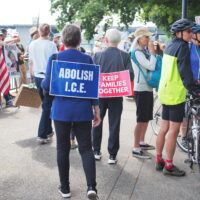




















Photograph by Nathaniel St. Clair
When it comes to for-profit, private corporate incarceration of immigrants, making lots of money is like drinking salt water, the more they drink, the thirstier they get. Roman proverbs say that the more money a rich man has, the more driven and addicted he becomes to accumulating even more money. Wealth addiction is at the root of giant private prison corporations domination of the U.S. government as communities take a back seat to the need for private profit. Many government leaders from both political parties share the same ‘profits over people’ ideology. The industry is preparing for explosive growth. On recent earnings calls, CoreCivic executives announced plans to triple the number of beds in their facilities within a few months. That would mean an additional $1.5 billion in revenue for the corporation, more than doubling its annual earnings. The U.S. private incarceration system is a deeply entrenched network of public-private partnerships that make billions from incarceration and detention every year.
Just like large. private health insurance corporations, the U.S. private-profit incarceration system has the inherent tendency to invent new needs, disregard all boundaries and turn everything into big profit. Limitless greed for money becomes a disease where a person may become over-saturated with food….but no one or private prison corporation ever has enough wealth. Wealth addiction is a greedy compulsion to obtain more and more wealth, and specifically obtain what belongs to others. The effect is to injure others because it is adversarial/harmful to society as a whole..The private prison industry pushes for harsh immigration policies intended to drive up immigration detention. And private immigration detention centers suffer from many of the same problems as private prisons and jails, but the people held in them have even fewer rights and thus, at times, can suffer even more abuse.
What is Private Immigration Detention?
Emerging from the Reagan administrations advocacy of privatization of public services, immigration detention is now a booming business for private prison corporations. Today’s profiteering involves the complete outsourcing of the criminal legal system to the highest bidder. Corruption of money in politics allows greedy corporations to decimate families in disproportionately black, brown, and Indigenous communities.
With burgeoning anti-immigrant rhetoric and legislative crackdowns at all levels, private prison corporations are increasing their hold on U.S. detention policy. Today about 90 percent of detained immigrants are held in privately operated facilities, the highest percentage in U.S. history. In a for-profit prison, jail or immigrant detention facility, people are imprisoned by a private third party that contracts with a government agency. Contractual agreements between governments and private entities commit prisoners to privatized facilities and are paid a per diem or monthly rate, either for each immigrant or prisoner in the facility, or for each place available, whether occupied or not. Such contracts may be for the operation only of a facility, or for design, construction and operation.
The Trump administration leaves no doubt that it will detain as many undocumented immigrants as it can and send them to for-profit centers. And to help make sure that happens, private prisons companies spend millions on campaigns and congressional lobbying efforts, just like businesses that sell cars, real estate, hamburgers or toothpaste.
Next to private health insurance corporations, there is no greater disconnect between the public good and private interests than the rise of corporate owned and operated for profit jails. The interest of private jails lies not in the obvious social good of having the minimum necessary number of inmates, but instead having as many immigrants and prisoners as possible housed as cheaply and profitably as possible. In the push for austerity and privatization, private profit U.S.prison corporations have become premier examples of private capitalist enterprises seeking profits from the misery of man while trying to ensure that nothing is done to decrease that misery.
Profiteering private prison corporations are cashing in on the misery and desperation of U.S. citizens as many county jail and state prison systems privatize throughout the nation. Private companies house over ten percent of the nation’s total prison population, with privatization/profiteering madness now extending to well over 6 million people under correctional supervision, more than ever were in Stalin’s gulags.
Very alarming, the private prison industry now incarcerates 90 percent of all immigrant children, adolescents and adults . A spokesman for the Immigration and Customs Enforcement Service (ICE), Alonzo Pena, acknowledged that the private companies have all too often fallen short, noting that “It wasn’t their priority to ensure that the highest standards were being met”. ICE deserves some blame/responsibility. “We set up this partnership with the private industry in a way that was supposed to make things much more effective, much more economical, but unfortunately, it was in the execution and the monitoring and the auditing we fell behind, we fell short.”
How to Privatize Jail
The standard method for privatization of jails:
1). Defund government services to make sure things don’t work and people get angry
2). Hand program over to private capital.
3). Continue to defund local publically funded jail and state prison services.
4). Urge/pressure county commissions and state government to allow for-profit, private prison corporations to take over under the guise of “rescuing” jail functions.
5). Promote the ‘appearance of rescue’ of the county jail or state service by self-serving private profit driven programs to the community.In reality it’s not long until privatization falls short in quality service; the private jail program saves money by employing fewer, less trained guards and other workers and pays them badly, with horror stories often accompanying how these jails are run. In addition to Department of Justice studies and experience showing that governments save little money, if any, by turning over prison functions to private outfits, the Dept.of Justice also concluded that private prisons were in general more violent than government-operated institutions, and ordered a phaseout under the Obama and Biden administrations of their use at the federal level. Regrettably, reversing that order was one of the first things that President Trump did on taking office.
Claims of Private Prison Corporations
Without evidence, private prison corporations always claim that their program will save the county and state millions annually. Private companies, such as CCA/CoreCivic and GEO Group dominant, tout their virtues by saying they build and operate prisons more cheaply than governments can, due to the public sector’s many mandates. Their day-to-day operations are similarly more efficient and less costly, they assert, and they do it all without compromising public safety. The bottom line, they say, is that they allow governments to free up public funds for pursuits that mean more to most taxpayers than how felons or immigrants are jailed. To make sure that happens, private prisons companies spend millions on donations to politicians from both political parties at all levels of government, campaigns and congressional lobbying efforts, just like businesses that sell cars, real estate, or hamburgers.
“Privately operated facilities are better equipped to handle changes in the flow of illegal immigration because they can open or close new facilities as needed,” said Rodney E. King, CoreCivic’s public affairs manager. Critics tell a different story. They cite moments like a 2015 riot to protest poor conditions at a prison in Arizona run by another major private player, Management and Training Corporation. Earlier at that same institution, three inmates had escaped and murdered two people.
Many case examples show scrimping by private immigrant detention facility operators, with bad food and shabby health care for inmates, low pay and inadequate training for guards and hiring shortages. At immigrant detention centers, operators see little need to offer extensive educational programs for children or job training since people held there are mostly destined for deportation. Basic hygiene items like toothpaste or tampons are marked up by 300 percent or more by Commissary corporations. Contributing to suffering and preventable deaths, some private health care providers routinely delay or deny treament behind bars. Private food vendors serve meals that are frequently expired or nutritionally inadequate, all in the name of cutting costs and maximizing returns.“To maximize profit, you minimize your expenditures,” said Rachel Steinback, a lawyer for hunger strikers.
U.S. Dept. of Justice Concludes No Cost Savings
Despite many promises that jail and prison privatization will lead to big cost savings, such savings, as a comprehensive study by the Bureau of Justice Assistance, part of the U.S. Department of Justice concluded, “have simply not materialized.” To the extent that private prison and jail operators do manage to save money, they do so through “reductions in trained staff, fringe benefits and other labor-related costs.” Economist Paul Krugman noted that “as more and more government functions get privatized, states become ‘pay-to-play’ paradises in which both political contributions and contracts for friends and relatives become quid pro quo for getting government busines.”
Conclusion
The corrupt nexus of privatization and patronage by private one percent corporations and oligarchs is undermining local and state levels of government across the USA. Longer-term institutionalization by for-profit corporations is promoted via harsh sentencing guidelines and other means for keeping inmates doing lengthy, and very profitable for the corporation, sentences. To fix this problem, we should demand that private corporations be removed from the administration of our local, state and federal public prison programs. Privatization of jail services increases costs without any corresponding increase in quality or care. Until then, the powerful in county, state and federal government, along with their corporate oligarch partners to whom they are beholden will continue privatizing and profiteering as they please, while laughing all the way to the bank. Everyone interested should join all state and local efforts to end privatization. profiteering and barbarous inappropriate imprisonment of immigrants.
In the new book, “The Prison Industry: How it Works and Who Profits”, authors Bianca Tylek and Worth Rises write:
“Private prisons have embedded themselves in every facet of the criminal and immigration systems. While people have begun to challenge private prison corporations, there must be vigilant attention paid to the industry’s attempt to change its toxic image and expand into adjacent business lines. After all, whether walls are built out of concrete, wire, or WiFi, a prison is still a prison, and a private prison still needs more bodies to grow. No matter their form, private prison corporations have no place in any system that claims to be about justice”.
The post Trump’s Immigrant Gulags: A Bonanza For Private Prison Corporations appeared first on CounterPunch.org.
This post was originally published on CounterPunch.org.
-



































































T. Hoxha, image courtesy Cage International.
Political prisoner T. Hoxha is dying.
She is on her 18th day of hunger strike in HMP Peterborough in protest of the prison’s politically-targeted abuses. One of the Filton 24 detained indefinitely under the UK’s “Terrorism Act” while awaiting trial next spring, Hoxha is alleged to have participated in the heroic dismantling of an Elbit Systems weapons factory, causing €1 million in damages.
Over two weeks into her strike, Hoxha’s loved ones report that her physical and mental health is deteriorating fast, her hair is falling out, her jaw is in pain, and her brain fog is worsening, while the prison neglects her medical care. Supporters on the outside are organizing a call-in campaign to demand the prison administration give her electrolyte sachets and meet her demands: the reinstatement of her job in the prison library and the delivery of her mail that the prison administration is withholding from her. On 27 August, she developed a fever, experienced a persistent headache, vomited after taking vitamins, and noticed skin discoloration, and a nurse practitioner announced Hoxha is in the “danger zone.” As of 28 August, supporters are calling for her to be urgently admitted to a hospital.
Now more lives are on the line. When Casey Goonan, the only political prisoner in the US from the 2024 student intifada, heard about Hoxha’s hunger strike on 26 August, they and their cellmate at Santa Rita jail immediately declared a hunger strike in solidarity with Hoxha until her demands are met, internationalizing the strike. Refusing to intake food is especially risky for Casey as a diabetic, but they have organized successful collective hunger strikes in the past.
Similarly to the Pal Action UK prisoners, Casey has been repeatedly targeted for the political nature of their alleged crime, and deliberately isolated from other inmates, a classic tactic used by the state against political prisoners to prevent prisoner organizing. Just this summer, they were retaliated against for filing a grievance against a threatening deputy, and had their phone calls, visitations, and commissary revoked for over a month. Several times, the state has pushed back Casey’s sentencing hearing, supposed to be in April but now set for 23 September 2025. They are facing up to 20 years in federal prison with “terrorism enhancement” for allegedly burning police vehicles at the University of California, Berkeley. Also similar to the weaponization of counter-terrorism lawfare in the UK cases, this “terrorism enhancement” addition to Casey’s charges gives the federal government far more room for abuse and draconian overreach in their sentencing and treatment of Casey.
To announce the strike’s expansion, Casey published the following statement:
Today I learned about T Hoxha, a Pal Action prisoner in the UK who is on Day 16 of her hunger strike at HMP Peterborough. As of 4pm EST on August 26, 2025, 2 out of 3 of her demands have been met, and she is still on strike to demand that the prison release the mail they have been withholding from her.
As captives imprisoned for our participation in the Palestinian liberation movement in the west, we have a responsibly to each other across borders to pursue our lives in prison with the same steadfastness as the Palestinian prisoner movement held captive in Israeli prisons.
The states that we have been captured by are the enablers of the Zionist entity’s accelerated genocide and the extermination of Palestinians in Gaza, as well as the ongoing genocides of Black and Indigenous people whose lands they continue to occupy.
As the western left continues to move from crisis to crisis and avoid their responsibilities to Palestine, we are all that we have. By we I am referring to people facing repression for their support of Palestine, who are sacrificing, truly sacrificing. People such as T Hoxha, who has suffered through 16 days of starvation just to get her mail.
The Palestine solidarity movement in the west cannot abandon people like her who have risked their lives and continue to do so in resistance to this intolerable condition of genocide.
Solidarity is actions, not words. As of today, my cellmate and I are on hunger strike at Santa Rita jail until her demands are met. Solidarity with T. Hoxha and all prisoners of the Palestine solidarity movement!
RAZE THE WALLS! LIBERATE ALL PRISONERS OF SETTLER EMPIRE!
As Hoxha and Casey’s bodies shrink and weaken and start eating themselves alive, it begs the question, why do we not hear their names chanted in the streets at pro-Palestine protests, their faces raised on signs and murals, their demands echoed in conferences and pamphlets? Where are the cash-rich NGOs that could be using their huge platforms to speak out for Casey and the Filton 24, if not donating to their legal funds, at least acknowledging their existence? What about Elias Rodriguez, Jakhi McCray, Tarek Bazrouk, the countless other political prisoners in the so-called United States? There are too many to name. How dare anyone here express defeatism from their warm homes or complain about how none of us will sacrifice, while doing nothing to escalate, and ignoring the people who have made sacrifices and are now stuck in cold cells? How many people will get to the end of this article but fail to make a call for the hunger strikers?
Hoxha, the Filton 24, Casey, Elias, Jakhi, and long-term political prisoners like Mumia, Imam Jamil al-Amin, and those of the George Floyd Uprising do not get the kind of support they deserve from the movement, especially not from NGOs that identify themselves as the movement’s leadership, because they are not “perfect victims.” They are not accused of being peaceful; they are accused of resisting, and for that, they are unapologetic.
As one of Casey’s comrades wrote in the piece On Casey Goonan and the Abandonment of Political Prisoners in the Pro-Palestine Movement, “Despite vague assertions of the interconnectedness of repression and struggles between the American policing and prison apparatuses to that of Israel, there has been little material manifestation from that understanding within the US pro-Palestine movement. Meanwhile, coordinated struggle between prisoners and outside militants has been a key point of success for Palestinian liberation.” They point to the petit bourgeois class character and NGOization of the “movement” in the US, and its reformist attitude toward US imperialism and settler colonialism, as likely explanations for its isolation of militants and failure to escalate in general. As D. Musa Springer put it in Mondoweiss, this tendency is opportunistic and suicidal — “to not see ourselves reflected in the faces of our political prisoners and organize accordingly…We have allowed our political prisoners to become ghosts, within a movement claiming to want radical exorcism of oppressive systems.”
“Our prisoners are our compass” is not an empty slogan in Palestine, it is the material reality of struggle. When Lebanese revolutionary communist Georges Abdallah was released in July after decades in French prison, he explained this axiom in the clearest terms: “The one who resists is the one who has the final say and determines what should and should not be done. The ultimate decision-maker is the one who sacrifices himself to the resistance. All spectators have no right to discuss any topic.” Prisoners of the Palestinian revolution are not forgotten, or only paid lip service, they are bled for. We cannot forget, after all, that the Al-Aqsa Flood was itself a prison break and it birthed the Toufan al-Ahrar, the Flood of the Free. But until the honoring of political prisoners is actually put into practice here in the west, it will be just that, just a slogan, and an increasingly hollow one at that.
There is not much more to say here that is not already referenced above about this tendency to abandon militants facing repression, but the stakes feel imminently higher when it is not just life in prison on the line, but physical life itself. I remember when I was in jail last year for taking direct action with Pal Action US, for a relatively very short bid (40 days), and at the time, Casey was the only other political prisoner from this iteration of the Palestine movement, as well as the Pal Action UK prisoners. I felt like we were all breathing together, our spirits soaring across metal bars, concrete, mountains, and seas, never alone. We wrote happy birthday messages from our jail tablets to be passed on to prisoners in the UK. We asked our supporters to stop writing letters to us and instead to write to people inside for much longer, like Casey. It is like Casey said — “we are all that we have. By we I am referring to people facing repression for their support of Palestine, who are sacrificing, truly sacrificing.” Since I was released I fear sometimes that I have slipped back into my comforts or my numbness, that I have lost touch with the raw clarity and urgency (not despair) that I felt while inside, that we should all feel, all the time, everywhere. But Casey’s words jolt me right back into that clarity. They remind us that Casey and Hoxha are actually freer than us all, because they are resisting.
To save Hoxha and Casey’s lives, call and email HMP Petersborough to demand they meet all of Hoxha’s demands. For the latest updates, instructions, and set of demands, go to instagram.com/prisoners4palestine and x.com/Workshops4Gaza.
The post Pro-Palestine Political Prisoners on Hunger Strike Are Dying appeared first on CounterPunch.org.
This post was originally published on CounterPunch.org.
-



































































Image by Ian Hutchinson.
Serving in the military is the ultimate test of loyalty. When young Americans raise their right hand, they pledge to defend their nation, their Constitution, their people. Yet for many young Americans, that oath is NOT made to the United States military. Instead, they pack their bags, fly across the Atlantic, and enlist in a foreign army—the Israeli War Machine, aka, Israeli Defense Forces (IDF).
The numbers speak loudly. According to the Washington Post, 23,000 Jewish American citizens are currently serving in the Israeli military. By contrast, U.S. Department of Defense data shows that in 2006 fewer than 4,000 American service members identified as Jewish. A later DoD report, released in January 2019, placed the figure at roughly 0.4 percent of active-duty personnel. Put simply, more Jewish Americans—both in raw numbers and percentage—serve under the misappropriated Star of David than under the Stars and Stripes.
Naturally, many new Americans maintain personal cultural and ancestral ties to their homelands—a land they actually come from, with real last names, not Hebraized East European family names. Furthermore, no group has a lobby dedicated to serving a foreign country, like AIPAC. Mexican Americans celebrate Mexico’s victory on Cinco de Mayo, but do not promote enlisting in Mexico’s military. Irish Americans rejoice Saint Patrick’s Day, but had not lined up to join the Irish Republican Army. No ethnic American group raises nonprofit tax-deductible funds for a foreign army, other than the Jewish billionaires, who bankroll “Friends of the IDF.”
Controlled by this foreign lobby, Congress not only tolerates this Israeli exception, it tries to reward it. Two Jewish Republican lawmakers; Guy Reschenthaler and Max Miller, have proposed legislation, H.R. 8445, to amend the American Servicemembers Civil Relief Act to include (Jewish) Americans serving in the Israeli army. If passed, it would grant these “foreign” soldiers the same benefits reserved for Americans in uniform.
Let that sink in: Israeli (American) soldiers would have the same protections as American army soldiers. An Israeli soldier starving babies and committing a war crime in Gaza would be legally indistinguishable from an American Marine guarding Camp Pendleton.
When it comes to Israel though, AIPAC, through the disproportionate Jewish representation in both Houses—three to five times higher than their share of the U.S. adult population—exerts outsized clout. Combine this with the campaign finance power over other elected officials, AIPAC can flex its muscles to institutionalize the Israeli exception. In any case, if this is good for Israeli (American) soldiers, why not provide all Americans serving in foreign armies the same benefits? Maybe for Muslim American soldiers, if any, serving in Pakistan or Egypt. Such idea would most likely cause a revolt in Washington. Accusations of dual loyalty, even treason, would dominate the headlines. Why not in the Israeli exception case?
One of those soldiers is David Meyers from California, who spent six years in the Israeli navy. He explained his decision to enlist in the Israeli military, citing “… an incredibly deep and long connection that I have to Israel.” When asked why he chose a foreign army over his own, his answer was more telling: “The United States with its strength and size, perhaps, isn’t quite needing your abilities and your efforts.”
Since when did America’s strength become an excuse to abandon it for a foreign army? At any rate, Meyers’s statement suggests he does not have a deep or long connection to the country of his birth—or at least not one as deep as to a foreign country. America is strong only because its citizens choose to serve it, not because they shirk duty in favor of a foreign uniform. To dismiss the U.S. military as too mighty to need Jewish Americans isn’t about necessity; it’s about misplaced loyalty.
Many of the Americans serving in the Israeli army are called lone soldiers. They are the young Americans with New York or Texas accents that I’ve encountered at Israeli checkpoints. Their job is to humiliate Palestinians in the West Bank, and enforce a starvation siege on Gaza.
Some may frame it as defending “the Jewish people.” Even though they’re not safeguarding a synagogue in New Jersey or families in San Diego. On the contrary, they are fueling Jewish hate in the West for being the face of the “Jewish-only” colonies built on stolen Palestinian land, or for imposing an apartheid occupation on behalf of a foreign political entity, whose leaders stand indicted by the International Criminal Court (ICC).
With this in mind, these Americans are participating in a war the UN, Amnesty International, and Human Rights Watch have described as war crimes—from the engineered starvation of babies in Gaza, to the subjugation of Palestinians in the occupied West Bank. As the ICC continues to investigate Israeli crimes, one day, these “Americans” could face reality, not as heroes, but for their roles in the crimes against humanity. Ironically, Congress wants to make these foreign soldiers, and potential war criminals, as equal to American servicemembers.
The numbers do not lie. Jewish Americans enlist in the Israeli army at more than five times the rate they serve in their own country’s military. While this by no means represents all Jewish Americans, it raises a troubling question: why are so many Jewish Americans more willing to die for a foreign country than for the nation that gave them everything they have? That is not an anti-Jewish statement; it is a fact that would, and should be uniformly applied to any ethnic group in the U.S.
If some Jewish Americans choose to devote their lives and loyalty to a foreign state, that is their business. However, it is an insult to every American in uniform when Congress considers equating American soldiers with those serving in a foreign army. Worse, by ignoring the moral and legal consequences, U.S. policymakers risk entangling America in war crimes committed by these so-called American citizens, crimes that may one day be judged in The Hague, and for which today’s members of Congress should be held to account by their own constituents.
The post American Citizens on the Frontlines of Gaza’s War Crimes appeared first on CounterPunch.org.
This post was originally published on CounterPunch.org.
-



































































Photograph Source: SC Guard – Public Domain
The Trump administration’s race toward fascism is unfolding at breakneck speed and on multiple fronts. At the heart of this transformation lies the emergence of the United States as a warfare state, a captive state that merges the interests of the military-industrial-academic complex with the toxic ideologies of white nationalism and white supremacy. What makes this moment especially dangerous is that warfare no longer refers solely to foreign conquest; it has become a central organizing principle of governance at home. The state itself has been weaponized, turning inward against its own population, normalizing domestic terrorism as a tool of rule. The scourge of militarization as the driving force of American politics, which has its contemporary roots in the terror state created by Bush and Cheney after 9/11, is even more intensified as a domestic and foreign policy mode of governance. The long legacy of armed intervention abroad by the U.S. now appears on the streets of Los Angeles, Washington, D.C. as well as in universities, courthouses, and even sports fields. As Melissa Gira Grant notes, “federal agents are the new proud boys.” Perpetual war is now waged against Americans, legitimated as a normal condition of politics.
This is domestic terrorism, the transformation of inflammatory, fear-mongering, and dehumanizing rhetoric into acts of state violence. It is a form of necropolitics wedded to the notion of death worlds and the ascendence of a corpse-like order. As Achille Mbembe argues, “death worlds” mark regimes in which “new and unique forms of social existence [emerge] in which vast populations are subjected to living conditions conferring on them the status of the living dead.” Trump’s regime of domestic terrorism, especially his war on immigrants and naturalized citizens is driven by a death drive that constitutes an orgy of annihilation wedded to the dictates of capital accumulation, the dynamics of class and racial hierarchies, and bold embrace and displays of racist histories and neo-Nazi symbols. Under Trump’s notion of gangster capitalism and politics of vengeance, there is no room in the U.S. except for white Christian nationalist and supine loyalists.
There is no pretense of democracy here, only the workings of gangster capitalism masquerading as the future. When a government deploys violence and coercion to intimidate its own population, driven by nativism, racism and political extremism, it meets the definition of domestic terrorism. Its policies and language are designed to cultivate fear, intimidate, and amass power in the hands of the rich. Dehumanizing speech does not simply wound; it punishes, it draws blood, and it prepares the ground for expulsions, detention centers, and a culture saturated with hate. Words like “invaders,” “vermin,” and “criminals” are weaponized against immigrants to mark them as disposable. Policies of family separation, mass deportation, and indefinite detention are constructed not only to punish but to terrorize. Confronted with this dehumanizing rhetoric and violence-soaked policies, Trump, chillingly and without irony, declares, “A lot of people are saying maybe we’d like a dictator.”
Trump’s authoritarian obsession with violence and punishment is evident in his relentless drive to criminalize dissent and weaponize the state against what he calls “enemies of the people.” He has demanded draconian penalties, including prison time, for those who burn the American flag, an act of protest protected under the Constitution. Stephen Prager argues in Common Dreams that Trump has issued an executive order that puts in place portals and legal mechanisms that may permit “‘random fascist vigilantes’ to help him crack down on protests across the country, according to one prominent civil rights lawyer.” In addition, he has called for the reinstatement of the death penalty for murder cases in the nation’s capital, deploying the ultimate form of state violence as both spectacle and warning. These are not isolated authoritarian postures but militarized acts of domestic terrorism, designed to fuse punishment, repression, and vengeance into the very core of political life.
What we are witnessing in the United States is not simply the corrosion of democratic norms but the rise of an aggressive fascist politics, one that weaponizes the threat of punishment to enforce Trump’s whims and vanities. As Ruth Ben-Ghiat rightly observes, Trump seeks to transform the Department of Defense into the Department of War, a blunt instrument of his personal authority. He boasts of sending armed troops into Democratic-run cities he despises, embracing the military as his private army. Journalist and historian Garrett Graff underscores the gravity of this descent, arguing that “America has finally tipped over into fascism.” While he does not explicitly invoke the term domestic terrorism, his depiction leaves little doubt that the necropolitics of state terror have taken root under Trump’s regime. Graff writes:
America has become a country where armed officers of the state shout “Papers please!” on the street at men and women heading home from work, a vision we associate with the Gestapo in Nazi Germany or the KGB in Soviet Russia, and where masked men wrestle to the ground and abduct people without due process into unmarked vehicles, disappearing them into an opaque system where their family members beg for information.
Anti-Communism Fanaticism and the Ghost of Roy Cohn
It is precisely out of this obsession with punishment and terror that Trump revives another of fascism’s oldest weapons: the anti-communist smear. At the core of this politics of fear, dissenters are not engaged but denounced, not debated but branded as traitors. In the McCarthy era it was used to silence dissent, dismantle unions, and destroy lives—think especially of “the Hollywood Ten.”
Under Trump, anti-communist smears are wielded once again, not as an argument but as a weapon, meant to mark whole movements, cities, and communities as enemies of the state. A chilling illustration of this came in a rant by white nationalist Stephen Miller, the White House Deputy Chief of Staff. Speaking at Washington, D.C.’s Union Station on August 20, 2025, during a stop at Shake Shack with Vice President J.D. Vance and Defense Secretary Pete Hegseth, while visiting National Guard troops. Referring to protesters shouting at Miller in Union Station, he stated:
They’re the ones who have been advocating for the one percent. They’re criminals, killers, rapists, and drug dealers. And I’m glad they’re here today because me, Pete, and the vice president [are] going to leave here and, inspired by them, we’re going to add thousands more resources to this city to get the criminals and the gang members out. We’re going to disable those networks, and we’re going to prove that the city can serve law-abiding citizens. We are not going to let the Communists destroy a great American city, let alone the nation’s capital… So we’re going to ignore these stupid white hippies, who all need to go home and take a nap because they’re all over 90 years old, and get back to protecting the American people and the citizens of Washington, D.C.
Here the slur “Communists” does not name an ideology, it operates as an epithet, a scarlet letter of treason designed to criminalize protest and erase dissent itself. As Thom Hartmann reminds us, fascism rarely marches into being with tanks rolling down the avenues; it seeps into everyday life through language that glorifies violence, legitimizes cruelty, and sanctifies authoritarian power. By branding critics as “Communists” and ridiculing protesters as “criminals” and “stupid hippies,” Miller’s rant exposes how hate-saturated speech fuses with state repression to cultivate a culture where fear and violence appear natural, even necessary. He surely knows the lineage he is invoking. Anti-communist rhetoric, in the hands of George Wallace and Richard Nixon, functioned in the 1960s as a weapon to justify brutality against “domestic enemies”: liberals, civil rights activists, student radicals, leftists of every stripe. The irony is unmistakable: Miller resurrects the anti-communist hysteria of Roy Cohn, Trump’s mentor and enabler during the darkest days of McCarthyism, channeling a script of fear and denunciation that once destroyed lives and now returns as a blueprint for authoritarian rule. History leaves little doubt: the anti-communist vocabulary revived today by Trump, MAGA, and their sycophants is far from rhetorical excess, it is a deliberate strategy, a time-tested script, to sanctify authoritarian rule, legitimate state-sanctioned violence and silence democratic resistance.
Infamous for his rabid attacks on immigrants, Miller has long been the ideological architect of Trump’s fascism. His racism and nativism fuel three central pillars of this project. First, Miller insists that all immigrants are criminals, fit only to be expelled or incarcerated. Second, he casts the assault on immigration as the cornerstone for erecting a police state, eroding justice, truth, morality, and freedom itself. Third, he has become a leading force in the war on public and higher education, branding them as “cancerous, communist, woke culture” that is “destroying the country.” Such language, echoing Trump’s lexicon, is code for dismantling the critical, inclusive, and democratic possibilities of education: the chance for diverse students to learn, to question, and to act as informed agents of a democratic society.
For Miller, schools must not cultivate critical consciousness but instead drill children in patriotism, uncritical reverence for America, and hostility toward “communist ideology.” The details of this pedagogical assault are chillingly familiar: banning books, whitewashing history into a racist mythology, abolishing critical pedagogy, and hollowing out the capacity for informed and ethical thinking. What emerges is a pedagogy of repression, one that seeks to erase historical memory, extinguish democratic values, and turn education into a factory of indoctrination.
The Rise of the Police State and the Attack on Citizenship
This is not an isolated campaign. The broader discourse of racism, white nationalism, and state repression is now flaunted by Trump and his cadre of shock troops in mainstream media, not with shame but with fanatical glee, and rarely interrogated as the lifeblood of fascist ideology. The legitimating force of this repression is what gives state violence its sheen of inevitability.
One stark example makes this clear. Christopher Rufo, one of the most influential propagandists of the MAGA movement, recently declared in a Substack post that agencies like ICE should “dispatch unmarked vans to follow key agitators and snatch them from the streets while the media are not looking.” The essence of fascism is always in such details. Trump and his allies know that secret abductions, forced disappearances, and the proliferation of masked federal agents who refuse to identify themselves, and who act with impunity, are not aberrations. They are the hallmarks of authoritarian regimes. And let’s be clear, Trump’s domestic terrorism and war on immigrants are not only a mask for creating a police state, it also provides grotesque opportunities for private prison companies to profit from Trump’s feverish attempt to imprison thousands of immigrants, dissenters, and anyone else opposed to his dictatorial delusions.
The erosion of due process, equal justice, and above all citizenship is the most chilling marker of this new warfare state. As John Ganz argues, the essence of Trump’s movement is an assault on the very concept of American citizenship, stretching from birtherism and the stolen election lie to attempts to revoke birthright citizenship and expand denaturalization. In Trump’s world, citizenship no longer exists as an inalienable right; it is stripped of its universality and recast as a privilege. In his hands, it is both gift and cudgel, “a transferable and revocable commodity,” wielded to divide, discipline, and destroy. This is the state’s cold choreography of fear, where terror, abduction, violence, and disappearance become the grammar of governance and the language through which power is spoken.
Trump’s attack on citizenship cannot be separated from the ongoing militarization of America. As Greg Grandin notes in The New York Times, at its core this attack is a “fight over the meaning of America” and reveals both the white racism driving MAGA nationalism, and the pernicious claim by the Trump regime that they will decide “who gets to call themselves American in Mr. Trump’s America?” He adds:
Mr. Trump and operatives like Mr. Miller are waging a war not only on migrants but also on the concept of citizenship. According to one report, Immigration and Customs Enforcement expelled as many as 66 citizens during Mr. Trump’s first term, and now he has issued an executive order ending birthright citizenship. His government is exiling children who were born in the United States, including a 4-year-old boy with late-stage cancer. The Justice Department says it is “prioritizing denaturalization,” establishing a framework to revoke citizenship from naturalized citizens the White House deems undesirable.
To dismantle citizenship is to resurrect one of history’s darkest horrors: the rendering of people stateless, expelled not only from a nation but from the very category of the human—denied memory, voice, and existence itself. Deportation, detention, and denaturalization are not bureaucratic measures but weapons of political cleansing. This is domestic terrorism, not a metaphor, not an exaggeration, but the systematic transformation of incendiary rhetoric into instruments of state violence. Ganz is right: Trump’s attack on citizenship carries the unmistakable signature of fascism, the logic of totalitarianism reborn, the totalitarian machinery of erasure turned against the present, made into a spectacle suitable for instant viewing and the rush cruelty provides as a pleasure quotient.
Rachel Maddow captures the full weight of this authoritarian consolidation. The United States, she warns, is no longer on the brink but already living under a consolidating dictatorship. Secret police snatch people off streets, immigrants are scapegoated as the perpetual enemy, and even “homegrown” citizens are threatened with loss of citizenship. Whole swaths of U.S. territory have been reclassified as military zones, with armed, active-duty troops now exercising arrest powers. Massive detention centers are being built on military bases. Universities, the press, and courts are being militarized, coerced or dismantled. Like the state, spaces once reserved for asserting one’s rights, protection, and care are now held captive by agents, masked, and armed in tactical gear. As Mark Peterson points out in The New Yorker, spaces, such as court hallways, are now captive as sites of intimidation, fear, and disappearances The rhetoric of a captive state and space are not metaphors, they have become the normalized tactics of fascism in real time.
The Spectacle as Opiate and Cover
The spectacle operates both as distraction and as pedagogy. By dramatizing state violence as entertainment, whether through militarized parades, campaign rallies, or sensationalist media coverage, the Trump regime trains the public to see authoritarian repression as normal, even desirable. The spectacle is a form of civic illiteracy: it numbs historical memory, erodes critical thought, and recodes brutality as patriotism.
The spectacle is more than distraction; it is a smokescreen for systemic violence. Behind the theatrics lie black-site detention centers, the militarization of U.S. cities, and surveillance technologies that monitor everyday life. The media’s complicity, obsessed with immediacy and balance, enables this process by masking the deeper truth: the rise of an authoritarian warfare state at home.
What emerges is not merely a culture of distraction, but the weaponization of spectacle itself. Under Trump, the media’s hunger for shock and drama has transformed authoritarian repression into mass entertainment, flooding the public sphere with images of violence, erasure, and conquest, all while consolidating executive power.
Guy Debord’s notion of the Society of the Spectacle has returned with a vengeance in the abyss of American fascist politics. What the media too often dismiss as “Trump’s diversions” or “stunts” are in fact ritualized performances of state violence, acts of political theater that function as pedagogy. These spectacles do not simply distract—they indoctrinate. They whisper that cruelty is virtue, that repression is order, that vengeance is justice, that fear itself is the normalized rhythm of everyday existence.
Consider the arming of the National Guard in Washington, D.C., staged as patriotic pageantry rather than as a militarization of civic life. The raid on the home of John Bolton, once a close adviser, later a critic, was choreographed as a national morality play in which betrayal is punished publicly. Trump’s retaliatory campaigns against adversaries like New York Attorney General Letitia James, Adam Schiff, and other so-called “enemies of the state” transform into grotesque spectacles of retribution, political theater driven by an unyielding demand for loyalty. These acts unfold as a public, performative display of power, relentlessly signaling that dissent will not only be silenced but criminalized. The bombing of Iran’s nuclear facilities is framed as a display of strength, not reckless escalation, while ICE raids and masked agents abducting immigrants become national security dramas. These scenes, endlessly replayed across media, merge terror with pedagogy, cruelty with consent, both as performance and an unmistakable threat. But beneath this spectacle lies a deeper truth: a wannabe dictator using state power against, not for, the people and the principles of democracy. Today, state violence targets ICE victims, students, protesters, dissidents, and anyone on Trump’s retribution list—but in the end, no one will be safe from his fascist regime.
This celebration of cruelty and state violence is not limited to highlighting Trump’s political enemies; it extends via a slick promotional ventures used by his political lackeys. For instance, Secretary of the U.S. Department of Homeland Security, a MAGA-aligned official. shamelessly staged a promotional video shamelessly staged a promotional video against the bleak backdrop of shirtless, caged prisoners in El Salvador’s Terrorism Confinement Center, or CECOT. In her performance, a brutalizing system of incarceration was transfigured into an aesthetic of power and punishment, a stage set for political ambition. Noem’s spectacle reveals how authoritarian pageantry circulates transnationally: the prison state of El Salvador becomes a visual script for U.S. politicians eager to display toughness, exporting the grammar of fascist performance across borders. In this spectacularized culture, politics dissolves into the aesthetics of cruelty, where lawlessness and repression are repackaged as civic virtue and photo ops for what Wilhelm Reich, in Mass Psychology of Fascism, called “the libidinally deranged.”
Here the spectacle does not conceal fascism but embodies it. Each act dramatizes the message that Trump alone decides who is safe, who is punished, who is disposable. Reich’s insight into the fascist “perversion of pleasure” is central: the staging of cruelty is not only meant to terrify; it is meant to gratify. Citizens are invited to experience the humiliation of the weak as a form of release, to find satisfaction in the punishment of the vulnerable. Theodor Adorno’s warnings about the authoritarian personality come into sharp relief here: the blending of obedience and enjoyment, submission and aggression, produces subjects who come to desire domination as if it were freedom.
What emerges is an authoritarian economy of desire in which cruelty is transformed into theater. Images of militarized parades, mug shots of political enemies, or caged immigrants circulate across media platforms like advertisements for repression, producing both fear and illicit pleasure. The spectacle trains citizens to consume cruelty as entertainment, to eroticize domination, and to accept vengeance as the highest civic virtue. Watching becomes complicity; complicity becomes a source of satisfaction; satisfaction becomes a form of loyalty.
This authoritarian theater is not confined to U.S. borders; it reverberates globally, most visibly in Israel’s genocidal assault on Gaza. Here the spectacle of state violence is magnified to a planetary scale: live-streamed bombings, images of flattened neighborhoods, and drone footage of entire families buried in rubble circulate as both military propaganda and cultural pedagogy. Just as Trump repackages cruelty as patriotic theater, Israel transforms mass death into a performance of deterrence, staging domination as necessity and erasure as security. Gaza becomes both a laboratory and a screen, where militarized cruelty is rehearsed, aestheticized, and then exported as a model for authoritarian regimes worldwide. The Iron Dome is celebrated as technological mastery, while beneath and beyond its arc lies a devastated landscape of disposability, an unending spectacle of suffering meant to teach not only Palestinians but the world that resistance will be met with extermination. In this sense, Gaza is not an exception but a mirror: a brutal stage on which the pedagogy of fascism is made global.
Under such circumstances, moral witnessing disappears, the burden of conscience on a global level is undermined, and older bonds of solidarity collapse as cultural and educational institutions devoted to the public good are gutted. The rise of the military–prison–carceral state becomes entertainment, a spectacle that fuses torture, the pornography of violence, and mass distraction into the central cultural grammar of politics. The spectacle numbs thought, erases memory, invents false villains, and produces a civic illiteracy that leaves the public disarmed before fear and manipulation. What disappears in this haze is the recognition that the United States is undergoing not a temporary aberration, but the consolidation of a new fascism, one that fuses militarized violence, pedagogical terrorism, and state-sanctioned domestic cruelty to construct a fascist subject fit for the twenty-first century. Fascism today is not simply a state-sponsored show of force; it is a pedagogical regime, an apparatus of cultural engineering that decides who counts as a citizen, whose lives matter, and whose may be discarded.
Domestic Terrorism as a Pedagogical Regime
Under the Trump administration, culture is not simply a mirror of political power but the very ground upon which authoritarianism takes root, fashions its subjects, and legitimates the warfare state. Trump’s reliance on brute force, his addiction to state violence, and his expansion of the carceral state are undeniable, yet the most enduring battlefield of his domestic terrorism is consciousness itself. Here, the public is trained to forget, taught to mistake lies for truth, and subjected to the pedagogical violence of disimagination machines that wage war on literacy and the imagination. Trump’s regime turns cultural engineering into a weapon, deciding what is remembered and what is erased, which values are sanctified and which are discarded. The goal is not only to control politics but to colonize consciousness, producing a population that internalizes obedience, fear, and historical amnesia. This is the logic of pedagogical terrorism: a cultural and educational apparatus that normalizes coercion, erasure, and dehumanization by teaching people to accept such practices as common sense.
The attack on the Smithsonian, the banning of books, the silencing of universities, and the stigmatization of “woke” as a code word for racial justice and historical truth all make visible how white supremacy fuels the cleansing project of Trump’s authoritarianism. There is more at work here than Trump’s attempt to rewrite history, it is a project aimed at obliterating historical memory. Chauncey Devega, writing in Salon, points this out in illuminating detail. He writes:
The president’s assault on the Smithsonian is serious. But his whitewashing campaign — or, more precisely, his White racial erasure project — does not exist in a vacuum. It extends far beyond the Smithsonian. We are witnessing a thought-crime regime that is taking control of the country’s intellectual history and collective memory, which have been deemed “woke.” This includes higher education, with a particular focus on elite colleges and universities; rewriting history textbooks and other educational materials; destroying public media such as PBS and NPR; restoring Confederate monuments; removing the historical context of public parks and other spaces and their connections to the color line; cutting federal funding for scientific and health research that benefits marginalized communities, including women; and ordering the Pentagon to purge officers and other leaders who are not white men, and remove the names and contributions of African-American and other nonwhite veterans — as well as women and LGBTQ Americans — from its libraries, website, reference materials, bases and ships.
At the state level, this project takes grotesque forms, as with Oklahoma’s Ryan Walters requiring applicants from “liberal states” to pass an anti-woke test before teaching. These assaults are not isolated. They are part of a systematic effort to weaponize education, culture, and memory to manufacture a fascist subject, passive, obedient, and stripped of critical thought.
Militarizing Society and The Spectacle of State Terror
These attacks are not simply about dismantling DEI or critical race theory. They are attacks on the values and institutions that make democracy possible. The merging of militarization with cultural engineering signals that authoritarianism now functions as a dual form of colonization that includes institutions and cultural pedagogical apparatuses shaping consciousness itself. ICE terror, secret abductions by masked paramilitary forces, the criminalization of dissent in universities, and the surveillance of public space are matched by the colonization of language, identity, and memory.
Trump’s rhetoric of crime, corruption, and invasion functions not only as political theater but as a spectacle of state terror. It is worth repeating that his repeated rants about “the enemy within”, Marxists, communists, fascists, and others he brands as “sick” and “evil”, are not mere insults but part of a fascist script of alleged internal enemies. Such rhetoric, as Greg Sargent notes, maps directly onto historical fascist traditions where opponents are dehumanized as existential threats, legitimizing violence against them.
This language has already been paired with force. Trump has unleashed the National Guard in Washington, D.C., rolling tanks into the capital for a military parade while signaling the city’s residents, largely Black and Democratic, that they live under the shadow of armed force. More recently, he federalized 2,000 members of the California National Guard without the governor’s consent to crack down on protests in Los Angeles, the first such move in 60 years. ICE agents hurled flash-bang grenades and fired “non-lethal” bullets into crowds, while Defense Secretary Pete Hegseth threatened to mobilize Marines if the unrest continued. Trump cast Los Angeles as “occupied by illegal aliens and criminals,” vowing to “liberate” the city. According to Trump, this act of military occupation will soon take place in Chicago and Baltimore, if not all the major Democratic controlled cities in America.
At a press conference, Christi Noem declared, with a fevered logic, that federal troops must occupy Los Angeles and other largely Black, Democratic cities, claiming such militarization is needed to “save them from the socialists.” These actions exemplify domestic terrorism: the use of military and police power to intimidate civilian populations, criminalize dissent, and declare Democratic cities and multicultural strongholds as enemy zones in need of military occupation. Such actions are the domestic equivalent of martial law. In historical terms, they echo Bull Connor’s police dogs in Birmingham, the National Guard’s bullets at Kent State in 1970, and Pinochet’s use of tanks and soldiers to terrorize Santiago. The pattern is clear: state violence deployed against citizens to secure authoritarian rule, all of which feeds into Trump’s authoritarian fantasies. As Jackson Lears observes, the Trump regime is “drunk on exceptionalist fantasies and committed to conquering populations they deem inferior.”
Few places reveal the politics of state terror more starkly than Trump’s fantasy of a “Golden Dome” over the United States. Borrowed from Israel’s Iron Dome, it presents itself as defense but functions as a fantasy of total control: a canopy to shield authoritarian power while legitimating its violence. The real lesson of Israel’s Dome is that security for some is purchased through annihilation for others. Inside its arc, protection is mythologized; outside, destruction reigns. The destruction and genocidal annihilation of Gaza shows how defense becomes the alibi for genocide. Trump’s “Golden Dome” would perform the same trick, translating perpetual war and militarized repression into the language of protection.
Like all authoritarian myths, it is pedagogical: it trains citizens to equate safety with obedience, and it redefines dissent as a threat to national survival. Walter Benjamin’s warning that fascism aestheticizes politics finds fresh resonance here, the Dome becomes not only a technology of war, but a political fantasy of beauty and order built on violence and erasure.
Militarizing Public Space: The Fascist Aesthetic Reborn
Public space is now militarized, transformed into a stage where the technologies of surveillance and the omnipresence of armed police are the opening act in the script of spectacularized domestic terrorism. Under the Trump regime, theatricalized state videos merge the pornography of fear with the visual grammar of high-fashion editorials, an aesthetic in which the Homeland Secretary, Christi Noem, appears like a frozen model of repression, posed against the cold geometry of prison walls, razor wire, and armored convoys. This is not mere propaganda; it is the fascist aesthetic reborn, where violence is stylized, repression is choreographed, and the machinery of state terror is rendered seductive.
In this theatre of domination, public space is no longer simply occupied, it is choreographed into a tableau in which fear becomes both commodity and spectacle. As with all pedagogies of tyranny, such images do not merely display power; they teach the public how to desire it, naturalizing the presence of militarized authority as both inevitable and aspirational. The primitive tribalism of a toxic masculinity is now wedded to what Ariella Aïsha Azoulay calls “imperial technologies” that “militarize American politics and politicize the American military.”
At the heart of this authoritarian spectacularized system lies the fusion of punishment and erasure into a closed pedagogical loop, one that weaponizes culture as both a tool of domination and a means of shaping subjectivity. Punishment operates not only through the criminalization of dissent and the disciplining of communities by militarized policing, but also through the normalization of coercion. ICE raids, public abductions, and the omnipresence of surveillance function as public lessons, training people to internalize fear and accept repression as part of everyday life. Erasure complements this pedagogy of fear by cleansing the crimes of power from historical memory and cultural consciousness. This takes the form of censorship, the banning of books, the silencing of universities as democratic public spheres, and the disappearance of inconvenient truths from the social imagination. Together, punishment and erasure create a culture of pedagogical terrorism in which repression is naturalized and historical amnesia becomes the foundation for an upgraded form of fascist politics, one that not only controls bodies and institutions but also remakes culture itself as an apparatus of authoritarian rule.
Colonizing Memory and the Militarization of Consciousness
Fascism does not only occupy institutions; it occupies memory. It dictates what is remembered and what is silenced, ensuring that alternative visions of history and democracy cannot take root. Hannah Arendt warned that the destruction of citizenship and the rendering of people stateless amounts to an “expulsion from humanity itself.” Today’s authoritarianism similarly expels dissenting voices from public life by erasing their histories. Central to this process of erasure is the elimination of public space, the militarization of the institutions that produce informed citizens, and the transformation of cultural apparatuses or what Adorno called ‘the culture industry,’ transforming it into pedagogical mechanisms of silencing and propaganda. Central to this spectacle of militarization is not just the creation of an authoritarian subject, but also what is being erased—democratic values, critical education, public goods, communities of solidarity, basic human needs, the welfare state, the rule of law, the promise of economic equality, and a democratic vision of the future.
To resist authoritarianism requires not just political action but a reclaiming of memory as a democratic act. This means refusing the state’s monopoly over historical narratives, preserving the memory of solidarity and struggle, and cultivating new visions of justice. Memory becomes the terrain of democratic resistance, the counter-pedagogy to fascism’s culture of amnesia.
The most insidious aspect of the warfare state is that it does not simply control institutions, it colonizes thought by weaponizing knowledge as a form of power. It recasts war as a permanent condition, teaches cruelty and fear as civic virtues, and portrays empathy as weakness. Adorno’s work on The Authoritarian Personality illuminates this process: authoritarian regimes cultivate not just obedience but a psychological disposition that equates domination with strength and compassion with treason. What must be grasped, if fascism is to be resisted, is that it is not merely a political order but as Ergin Yildizoglu notes, is a pedagogical regime, a machinery of teaching and unlearning, of shaping consciousness itself through aesthetics, media, and the algorithmic reach of artificial intelligence. Its pedagogy is one of domination: it scripts emotions, dictates values, and implants narratives that define who must be hated, who must be forgotten, and who must remain invisible.
Fascism does more than capture the state; it colonizes language, memory, and identity. It erases the past by silencing historical memory, narrows the horizons of imagination, and drains public life of critical vitality. It produces subjects who are loyal not to truth but to power, obedient not to conscience but to command. This is the ultimate aim of pedagogical terrorism: not only to militarize the state, knowledge, and values, but to also militarize the mind. By narrowing what can be said, remembered, or imagined, it criminalizes dissent and turns language itself into an arsenal of cruelty. Under Trump, fascism is not only a militarized spectacle, it is a model of war. If fascism is not only a government, a form of gangster capitalism, but also a culture, the fight against it must not only be economic, ideological, but also pedagogical space where education becomes central to politics and culture speaks to individuals in a language in which they can both recognize themselves and organize into a mass movement.
As Antonio Gramsci, in the Prison Notebooks, reminded us, “all politics is pedagogical.” If fascism teaches fear, cruelty, and obedience, then resistance must teach solidarity, critical memory, and the courage to imagine a different future. Against fascism’s pedagogy of dispossession, we must cultivate a pedagogy of liberation—one that expands the field of the possible, restores the dignity of memory, and reclaims language as a weapon for democracy rather than domination.
Conclusion: Resisting the Warfare State
The United States is now living under a warfare state that fuses domestic terrorism with pedagogical terrorism. Its purpose is not only to dominate bodies but to colonize minds, erase memory, and manufacture a culture of passivity, obedience, and brutality. Resistance, then, cannot be reduced to exposing corruption, police violence, or opposing policy, however important; it must reclaim culture, language, and memory as the lifeblood of critique and democratic possibility. Only through this reclamation can we grasp how the darkest impulses of the past have been resurrected in the present, and how new media platforms and disimagination machines work tirelessly to normalize fear, ignorance, state violence, domestic terrorism, and the making of militarized subjects.
With respect to the making of militarized subjects, Sable Elyse Smith reminds us, ignorance is not simply the absence of knowledge, it is a form of violence. It is woven into the fabric of everyday life by disimagination machines that train us not only to consume pain but to take pleasure in it, to elevate cruelty into entertainment. Trump has sanctioned and expanded this spectacularized culture of abandonment, legitimating a politics where justice is disposable and civic institutions are hollowed out. He is less an aberration than the distilled emblem of gangster capitalism–a postmodern Frankenstein monster, theatrical and self-absorbed, who embodies decades of greed, savagery, and cruelty reaching their poisonous endpoint in American authoritarianism.
The spectacle of fascist politics is not a sideshow; it is the main event. Trump, as T.J. Clark observes, instinctively understands its power to “scent out the reaction of a virtual audience.” Naomi Klein and Astra Taylor remind us that the Trumpian spectacle, with its apocalyptic narratives, signals an ideology that has abandoned not only democracy but the very livability of our shared world. What emerges is a war culture, an authoritarian pedagogy in which cruelty is naturalized, memory is obliterated, and fear becomes the grammar of everyday life.
Against this militarized pedagogy of dispossession, every element of spectacularized fascism must be exposed: its cruelty illuminated, its lies unmasked, and its machinery of terror dismantled. Education should become an axe that breaks through the manufactured “common sense” of authoritarianism, a language that speaks to the deepest needs of the public, rekindles memory, and makes visible both suffering and the capacity to resist. If fascism teaches fear and obedience, then democracy must embrace the power of critique, hope, solidarity, and mass resistance.
The task before us is not only to defend the remnants of democratic institutions but to cultivate a cultural and educational imagination capable of shattering the grip of authoritarianism. To resist is to reclaim the future: to forge a pedagogy of liberation that restores dignity to memory, possibility to politics, and justice to the social fabric. Only then can we dismantle the machinery of terror and reclaim the possibility of a socialist democracy as a living, breathing project of freedom, equality, and justice.
The post Domestic Terrorism and Spectacularized Violence in Trump’s Warfare State appeared first on CounterPunch.org.
This post was originally published on CounterPunch.org.
-
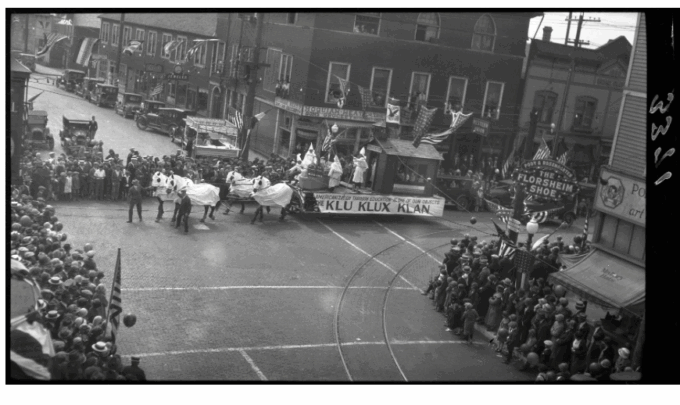


































































Ku Klux Klan parade in downtown Hoquiam, Washington. Photo courtesy of Polson Museum, Hoquiam.
It’s not hard to find episodes of business class cooperation in United States history. Particularly when it comes to labor relations and suppressing workers’ rights, employers from different parties, industries, regions, and religions have much in common—and act accordingly. During the early twentieth century, bosses routinely expressed this solidarity by creating organizations ranging from chambers of commerce and professional associations to citizens’ committees and citizens’ alliances. The latter groups, in fact, were responsible for some of the bloodiest acts of vigilante terrorism in western U.S. history as merchants and manufacturers came together to bust unions and drive troublesome workers from their towns and workplaces. On the Pacific Coast, employer-led committees brutalized radical and militant workers in cities from the Mexican border to the Olympic Peninsula.
In Grays Harbor, Washington, which for decades made headlines for its record-setting lumber shipments and bloody labor wars, the mid-1920s witnessed the rise of a dominant Right-wing coalition with a firm grip over local politics and influence in national politics. The region was no mere backwater; in the 1920s Aberdeen—and its “Twin City” Hoquiam—were some of the Northwest’s largest and fastest-growing cities, and the Harbor’s goings on regularly turned up in major metropolitan dailies. Different branches of the Far Right and Further Right took their turn. In the early and mid-1920s, the center of right-wing activism was the hooded knights of the Ku Klux Klan. While many Americans believe that the Klan was limited to southern states, many of its deepest wells of support lay in the U.S. West and Midwest.
During the mid-1920s, a new struggle on Grays Harbor shifted from contests between the Left and Right, to a war between the Far Right and Further Right—as the Chamber of Commerce (and their citizens’ vigilante committee front groups) increasingly struggled for dominance with the KKK. Both groups had leaders drawn from the region’s employing class. Both the Chamber and the Klan had experience in politics; moreover, both groups maintained close ties with “law enforcement,” and both positioned themselves as representatives and defenders of their community. Still, if traditional politics and “justice” failed them, both groups proved willing to resort to vigilante justice to get their way.
In late 1924, the city’s municipal elections earned media attention across the region: the booming industrial city of Aberdeen, one of the Northwest’s largest municipalities, elected a Klansman to head its government. The Klan’s main rivals came from non-KKK (but pro-vigilantism) employers who showed that force worked not only for suppressing labor movements, but also for removing obnoxious elected officials.
Although the specifics of this local history are unique—perhaps a bit bizarre—they shine a bright light onto U.S. business history a century ago at a time when the Right ruled triumphant over much of American politics, culture, and economy. Counterpunch readers will likely notice the reverberations between the America of the Roaring Twenties and today’s world—exactly a century later.
Considerable ink gets spilt in discussions over divisions within the U.S. business elite, with our valiant Fourth Estate inquiring whether “Boss A supports progressive movements?” or “Will that divorce between Boss B and their spouse lead to a windfall for anti-Trump campaigns.” There are real schisms among those atop our society, but the unfortunate truth is that employers’ class interests have always attracted them toward movements of the Right. It’s this reality that makes possible what we see before us today: the schisms between the neocon Cold Warrior imperialists of the Democrat-Never Trump Republican wing of the United States; and the quasi-fascist movements lined up behind Trump. Both have billionaires and powerful institutions backing them, and both will continue their decades-long practices of harming those on this country’s—and global—margins.
What’s more, this Pacific Northwest regional history of a century past provides a useful reminder that those who run the U.S. economy and political institutions have little interest in democracy, except in finding ways to eradicate it from this “land of the free.” No fact so clearly shows the Upper Crust’s disinterest in democracy as the growth of today’s vast “union avoidance” industry, dedicated as the name suggests, to keeping workplaces non-union. Thus, the (non-union) workplace, where Americans spend so much of their lives, is as dictatorial as any authoritarian country—places where the freedoms of expression and association do not apply, and any show of critical thinking can—and often is—met with retaliation, even termination.

Congressman Albert Johnson, 1920. Photo courtesy of Polson Museum, Hoquiam.
Albert Johnson: King of the Right
Few men figured so prominently in the 1920s American Right as Albert Johnson, longtime publisher of the Daily Washingtonian in the lumber town of Hoquiam. Johnson rose through the ranks of western publishers and established himself in the early 1910s through his militant anti-immigrant and anti-radical politics. Following his role in crushing a strike of (primarily) immigrant lumber workers in the spring of 1912, he founded The Home Defender, self-described as: “A National Newspaper Opposed to Revolutionary Socialism.”
A fervent bigot, Johnson channeled his anti-radical and anti-immigrant views into a decades-long crusade to expand immigration restrictions. Elected to Congress as a Republican in 1912, Johnson maneuvered into House leadership and assumed his prized position atop the House Immigration Committee. He and his movement peaked a century ago, in 1924, when Congress passed the Johnson-Reed Act, dramatically curtailing immigration from outside northwest Europe—eugenicists’ favorite nations.
Indeed, eight decades before Grays Harbor’s Kurt Cobain brought his song “Come As You Are” into the world, Albert Johnson, the region’s other most (in)famous resident, championed laws declaring, essentially, “Unless you’re from northwest Europe, don’t come at all.”
Unsurprisingly, given his accomplishments at the national level, Johnson drew support from all sides of the Northwest business classes: the lumbermen, bankers, news editors, and others who joined Johnson in their citizens’ committees and chambers of commerce in the early years of the twentieth century. Support also came from the proto-fascist movement of the Twenties, best represented by the Ku Klux Klan. Both the traditional business Right and their upstart challengers viewed Congressman Johnson as a champion. After all, he promoted both Northwest business development and an assortment of discriminatory policies designed to, in the words of his Home Defender, “put up the bars” against immigration.
Klan Towns
The KKK organized in haste on the Harbor in the early and mid-1920s. The movement’s growth paralleled that of the national movement as by 1924 the Klan had millions of members stretching across the country. A mass organization, the KKK appealed to the racism, anti-Semitism, anti-Catholicism, xenophobia, and anti-radicalism of large swaths of white, protestant America.
Across the United States, Klansmen controlled dozens of local governments, and maintained a stranglehold over officials in states such as Oregon. The organization, too, ranked among the nation’s most dedicated fighters against the “Red Menace” of the Wobblies (Industrial Workers of the World, or IWW) and Communists. In 1924, the white terrorists’ anti-labor activism reached a grim crescendo when California Klansmen descended on the San Pedro Wobbly hall, brutally assaulted attendees with guns and clubs, and burned IWW children so badly that they had to be hospitalized.
Few subjects so confound students in my classes as our discussions of the strength and composition of the “Second Ku Klux Klan” during the 1920s. They are sometimes blissfully unaware of the terror group’s existence, but more likely familiar with the oft-told legend of the Klan as a small group of hillbillies as depicted in popular media. Indeed, Americans seem to struggle when confronted with the fact that the Klan was one of the largest and most powerful social movements of the first half of the twentieth century and that much of its membership—particularly its leadership—hailed not from the fringes of society, but instead the ranks of professional and business classes—the “Respectables” of the chamber of commerce. It’s possible that believing this mythical version of the Klan’s history is comforting for Americans, so often taught to accept anti-worker perspectives and believing that the uneducated and poor were—and are—the people most likely to hold white supremacist views.

In Grays Harbor, as across the United States, the Klan had its greatest appeal among business owners, professionals, and public officials. In Portland, Oregon, one of the largest blocs of Klansmen were police, and across the country the KKK actively recruited preachers who helped the white supremacist group reach their flocks. After observing one local Klan celebration, one Grays Harbor Wobbly claimed that the Klansmen hailed from the “gentry.” The Klan agreed. In 1921, Kleagle W.D. Norris spent four weeks recruiting in Hoquiam; he announced that most of the new members were businessmen.
Norris’s assessment was telling. Like in many other areas of Klan strength, the Harbor’s most-active KKK members included small businessmen and professionals, including several wealthy members of the owning class. Moreover, like many other groups formed by managers and professionals, the Klan demonstrated its class character as Klansmen pledged to fight intoxication, thus maintaining a sober, punctual, and hard-working labor force.
The Harbor’s best-known Klansman was Ransom Minkler. Ransom was a prolific joiner who enjoyed the networking and socializing common to fraternities and employers’ associations. By 1918, he led the Grays Harbor Dairyman’s Association; in later years he led the area’s chamber of commerce and an automobile dealers’ association.
Although Minkler was not one of the Northwest’s lumber barons, he was wealthy. The Twenties was a dynamic period with vast fortunes made in the automobile industry, and Minkler cashed in. In 1927, Minkler started the Sunset Oakland Automobile Company in Aberdeen, paying for a $20,000 Hudson auto dealership.
The Klan’s message reached large audiences through its parades and mass meetings. In 1923, state Klan leaders held a gathering in Grays Harbor attended by “between 900 and 1,000 members, according to an estimate given by members who were there.” Members of the Aberdeen and Hoquiam organizations gave the “king kleagle of the Aberdeen klan” a gold knife, “in recognition of the work he is said to have done for the organization on Grays Harbor,” according to the Aberdeen Daily World. On July 4, 1925, the Klan turned out for a massive Hoquiam Independence Day parade, donning white robes for members and the horses pulling their float, as well as a large sign reading: “Americanization through Education is One of Our Objects: The Klu [sic] Klux Klan:”
The War on Vice
The Klan was an explicitly Protestant Christian organization and its membership and values connected it to elements of the temperance movement. Klansmen placed a high priority on enforcing laws that outlawed “vices” such as liquor, gambling, and prostitution. Enforcing the 18th Amendment was high-profile and often dangerous business. According to one estimate, nationally more than 1,300 persons were killed during the Twenties “in which it is known that prohibition enforcement was directly at issue. In every case one or more sworn officers of the law or their agents were involved as principals, either as the killers or the killed.”
The Harbor had its fair share of sensational dry raids; some ended in bloodshed. Klan-affiliated police directed some of the raids, as Klan members raided moonshiners’ homes, destroyed stills, and lobbied politicians in favor of enforcing alcohol laws.
The KKK’s campaigns against booze and prostitution distinguished it from some other right-wing business-led organizations—notably the citizens’ committees, which were more “Big Tent” operations—at least among the employing class. Those committees enrolled businessmen from “diverse” backgrounds. What really mattered to the citizens’ committees like those formed in Grays Harbor was the businessmen employers’ willingness to unify to defeat unions—using any means necessary.
At the center of Grays Harbor’s legal and extra-legal battle against the “demon rum” was the notorious “phantom dry squad” run by one of the Harbor’s most prominent Klansmen, an octogenarian Civil War veteran and constable named Albert G. Hopkins. Local governments created the dry squad to carry out a “clean-up campaign,” enrolling men such as Hopkins as constables. The press referred to the Hopkins operation as a “phantom squad,” which was likely a reference to the similarity between Klan and ghost costumes.
The dry squad activities generated attention—including dramatic news stories—as Hopkins led armed raids onto private homes and businesses across Grays Harbor—even conducting a raid at the Aberdeen mayor’s home. His brash tactics in defense of “law and order” won him supporters among large swaths of the voting public.
A KLAN MAYOR IN TIMBER TOWN
During the elections of the Roaring Twenties, in many cases, voters could choose between candidates from the Far Right and Further Right. In November 1924, the hooded knights succeeded when their chosen candidate, A.G. Hopkins, became mayor, unseating the incumbent, in the primary and winning the general election by more than 500 votes a month later.
Many Americans hold exaggerated views of their country as a bastion and beacon of democracy. The reality, of course, is more complicated—or rather—the reality is that elections in the United States have never been all that democratic. Women won the vote in the Evergreen State in 1910, ballooning voter rolls. However, the electorate remained laughably unrepresentative of the population with immigrants, itinerant laborers, and young people largely excluded from the polls. In the booming city of between fifteen and twenty thousand residents, a small minority of 4,500 voted; the new mayor received 2,562 votes. A paltry percentage of residents supported the new mayor, but of those (mostly white, native-born, older adults) who had the vote and the time to cast a ballot, the far-right proved popular.
The election of a Klan mayor made statewide news, proving an embarrassment to some of the business owners and professionals who worried about losing investments and tourism in their area. Leading the charge against the new mayor was banker William J. Patterson, one of western Washington’s wealthiest men and an old hand at dealing with sticky “problems” through extra-legal solutions. During a string of labor conflicts in 1911-1912, Patterson organized and led the citizens’ committee vigilantes as they beat, jailed, and deported men, women, and children from the Harbor.
In the interim between Patterson’s attacks on the Wobblies in 1911-1912 and the 1924 election, he reflected on his past as an anti-labor ruffian, proudly recalling: “We organized that night a vigilante committee—a Citizens’ Committee, I think we called it— to put down the strike by intimidation and force. . . . [W]e got hundreds of heavy clubs of the weight and size of pickhandles, armed our vigilantes with them, and that night raided all the IWW headquarters, rounded up as many of them as we could find, and escorted them out of town.”
Summarizing the non-Klan business group’s opposition to Mayor Hopkins, Patterson reported that “Aberdeen would like to devote its interest to the things that will contribute to its growth and to the development of Grays Harbor country in general.” Expressing these views, the Seattle Star wrote that many businessmen “charged him [Mayor Hopkins] with causing the town to lose its former prosperity.”
Another of the charges leveled against the mayor will be eerily familiar to readers in the 2020s as our own era’s elderly and infirm elites have yet to pass power to future generations. Mayor Hopkins’s opponents claimed that the elderly man was doddering and frail, unable to overcome the many hurdles opponents put in his way. Patterson contended that “the duties of the office of mayor had become too strenuous for a man of Mr. Hopkins’ age.” Moreover, the new mayor violated political norms by replacing appointed officials with his supporters. Ransom Minkler served as chief political operative; opponents charged the KKK political duo of stacking the police force and city government with their Klansmen pals. For good measure, Mayor Hopkins crafted new police regulations, including an authoritarian measure—the mass finger-printing of anyone charged with traffic or parking violations.
The conflicts between the Harbor’s two pillars of the business elite led to an exceptionally chaotic term for Hopkins, dubbed “a bitter political strife for months” and a “civic war” by the Seattle Star. The mayor’s wealthy opponents spent weeks organizing to counter the city leader’s political maneuvers—with the goal being the mayor’s ouster. The Seattle Star summarized the period: “This town is in the throes of one of the bitterest political fights it has ever had.” This was quite the statement considering the area’s long history of bloody conflicts.
Aberdeen’s two principal newspapers – the Daily World and Grays Harbor Post – opposed the Klan and Mayor Hopkins in print. The World, though, muted its criticism, ostensibly providing a “just the facts” reporting. Notably, it did not use the same discretion when “reporting” on labor activists; instead, at times, that paper incited its readers to take up arms against working-class radicals and downplayed years of anti-labor murders, round-ups, and property destruction.
J.W. Clark, editor of the Grays Harbor Post, went much further. He condemned the Klan in the harshest language possible. The newspaper featured front-page headlines and lengthy, biting editorials denouncing the Klan as “an unlovely thing that has no place in the United States of America,” an “unhealthy mental epidemic” which “every other intelligent citizen and right minded man” should confront should help in “blotting out.” Harsh feelings were apparently mutual; one issue of Seattle-based Klan paper The Watcher in the Tower attacked the Post: “Does the editor of the Grays Harbor Post really know what an American is? He is like a lot of the present day editors, who have a limited knowledge on certain subjects and when these are presented, makes what he thinks is a bright a retort, for an answer, that stamps him for what he is quicker than any branding iron ever could.” Displeased at the attack, Clark used the entire editorial page of his weekly to issue a sharp rebuttal to the Klan.
Clark mocked the KKK’s cowardice since they “hide their identity” and “wear sheets.” He also condemned their reliance on “direct action,” which he defined as to “take what you want when you want it.” One irony of Clark’s attack, however, was that in Aberdeen, the KKK gained power through an election, while the press worried that the “Hooded Order Is Active In Election.” Moreover, Clark and his fellow employers had their own history of using violent direct action to get their way. For decades, businessmen like Clark had used guns, clubs, rope and fire to terrorize union activists who tried to inject a little democracy into “lumber capital of the world.”
Hopkins’s mayoral stint didn’t last long. Four months after the December 6 election, a group of businessmen hostile to Hopkins again used force to make change. Many of these local elites had experience with removing elected officials, although unsurprisingly they almost always trained their political guns on the left. A decade before the Klan mayor reached office and amid a strike of thousands of local lumber workers, Grays Harbor employers forced a successful recall vote against Hoquiam’s prolabor socialist mayor and simply ousted the socialist city clerk—an official in the local labor movement. Recalls have long been a tool in the belt of Washington’s business class, useful ways to rid government of the rarest of politicians—those who put the interests of the working-class majority first.
When recalls proved too slow and unpredictable for Grays Harbor employers, they resorted to more direct methods of political change. And for once, they trained their political guns on those even further to the right.
On April 3, 1925, only a few months into Hopkins’s term, the “town fathers” had had enough. That night, a group of prominent citizens—described by the Seattle Star as “business men, bankers, and the ‘open town’ element”—took the aged mayor to the Morck Hotel in Aberdeen. The Star set the scene: With “armed deputy sheriffs standing guard,” the mayor “sat dumbfounded, with no friends to counselor cheer him,” as “nearly 100 leading businessmen” hurled charges for four hours. After the lengthy period of “third degree methods,” “a paper was thrust before him to sign. It was his resignation.” Hopkins complained of being “forced to quit.”
As in earlier decades with business-led vigilantism against immigrants and labor radicals, the Harbor’s businessmen got their way through force. In the mid-1920s, however, employers’ interests motivated them to target a right-wing hate group. The Klansmen’s reputations—and potentially their commitments to enforcing prohibition—threatened investments and statuses of the other businessmen who undoubtedly wanted to keep their city out of the headlines. When attacks on the old mayor’s age and policies failed to yield results, businessmen used force to get their way.
Like the KKK’s outlandish costumes and customs, the improbable story of Aberdeen’s Klan mayor’s rise and fall shouldn’t distract us from the Klan’s wider significance. Fundamentally a racist and nativist organization, the Klan embodied the culture wars of the 1920s and was right at home in the Pacific Northwest. The Klan was representative of a large swath of the nation’s (and Grays Harbor’s) white Protestant population, and as across the country, many of Grays Harbor’s elites had power in the hooded order. Indeed, many of the area’s leading citizens, including Mayor A.G. Hopkins, and (future) Chamber of Commerce President Ransom Minkler – were notable Klan members, or at least strong supporters of KKK platforms. Congressman Albert Johnson even played an important part in turning Klan beliefs into public policy; generations of migrants turned away from America’s guarded gates are part of that legacy.
AFTERWARD
Ex-Mayor Hopkins’s reputation and influence was barely (if at all) diminished by his disastrous term. Reporters sometimes turned to Hopkins for his political opinions, while a decade after his brief mayoral stint, the Seattle Daily Times celebrated Hopkins’s birthday, reporting “Aberdeen’s Lone G.A.R. Man is 90.”
More significant support went to Ransom Minkler. His years in the Klan had done little to dampen his reputation—quite the opposite—as the businessman continued to exert considerable influence. A decade after his time as political advisor made statewide news, his fellow businesspeople chose Minkler to serve as president of the Grays Harbor Chamber of Commerce. In 1940, as Grays Harbor again rose to national infamy for right-wing vigilante attacks on labor, Minkler served in the vanguard as a director of the controversial Grays Harbor Business Builders, an employers’ organization at the center of the area’s anti-labor and anti-immigrant violence.
Nationally, the Ku Klux Klan’s strength waned as the 1920s wore on. Weakened by charges of political and sexual corruption, the KKK declined from a membership in the millions in 1924, to numbering around thirty-seven thousand by 1930.
But in some parts of the country, the “secret empire” maintained itself into the 1930s. Historian David M. Chalmers viewed the Harbor as the KKK’s main base of strength in the Pacific Northwest during the late 1930s. “With the exception of the Aberdeen, Washington, Klansmen, whose stones rattled the windows of the town’s union halls, the only active realm in the West was California,” noted Chalmers.
The Klan’s persistence on Grays Harbor was at least partly due to the group’s base among employers and that class’s decades-long embrace of vigilantism. Indeed, as Depression-era workers across the United States struck and unionized by the millions, the Klan remained in some labor strongholds where they lived up to their militant anti-union reputations. The KKK played a notorious part in the opening convention of that most storied union—the International Longshore and Warehouse Union (ILWU)—held in Aberdeen during April 1938. With leaders of the dynamic new union in town, Klansmen attempted to terrorize the group, leading union president Harry Bridges to condemn the KKK as union-busting “red-baiters.” In much of the country it was left to the labor-left to do battle alone against far-right groups like the Klan as police and other “peace officers” both looked the other way or collaborated with reactionary forces.
Looking back a century later, the parallels between 1920s and 2020s America are hard to miss. Whether we’re talking about the “division” between the early twentieth century citizens’ committees (alliances) and the KKK, or the “divisions” between the billionaire-dominated Democrats and Republicans, in all cases we’re talking about elites who favor discrimination and brutality against immigrants, mass incarceration and surveillance, and a refusal to assist the working class through universal health care, pro-worker labor law reform, or even increased minimum wages.
Our own era is dominated by reactionary forces; the oppression and exploitation from the Right can appear invincible—inescapable. And while much about the current era is new, the overwhelming power of the American Right is not without precedent; instead, it’s been a feature throughout the country’s history. A century ago, it was the collective power of the working class that faced down and temporarily tamed the Right, ushering in an era of material benefits for the working-class majority. Any path that leads us out of our own era of rightwing domination is likely to emerge from similar sources—through mass unionization and societal disruptions led by a militant labor movement.
The post America’s Far Right and the Further Right: the Klan and a Coup in 1920s Lumber Country appeared first on CounterPunch.org.
This post was originally published on CounterPunch.org.
-
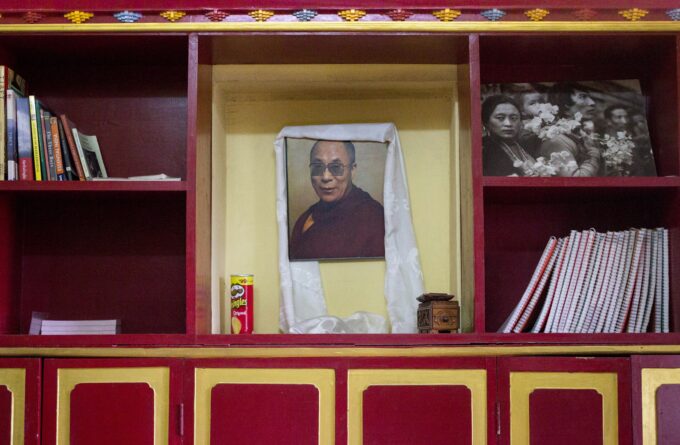








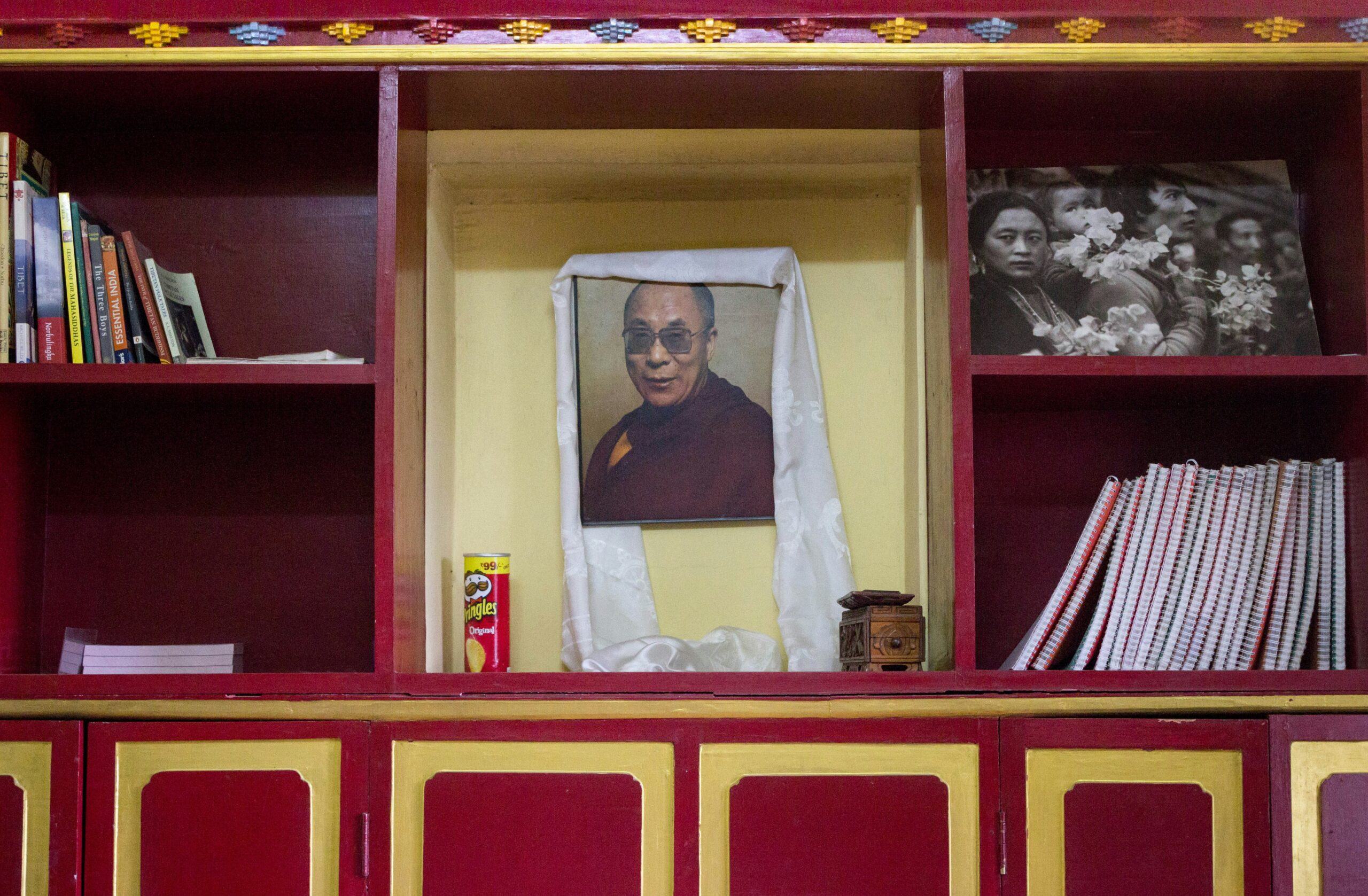

























































Last month, on the Daily Beast podcast, journalists Joanna Coles and Michael Wolff took turns reeling off a list of famous people who Wolff met while visiting Jeffrey Epstein’s Manhattan home. The recited names were a who’s who of rich, powerful, and perverted men, many of them recognized Friends of Jeffrey. But one name stood out as unusual: the Dalai Lama. (The list of names starts at about the 18:25 timestamp on the full recording.)
Coles thought so too, asking Wolff, “Did you actually meet the Dalai Lama at Jeffrey Epstein’s?”
“Indeed,” said Wolff.
Asked why the Dalai Lama was there, Wolff said that a lot of people hung out with Epstein to try to wheedle money out of him. And there was something compelling about the upscale salon-like scene: “It was always extraordinary,” said Wolff.
Wolff said that he started spending time at Epstein’s house in 2014, six years after the infamous pedophile was given an extremely favorable plea deal for sex crimes charges because, former U.S. district attorney Alex Acosta once said, “I was told Epstein ‘belonged to intelligence’ and to leave it alone.” Wolff was working on a potential book about Epstein and was given access to the now-deceased sex offender’s wealthy social milieu. Epstein later became an important source for Wolff’s best-selling books about President Donald Trump.
Any writing about Michael Wolff seems to require the proviso that his reliability has been questioned by assorted enemies and media critics. Wolff is a gossip hound, practicing the art at a very high level, and he hangs out with unsavory politicians and oligarchs who might like the idea of having a famous journalist around — until he publishes a book about them. Wolff gets into marble-floored rooms that many journalists don’t, so his comments are worth considering.
With that throat-clearing aside, let’s consider why His Holiness the Dalai Lama may have been at now-deceased sex trafficker and pedophile Jeffrey Epstein’s house. People generally hung out with Epstein for two reasons: sex and money. Wolff suggested that, in this case, it was the latter. Did the Dalai Lama, or an organization with which he’s associated, receive a donation from Epstein?
The Dalai Lama’s press office did not respond to an emailed list of questions. I was unable to reach Michael Wolff for comment about the Dalai Lama’s visit to Epstein’s home.

It wouldn’t be the first time the Dalai Lama had received money from a sex trafficker. In 2009, the Tibetan spiritual leader spoke at an event for NXIVM, the abusive sex cult whose leader, Keith Raniere, was convicted in 2019 on seven criminal charges and sentenced to 120 years in prison. During the 2009 appearance, the Dalai Lama gave a speech and placed a ceremonial Tibetan scarf on Reniere’s shoulders. For his efforts, the Dalai Lama reportedly received $1 million. The deal was made by billionaire heiress Sara Bronfman, who, along with her sister Clare, gave Raniere and NXIVM at least $150 million. Sara Bronfman was alleged to be having an affair with the Lama’s personal peace emissary Lama Tenzin Dhonden, who was later removed from his post for corruption.
Despite evidence that he ran a child sex trafficking operation, the source of Epstein’s wealth has never been sufficiently accounted for. People who spent time around him have said that they didn’t know what he did for a job and that he seemed to do very little actual work. For some reason, billionaires liked to give Jeffrey Epstein huge amounts of money. Les Wexner gave Epstein tens of millions of dollars — he later said that Epstein misappropriated $46 million from him — along with one of the most valuable residential properties in New York City. Leon Black, who has been accused of rape in civil suits, paid Epstein $158 million for “tax advice.”
Whatever Epstein was as a financier — sometimes he was described as a financial bounty hunter, reclaiming assets stranded overseas — he was adept at moving money around the world. And he had help from pliant bankers, as demonstrated by victims’ lawsuits against JPMorgan Chase and Deutsche Bank, which led to nine-figure settlements. Sen. Ron Wyden recently said that the Treasury Department has documents about banks looking the other way for more than $1.5 billion in Epstein-related financial activity, and that Treasury should release the documents. Wyden, who has overseen a long-running investigation into Leon Black’s taxes, also said that Black’s payments to Epstein should be investigated by the IRS.
In short, there’s still so much we don’t know about where Epstein’s money came from and where it went — and to what ends. But following the money trail as far as it leads can tell us something about Epstein’s network, how he operated, and who enabled him. And sometimes a single $50,000 payment can open up the aperture, letting in some light.
In the official 2020 MIT report regarding Epstein’s relationship with the university, two partners from the law firm Goodwin Procter “analyzed all donations received by MIT, both those made directly by Epstein (whether individually or through his charitable foundations) and those made by third parties at Epstein’s alleged behest.” The report found that, during a 15-year period, Epstein donated a combined $850,000 to Seth Lloyd, a physics professor, and to the MIT Media Lab, which was then headed by Joi Ito. Michael Wolff mentioned Joi Ito as one of the prominent guests who attended Epstein’s regular home gatherings.

The report claims that Lloyd, who was placed on administrative leave before being allowed to return to teaching, accepted transfers from Epstein in his personal bank account and tried to conceal the source of the donations. The report similarly describes MIT officials as trying to keep quiet Epstein’s donations to the Media Lab and his visits to campus.
The report doesn’t look at relationships between MIT staff and Epstein that occurred outside the university. While the authors write that they looked into donations that may have come through Epstein proxies, it’s not clear how far that investigation went, or was allowed to go. Former MIT Media Lab director Joi Ito received at least $1.2 million from Epstein for his own venture capital firm, which the MIT report mentions in a footnote.
The MIT Media Lab had an uncommonly high profile for a university organization, with an orbiting network of billionaire tech moguls, scientists, writers, government officials, politicians, and TED-talking NGO types. That made the Media Lab’s director, Joi Ito, an important relationship for the prestige-obsessed Epstein. The two seemed to be in close contact, with Ito once “strategizing with [Epstein] as to how he might be able to ‘mollify the bad press’ after a series of articles were published concerning a civil lawsuit brought by Epstein victims,” according to the MIT report. Ito, who sat on the boards of the New York Times and the MacArthur Foundation, repeatedly solicited Epstein for more money for the university. MIT’s investigators claimed that his big-money asks weren’t answered:

Epstein used ostensibly philanthropic donations in order to win favors, borrow academics’ intellectual prestige, or to move money where it wouldn’t normally be allowed to go. The MIT report describes Epstein using Professor Lloyd (with the professor’s participation) to see if he could make donations to the university without setting off alarm bells:

In November 2013, Linda Stone, who first introduced Epstein to Ito, sent an email to Ito suggesting that a 501(c)(3) might be used to mask Epstein’s donations, although, she wrote, “there may be disclosure issues.” Ito then took the idea to MIT’s VP of Development, according to the MIT report.
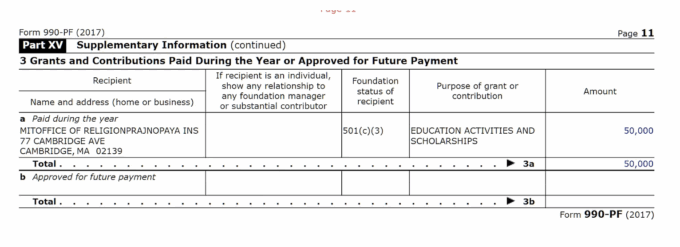
In 2017, a 501(c)(3) nonprofit called Education Advance donated $50,000 to the Prajnopaya Institute at MIT. The money for that donation came from an entity called “J Epstein Virgin Islands FD Inc,” which that same year gave Education Advance $55,000, according to IRS filings. Education Advance took in an additional $1,500 in 2017, which appears to be the only year it was ever in operation. Its IRS filings report no other donations or dispersal of funds, suggesting that Education Advance might have been purpose-made for the Prajnopaya Institute gift. After 2017, Education Advance never filed another Form 990, leading to its nonprofit status being revoked.

Education Advance was overseen by Svetlana Pozhidaeva, a Russian model who worked for MC2, a modeling agency run by Jean-Luc Brunel, an Epstein accomplice accused of rape and sex trafficking who died in a French prison in 2022. Education Advance was registered to an Epstein-owned Manhattan building. Pozhidaeva, who had been photographed leaving Epstein’s house, also shared a lawyer with him: Darren Indyke, who is now co-executor of Epstein’s estate. Epstein’s Virgin Islands-based foundation, the initial source of the funds, was sometimes called Enhanced Education.

The Prajnopaya Institute transaction isn’t mentioned in the 2020 MIT report, which covers the years “between 2002 and 2017.” The existence of the transaction had been reported a year earlier by the Daily Beast. MIT’s media office did not respond to questions about why the Prajnopaya Institute donation did not appear in its 2020 report on the university’s relationship with Epstein.
The lack of official acknowledgement from MIT is another indicator that Epstein’s money flows remain poorly charted. Some parties might prefer it that way. Epstein also helped muddy the waters by lying and exaggerating about the scope of his charitable giving — a deception that included Epstein making edits to Wikipedia pages about himself, his foundation, and some of his associates.
The Prajnopaya Institute told the Daily Beast in 2019 that it returned the $50,000 donation. The Institute didn’t respond to an email asking how the donation was brokered and if the Dalai Lama or Tenzin Priyadarshi was involved. A separate inquiry to Priyadarshi, sent through his website imonk.org, received no reply.

Priyadarshi has long been associated with the Media Lab and Joi Ito, who described Priyadarshi as his friend. They podcasted together and co-taught an MIT class called Principles of Awareness. Ethics programs that began in the Media Lab later moved to the Dalai Lama Center, where Priyadarshi is CEO. Ito and Priyadarshi have appeared on discussion panels together. Ito, a prolific photographer, has posted photos of Priyadarshi and the Dalai Lama, and he’s cited them in his writing. The Dalai Lama has attended at least three events hosted by the MIT center named after him.
Dr. Babak Babakinejad, an MIT whistleblower and research scientist who first alerted me to the Prajnopaya Foundation donation, offered the following statement:
“The MIT Epstein report is institutionally compromised. MIT has persistently resisted transparency regarding Epstein’s connections to the Media Lab and its associated initiatives, particularly regarding Open Agriculture and its Food Computers. This project is implicated in fraud, environmental misconduct, and retaliation. These are issues I have been actively challenging as part of an ongoing lawsuit.”
Epstein’s interest in MIT was about more than just showering a couple programs he liked with cash. Epstein visited MIT’s campus at least nine times and attended MIT Media Lab events, which could attract wealthy tech and political figures like billionaire Reid Hoffman. Epstein spent time with MIT professors and staffers, some of whom he met through the literary agent John Brockman, who acted as a connector between Epstein and scientists and academics. It’s hard to think that Epstein’s MIT-related contributions during a 15-year period only amounted to $850,000, especially when the donations that are now documented were once obfuscated. As shown here, the Prajnopaya Institute donation means the real amount that Epstein gave to MIT is at least $900,000.
It’s not clear why Epstein, who as far as I can tell never mentioned Buddhism or had any association with Tibetan culture or causes, made a $50,000 donation to a Buddhist organization at MIT. Perhaps someone influential asked him. Perhaps he was once again looking “to see if the line jingles.”
The alarm did go off after all, but it was too late for anyone to care.
This piece first appeared on Jacob Silverman’s Substack.
The post Why Was The Dalai Lama At Jeffrey Epstein’s House? appeared first on CounterPunch.org.
This post was originally published on CounterPunch.org.
-












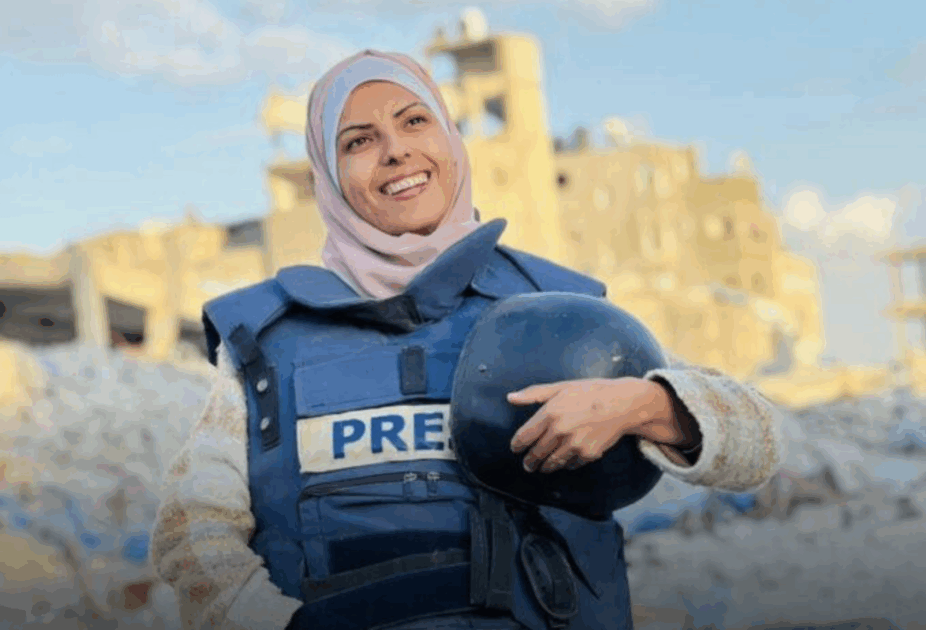





















































+ Can you imagine being a reporter in Gaza, knowing that you’re on a target list by Israel simply because you are a reporter and feeling compelled to write a will to your young son? That’s what Maryam Abu Dagga, the tireless and brave freelance reporter for the AP, did before she was murdered this week, along with four other journalists, rescue workers and Palestinian civilians, in a targeted double-tap strike by the Israelis outside a hospital. Here’s what she wrote…
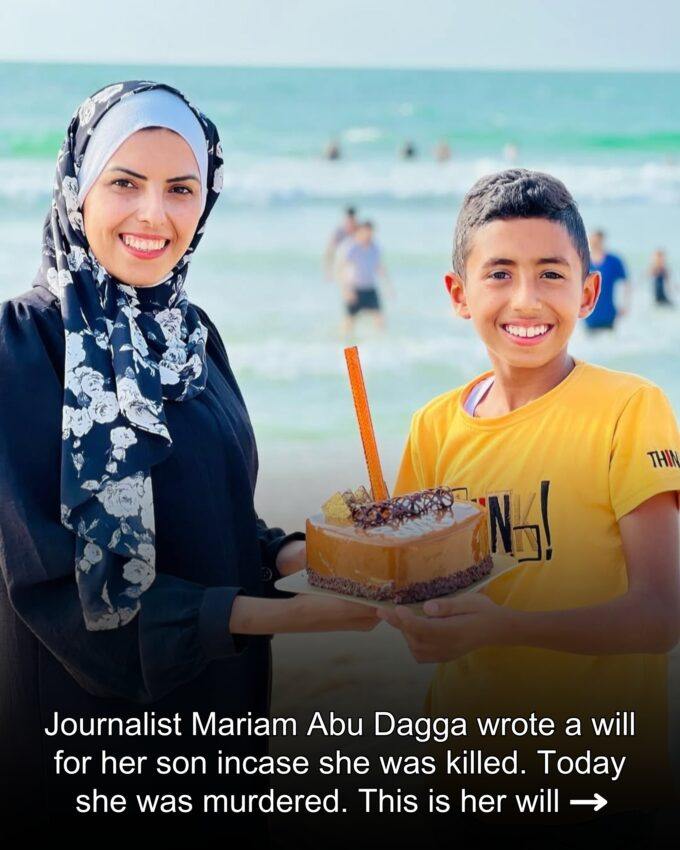

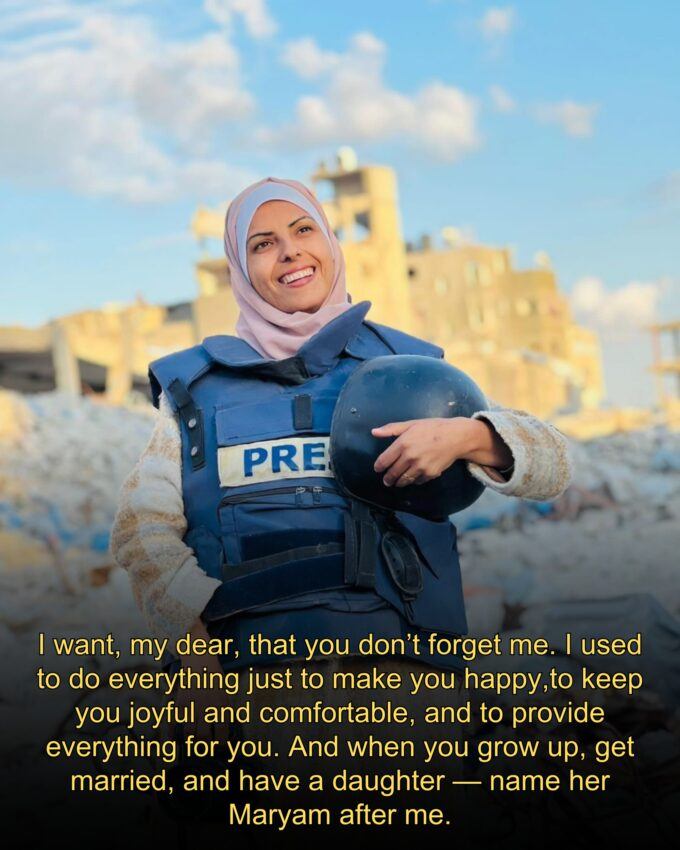

+ At least 20 people, including 4 journalists (one a freelancer for AP), a first responder and hospital staff, were killed Monday in an Israeli “double-tap” strike just minutes apart on the same location at southern Gaza’s Nasser Hospital. The double-tap strikes are meant to kill first responders sent to rescue the wounded from the initial strike…
+ Yuval Abraham on Israel’s use of double-tap airstrikes: “Source in Southern Command: ‘Another strike will be carried out to ensure that rescue efforts do not take place. First aid providers, rescuers – kill them. Attack again, on them. This is the procedure. Since October 7, it has been in place.”

+ Dr. Atef Al-Hout, Director of Nasser Medical Complex, described Israel’s double-tap attack on the hospital’s central surgery ward, then hit the staircase opposite the department where journalists had gathered to document events, after an earlier Israeli airstrike in the same location had already murdered Reuters cameraman Hussam Al-Masri:
What happened was that an Israeli drone bombed the surgery department, more specifically, the staircase opposite the surgery department, resulting in a number of martyrs, mostly journalists who were there to document the events. Without any prior warning or anything. And it was targeted twice, not once. The surgery department at the hospital. We are trying to finish these surgeries, as it will soon be put out of service until it’s restored. We are talking about the central surgery department here. It contains six operating rooms, roughly 70 percent of the number of operating rooms within the Nasser complex. What results from that, we will be witnessing with our own eyes very soon.
+ In the 22 months since October 2023, Israel has launched more than 800 attacks on healthcare facilities in Gaza.
+ While Netanyahu wrote off the Israeli attack on Nasser Hospital that killed journalists, rescue workers and civilians as a “tragic mishap,” his own favorite TV network, Channel 14, reported that “The soldiers say: the attack on the Nasser terror headquarters was approved and coordinated with the high command.”
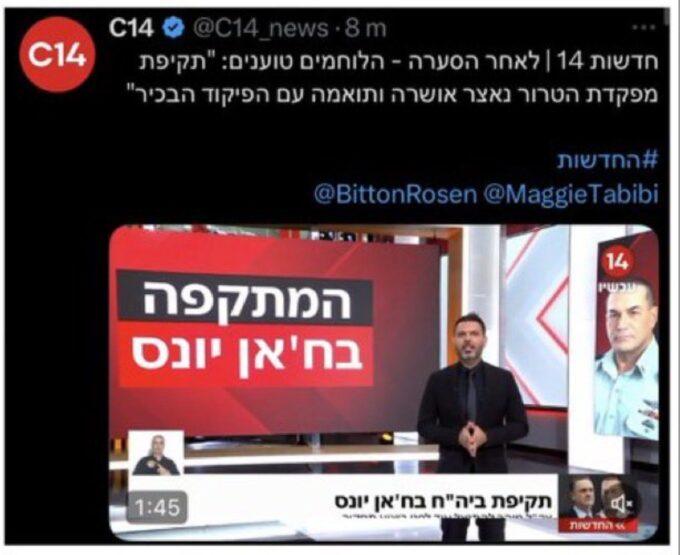
+ Dr. Yawa Hawari offered this in response to Israel’s assertion that the airstrike that murdered 20 people at Nasser Hospital was meant to knock out a “Hamas camera” (which actually belonged to Reuters journalist Hussam al-Masri, who filmed the attack that killed him): “They want you to believe that Israeli regime surveillance is so precise that it can see a camera set up on the stairwell of a hospital building but can’t see all the journalists and civil defense workers around it.”
+ The “Hamas” camera…

…actually belonged to Reuters journalist Hussam al-Masri, who was using it to provide a live feed from the hospital.
+ The targets were the very people Israel murdered. They’ve bragged about how precise their airstrikes are, using the Habsora, Lavender and Where’s Daddy? AI systems….

+ Jerome Grimaud, Médecins Sans Frontières’s emergency coordinator in Gaza, on Israel’s double-tap strike on Nasser hospital:
We denounce in the strongest possible terms Israel’s horrendous attacks on the Nasser medical complex today – the only partially functioning public hospital in the south of Gaza. Israeli forces killed at least 20 people and injured 50 more in consecutive strikes, including healthcare workers, rescuers, and journalists.
Among them was Mariam Abu Dagga, a freelance photographer who frequently worked with MSF. We are heartbroken by her death. Mariam leaves behind a son who must now grow up without his mother. At least four other journalists were also killed today.
Some MSF staff members were forced to shelter in the laboratory as Israel repeatedly struck the building amidst rescue efforts. We are outraged as the Israeli forces continue to attack healthcare workers and journalists with impunity.
For the past 22 months, we have watched as healthcare facilities have been levelled, journalists silenced, and healthcare workers buried beneath the rubble by the Israeli forces. As Israel continues to shun international law, the only witnesses of their genocidal campaign are deliberately being targeted. It must stop now.
+ Photojournalist Valerie Zink on why she can no longer work for Reuters…
Western media is directly culpable for creating the conditions in which this can happen. As Jeremy Scahill from Drop Site News put it, “every major outlet – from the New York Times to the Washington Post, from AP to Reuters – has served as a conveyor belt for Israeli propaganda, sanitizing war crimes and dehumanizing victims, abandoning their colleagues and their alleged commitment to true and ethical reporting.”
By repeating Israel’s genocidal fabrications without determining if they have any credibility – willfully abandoning the most basic responsibility of journalism – Western media outlets have made possible the killing of more journalists in two years on one tiny strip of land than in WWI, WWil, and the wars in Korea, Vietnam, Afghanistan, Yugoslavia, and Ukraine combined, to say nothing of starving an entire population, shredding its children, and burning people alive.
The fact that Anas Al-Sharif’s work won a Pulitzer Prize for Reuters did not compel them to come to his defence when Israeli occupation forces placed him on a “hit list” of journalists accused of being Hamas and Islamic Jihad militants.
It did not compel them to come to his defence when he appealed to international media for protection after an Israeli military spokesperson posted a video making clear their intention to assassinate him following a report he did on the growing famine. It did not compel them to report on his death honestly when he was hunted and killed weeks later. I have valued the work that I brought to Reuters over the past eight years, but at this point, I can’t conceive of wearing this press pass with anything but deep shame and grief. I don’t know what it means to begin to honour the courage and sacrifice of journalists in Gaza – the bravest and best to ever live – but going forward, I will direct whatever contributions I have to offer with that front of mind.
+++
+ Earlier this week, Hamas once again accepted a US-brokered ceasefire deal to which Netanyahu responded, as usual…

+ Former US State Department spokesman Matthew Miller: “Netanyahu told us he intends to continue the war for decades and was imposing conditions when we sought a deal. The Israeli government has been obstructing the ceasefire and setting new demands.” Miller and his colleagues kept this salient fact to themselves during the Biden years and for 8 months into Trump time.
+ The first stop on the Jake Sullivan rehabilitation tour was The Bulwark, where he tries to dump all of the blame conveniently on Netanyahu:
I have, in fact, told a number of members who were thinking about the votes on these resolutions, that the situation as it stands today, following the breakdown of the ceasefire in March, a vote to cut off arms to Israel is a totally credible position. That is one I would support. But for me, the bigger question is about the future of the US/Isael relationship. And here, I think, it comes down to: what is the future of Israel? You know, you’re going to be dealing with a prime minister and a rightwing government for years on end or is there going to be political change in Israel, because I think that would have an impact on what the nature of the US/Israel relationship is. What is the democratic nature of Israel two, three, four, or five years from now?

+ From Isaac Chotiner’s interview in the New Yorker with Biden’s ambassador to Israel, Jacob Lew, who justifies the killing of Palestinian children by saying many were the children of Hamas fighters..

These Biden people are some cold-blooded ghouls.
+ Charlamagne tha God on Hakeem Jeffries: “I call him AIPAC Shakur.”
+ On Tuesday, DNC members rejected an amendment that urged support for the recognition of Palestine as a state and an end to all military aid to Israel. They also rejected a resolution, introduced by 26-year-old committee member Allison Minnerly, that calls for an immediate ceasefire in Gaza and an arms embargo on Israel.
+ Hours after the votes, Rep. Adam Smith, the top Democrat on the Armed Services Committee, said: “I believe it is time for the United States government to stop the sale of SOME offensive weapons systems to Israel as LEVERAGE to pressure Israel.”


+ Figures from the Israeli military’s own secret database show that 83% of the Palestinians it has killed in Gaza have been civilians. A May classified document leaked to +972 and the Guardian, listed 8,900 named fighters as dead or probably dead, when the overall death toll hit 53,000.
+ The percentage will prove to be much higher when the final death count is tallied. Recent studies suggest that more than 400,000 Palestinians have already or will soon perish under Israel’s genocidal lash. The CIA has estimated that Hamas’s total strength is around 30,000.
+ Can you get more explicit than this from the former head of Israel’s military intelligence unit? (By the way, Israel’s far surpassed the 50-to-1 kill ratio, so can they stop killing now? Apparently, not.)

+++
+ Last Friday, a state of famine was declared for the first time in Gaza City. A report by the Integrated Food Security Phase Classification (IPC) declared that More than half a million people in Gaza are being subjected to conditions leading to widespread starvation, destitution and preventable death. Classifying famine means that the most extreme category is triggered when three critical thresholds – extreme food deprivation, acute malnutrition and starvation-related deaths – have been breached. The analysis predicted that in the coming weeks, the famine will soon spread from the Gaza Governorate to Deir Al Balah and Khan Younis Governorates. By the end of September, more than 640,000 people will face Catastrophic levels of food insecurity – classified as IPC Phase 5 – across the Gaza Strip. An additional 1.14 million people in the territory will be in Emergency (IPC Phase 4) and a further 396,000 people in Crisis (IPC Phase 3) conditions. The situations in northern Gaza and the nearly destroyed city of Rafah are believed to be even more severe than the conditions in Gaza City. But the IPC investigators didn’t have enough data to render a report.
+ According to the WHO, “malnutrition among children in Gaza is accelerating at a catastrophic pace. In July alone, more than 12,000 children were identified as acutely malnourished – the highest monthly figure ever recorded and a six-fold increase since the start of the year. Nearly one in four of these children was suffering from severe acute malnutrition (SAM), the deadliest form with both short and long-term impacts.
+ Catherine Russell, Executive Director UNICEF: “Famine is now a grim reality for children in Gaza Governorate, and a looming threat in Deir al-Balah and Khan Younis,” said “As we have repeatedly warned, the signs were unmistakable: children with wasted bodies, too weak to cry or eat; babies dying from hunger and preventable disease; parents arriving at clinics with nothing left to feed their children. There is no time to lose. Without an immediate ceasefire and full humanitarian access, famine will spread, and more children will die. Children on the brink of starvation need the special therapeutic feeding that UNICEF provides.” Sara, a 14-year-old Palestinian girl living in Gaza City, to UNICEF’s Tess Ingram: “Famine, of course, I know. I’ve been starving for five months now.”
+ UN Chief Antonio Guterres: “It is a man-made disaster, a moral indictment – and a failure of humanity itself. Famine is not about food; it is the deliberate collapse of the systems needed for human survival. As the occupying power, Israel has unequivocal obligations under international law – including the duty of ensuring food and medical supplies for the population. No more excuses. The time for action is not tomorrow – it is now.”
+ From a Briefing to the UN Security Council on the Occupied Palestinian Territory by Joyce Msuya, Assistant Secretary-General for Humanitarian Affairs and Deputy Emergency Relief Coordinator
On 22 August, the Integrated Food Security Phase Classification Famine Review Committee confirmed that famine is now occurring in the Gaza governorate and is projected to expand further to Deir al-Balah and Khan Younis by the end of September.
Allow me to share some numbers:
Over half a million people currently face starvation, destitution and death. By the end of September, that number could exceed 640,000.
Approximately 1 million people are in Emergency IPC Phase 4. And over 390,000 are in Crisis IPC Phase 3. Virtually no one in Gaza is untouched by hunger.
At least 132,000 children under the age of 5 are expected to suffer from acute malnutrition between now and mid-2026. The number of those at risk of death among them has now tripled to over 43,000. For pregnant and breastfeeding women, that number is predicted to surge from 17,000 to 55,000.
…
Behind these stark numbers are human lives – daughters, sons, mothers and fathers. Futures cut short and communities scarred.
The Famine Review Committee has been called five times to assess food security and nutrition in Gaza. We sounded the alarm after each of these assessments. We also reported to the Council twice under resolution 2417 (2018) on conflict and hunger – first, in February 2024 and again in June this year.
Let us be clear: This famine is not a product of drought or some form of natural disaster. It is a created catastrophe – the result of a conflict that has caused massive civilian death, injury, destruction and forced displacement. Last month, over 100 Palestinians, on average, were killed every day, according to estimates by Gaza’s Ministry of Health – nearly twice the average daily toll recorded in May. In the same period, some 800,000 people were newly displaced, pushed into overcrowded areas that lack shelter and other essentials.
This famine is also the result of 22 months of restricted and compromised delivery of essential humanitarian and commercial supplies; degraded health and nutrition systems; lack of adequate shelter, and broken water, sanitation, and hygiene networks, which have accelerated the spread of disease and turned menstrual hygiene into a nightmare for women and girls.
The famine in Gaza is also the result of a destroyed food production system where 98 per cent of the cropland is damaged or otherwise inaccessible, and where livestock is decimated…
International humanitarian law is a vital safeguard against hunger in conflict.
It prohibits the use of starvation of civilians as a method of warfare and forbids attacks on objects essential to civilian survival – such as food, water and agricultural infrastructure. It demands that the parties take constant care to spare civilians and civilian objects throughout their military operations.
It demands that humanitarian personnel and assets be protected at all times and that the provision of unimpeded humanitarian relief be facilitated.
There is still time to act.
…
Failure to act now will have irreversible consequences.
This Council and all Member States must immediately work to ensure:
An immediate, sustained cessation of hostilities in Gaza to prevent further loss of life and to stop famine from expanding.
Second, the release of all hostages, immediately and unconditionally.
Third, the protection of civilians and critical infrastructure, including that which is essential for survival and the functioning of food, health and water, sanitation and hygiene systems.
Fourth, safe, rapid and unimpeded humanitarian access through all entry points and to all people in need across the Gaza Strip. This includes the delivery of immediate large-scale, multi-sector humanitarian assistance throughout the Strip, including items necessary for survival such as food and nutrition supplies, medicine, water and shelter, fuel and others.
Fifth, the restoration of commercial flows of essential goods at scale, market systems, essential services and local food production.
Ending this human-made crisis demands that we act as if it were our mother, our father, our child, our family trying to survive in Gaza today.
We must all do more, and quickly.
+ The Times of Israel reported that the Netanyahu regime plans to “target” the UN’s hunger monitors for publishing a “fabricated” report on the famine in Gaza.

+ Norman G. Finkelstein on the so-called “Gaza Humanitarian Foundation” aid sites:
How do they distribute the food? You know how they distribute it? They throw it on the floor and then people are supposed to run for it, to reduce them to rats.
Whenever I read about that, it reminds me of the concentration camps, the food they put in the giant vat, it’s almost all water. I’m referring to World War II now. It’s almost all water, but there are few vegetables, a few vegetables in that vat of soup.
And so, what can you imagine? The people who are lining up they’re pushing each other. They’re shoving each other because you have to get to the head of the line or it’s just water.
And that’s what they do to the people of Gaza, reducing them to scurrying rats. And then as they go for the food, the Israelis because they’re scared, they’re afraid, they start shooting at the people, killing them as they scramble and scurry for the food.
+ Israel has killed 408 aid workers in Gaza, including 7 employed by Andres’s own World Central Kitchens. The man you are shaking hands with has implemented a policy of forced starvation against 2 million people. Just how desperate for attention must Jose André be?

+++
A joint statement from the Greek Orthodox Patriarchate of Jerusalem and the Latin Patriarchate of Jerusalem on Israel’s attempt to drive Palestinians out of Gaza City:
Jerusalem August 26th,2025
“In the path of righteousness there is life, in walking its path there is no death” (Proverbs 12,28).
A few weeks ago, the Israeli government announced its decision to take control of Gaza City. In recent days, the media have repeatedly reported a massive military mobilization and preparations for an imminent offensive. The same reports indicate that the population of Gaza City, where hundreds of thousands of civilians live — and where our Christian community is located — is to be evacuated and relocated to the south of the Strip. At the time of this statement, evacuation orders were already in place for several neighborhoods in Gaza City. Reports of heavy bombardment continue to be received. There is more destruction and death in a situation that was already dramatic before this operation. It seems that the Israeli government’s announcement that “the gates of hell will open” is indeed taking on tragic forms. The experience of past campaigns in Gaza, the declared intentions of the Israeli government with regard to the current operation, and the reports now reaching us from the ground show that the operation is not just a threat, but a reality that is already in the process of being implemented.
Since the outbreak of the war, the Greek Orthodox compound of Saint Porphyrius and the Holy Family compound have been a refuge for hundreds of civilians. Among them are elderly people, women, and children. In the Latin compound we are hosting since many years people with disabilities, who are under the care of the Sisters Missionaries of Charity. Like other residents of Gaza City, the refugees living in the facilities will have to decide according to their conscience what they will do. Among those who have sought shelter within the walls of the compounds, many are weakened and malnourished due to the hardships of the last months. Leaving Gaza City and trying to flee to the south would be nothing less than a death sentence. For this reason, the clergy and nuns have decided to remain and continue to care for all those who will be in the compounds.
We do not know exactly what will happen on the ground, not only for our community, but for the entire population. We can only repeat what we have already said: There can be no future based on captivity, displacement of Palestinians or revenge. We echo what Pope Leo XIV said a few days ago: “All peoples, even the smallest and weakest, must be respected by the powerful in their identity and rights, especially the right to live in their own lands; and no one can force them into exile.” (Address to the group of refugees from Chagos, 23.8.2025).
This is not the right way. There is no reason to justify the deliberate and forcible mass displacement of civilians.
It is time to end this spiral of violence, to put an end to war and to prioritize the common good of the people. There has been enough devastation, in the territories and in people’s lives. There is no reason to justify keeping civilians as prisoners and hostages in dramatic conditions. It is now time for the healing of the long-suffering families on all sides.
With equal urgency, we appeal to the international community to act for an end of this senseless and destructive war, and for the return of the missing people and the Israeli hostages.
“In the path of righteousness there is life, in walking its path there is no death” (Proverbs 12,28).
Let us pray that all our hearts may be converted, so that we may walk in the paths of justice and life, for Gaza and for the whole Holy Land.
+++
+ A new poll from the University of Maryland documents the dramatic reversal of opinion on Israel and Palestine among Americans, who are now more sympathetic toward Palestinians than Israelis. As desperate as the Israelis have been to blot out all coverage of their heinous crimes in Gaza, thanks to the courage and persistence shown by Palestinian journalists under unimaginably dangerous circumstances, the truth has leaked out. Few nations, even one as prejudiced and brainwashed as this one, could tolerate for long daily images of amputated teens, starving babies and grandmothers incinerated while they slept in makeshift tents…

+ Most of the Trump sanctions against International Criminal Court judges are retaliation for the court authorizing charges against Israeli officials. But others are targeted for authorizing an Afghanistan investigation that the prosecutor said would not implicate the CIA torturers of the Bush era.
+ How is it “anti-semitic” to vandalize a fighter jet? Were the designers of the F-35 Jewish?

+ On Monday morning, award-winning Scottish screenwriter Paul Laverty (I, Daniel Blake) was in Edinburgh this morning for wearing a T-shirt reading ‘Genocide in Palestine, time to take action’ at an anti-genocide protest…This should be a big boost for Scottish Independence.

+ Laverty was detained and charged under Britain’s new anti-terror laws. Here is his statement on release:
The most important court in the world is the court of public opinion. Ordinary people are appalled to see starvation and genocide and the selling of arms to the apartheid state of Israel. So, actually, it’s a great pleasure to be here in solidarity with all those people who have declared not to let their conscience down. So let’s get on with it. Let’s stop murder and genocide in Palestine and carry out the obligations under the genocide convention.
+ Irish novelist Sally Rooney: “I too support Palestine Action. If this makes me a ‘supporter of terror’ under UK law, so be it. My books, at least for now, are still published in Britain, and are widely available … I want to be clear that I intend to use these proceeds of my work, as well as my public platform generally, to go on supporting Palestine Action and direct action against genocide in whatever way I can.”
No, she’ll stand her ground
Won’t be turned around
And she’ll keep this world from draggin’ us down
Gonna stand her ground
And she won’t back down
+ Three of the most inspirational and courageous people I know, each of whom speaks with unflinching moral clarity: Ms. Rachel, Greta and Sally Rooney.
+ Quite a change in tone here from Senator Jeanne Shaheen to CBS: “Israel is starving Gaza….We have people dying because they are systematically being starved to death, because Israel is refusing to allow in the humanitarian aid that people need to keep alive…the famine is a shameful black mark on humanity…[that]…Israel has allowed it to happen…We should be doing more and we should have done more. Absolutely. Everybody should have said more sooner.”
+ The same woman who, in a legal deposition, gratuitously outed the view of Trump White House staffers that Lindsey Graham is gay and rambled on about Marjorie Taylor Greene stuffing Arby’s roast beef sandwiches down her pants is the invisible hand guiding much of US foreign policy, in a very depraved direction. Last week, Laura Looomer went on an online rampage against Marco Rubio and the State Department after she learned that several badly injured Palestinian children had arrived in the US for life-saving medical treatment.

A day after Loomer’s eruption, the State Department announced it was suspending all visitor visas for people from Gaza.
+ Trump’s Kissinger followed up her glorious victory over severely injured Palestinian kids with a Tweet announcing her desire to get rid of “Islam once and for all.”

+ As Bill Clinton might say, this headline changes rather dramatically depending on what the meaning of “it” is…

+ The Nazi leadership took such pains to disguise their genocidal intentions that an entire Holocaust denial industry took root, saying ordinary Germans, not to mention the British and American governments, had no idea that Jews, homosexuals, and Leftists were being systematically exterminated in Nazi-occupied Europe. The leaders of the Israeli government are making no effort to conceal their own exterminationist goals. Indeed, they’re broadcasting them across Israeli media outlets…

+ Here’s yet more genocidal ravings from Israel’s Minister of Finance: “We conquer, cleanse, and stay… On the way, we annihilate everything that remains..…. We’re breaking Gaza apart, leaving it as a pile of rubble, total unprecedented destruction.”
+ After his meeting on Wednesday with Marco Rubio, Israel’s foreign minister, Gideon Sa’ar was asked what the plan was for a Palestinian state. He replied flatly: “There will be none.”
+ On December 31, 2023, a spokesperson for Tony Blair reprimanded the press: “Reports that Mr Blair has anything to do with the voluntary evacuation of Gazans is simply not true; there has been no such discussion, nor would he consider it.” But this week, Axios reported that Blair and Jared Kushner participated in a meeting on Gaza at the White House on Wednesday, where they presented Trump with ideas for a “post-war” plan, largely based on the scheme developed by the Boston Consulting Group, which was exposed by the Financial Times earlier this summer. The plan calls for the removal of Palestinians from Gaza (they’d get a $9,500 check as recompense for being ethnically cleansed) and 10 mega development projects on the Gaza coast, including the “Gaza Trump Riviera and Islands,” the “MBS Ring” and “MBZ Central Highway,: and the “Elon Musk Smart Manufacturing Zone.” The BCG plan assumed that at least 25 percent of the Palestinians in Gaza would “leave voluntarily” and estimated that the cost of the “relocations” could be $5 billion, but that the new managers of Gaza would see a “$23,000 savings on every Palestinian relocating because subsidies were cheaper than spending on housing support and other costs in the territory.”
+ Ali Abunimah: “It’s a paradox I haven’t heard well explained: At the height of the US unipolar moment, France and Germany exercised a modicum of independence by opposing the Iraq invasion. But now that the US is relatively weaker geopolitically, European vassalage is more total than ever.”
+ Julia Sebutane, the Christian Zionist judge from Uganda, who was the only member of the ICJ to vote in favor of Israel on every charge in the genocide case, shares the End Times eschatology of the US ambassador to Israel, Mike Huckabee:
I will never forget the day the judgment came out. Even though the government was against me, I remember one ambassador saying, ‘Ignore her because her ruling is not a representation of Uganda.’ There are now about 30 countries against Israel…the Lord is counting on me to stand on the side of Israel. The whole world is against Israel, including my own country.
There are now about 30 countries against Israel…the Lord is counting on me to stand on the side of Israel. The whole world is against Israel, including my own country.”
There is something I want to share. I have a very strong conviction that we are in the End Times. The signs are being shown in the Middle East. I want to be on the right side of history. I am convinced that time is running out…I am humbled that God has allowed me to be part of the last days.
+ Philip K. Dick’s dystopian panopticon seems almost primitive compared to what’s in store for us from these AI-freaks…Aaron Cohen, Israeli special ops veteran, developer of Gideon-AI mass surveillance system: “I’m about to launch America’s first-ever AI threat detection platform built for law enforcement. It scrapes the internet 24/7 using Israeli-grade ontology to pull specific threat language and then routes it to local law enforcement. It’s a 24/7 detective that never sleeps and it’s going to get us ahead of these attacks.”
 Of course, the “Israeli-grade ontology” might also call in a drone strike on your own kid…
Of course, the “Israeli-grade ontology” might also call in a drone strike on your own kid…+ Doesn’t this represent more of a desecration of the US flag than burning it, which, as a political act, is at least symbolic of its relevance and power, while flying the Israeli flag is a sign of American impotence?
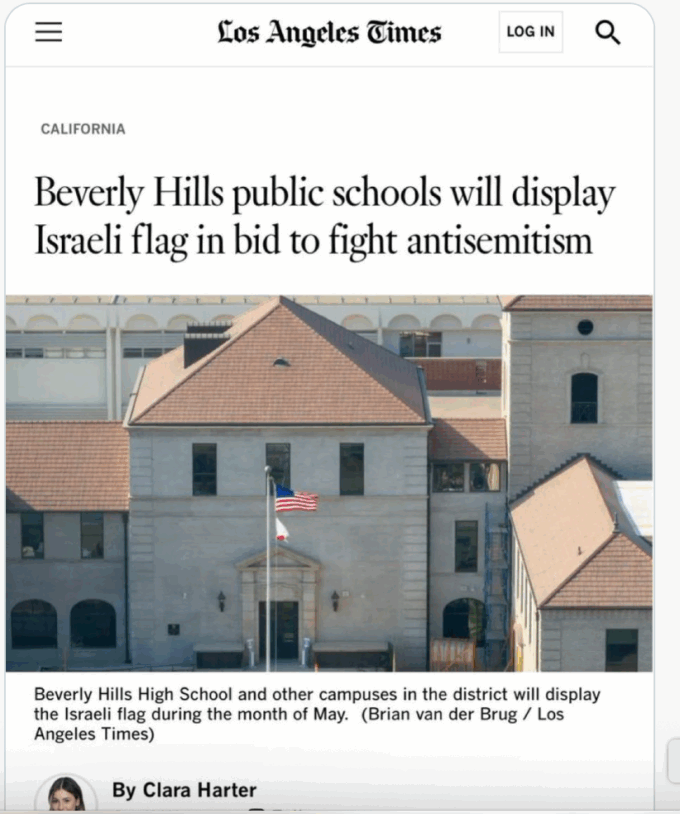
+ Flying the Israeli flag at US schools will almost certainly have the opposite effect from the one used as a justification…
+ The Jewish comedian Jonathan Friedland, who lived in Israel for years, allowed Rep. Ritchie Torres, the fanatical Israel supporter, to expose himself as a robotic and soulless politician, who is insensate to his own moral vacuity and so arrogant as to believe he can accuse Jews of being anti-semitic for opposing a genocide carried out in their name….
Friedland: I think hatred of Jewish people has just exploded in this country. And I think it’s because of our support for what appears to be an absolute brutality.
Torres: You think that’s a justification for anti-semitism? You think Israeli government policy is a justification for anti-semitism. There’s no justification for anti-semitism. Zero justification for anti-semitism.
Friedland: Okay, you’re deflecting again.
Torres: I’m not deflecting. That’s my position.
Friedland: What does it look like to have a flag with a Jewish star, and I’m Jewish, and for kids to be starving now as a result of our government?
Torres: It just sounds like you’re justifying anti-semitism.
Friedland: Are you crazy right now?
Ritchie Torres: “If you have disagreements with the Israeli government, but there is no justification for intimidation or harassment against American Jews
Adam Friedland: “I’m telling you, as a Jew right now, that we are receiving a lot more hate because of what the people with the flag that has a Jewish star on it are doing to other people right now. And I’m telling you as a Jewish person how painful it is for us to stay, and it hurts my stomach to say this, and you’re going to say ‘I disagree, I disagree’, that this is a genocide. And that hurts to say that a Jew can do that. It hurts because we grew up learning about what hatred did. We grew up learning about this! And the same year that Israel was founded, 1948, the world saw the Holocaust as they established standards for what a genocide is. It is the same year the world said, This shouldn’t be a thing that happens.
Torres: I mean, Hamas murdered thousands of people in Israel.
Friedland: So what does that mean?
Torres: That Hamas is a terrorist organization for murdering innocent children and civilians.
Friedland: How many civilians have been killed in this war?
Torres: The war is a tragedy. But…
Friedland: 90 percent of them have been civilians. They’ve killed journalists.
Torres: People have been killed in a war. It’s a tragedy.
Friedland: They’ve killed people waiting for aid.
Torres: But you’re suggesting it’s the policy of the Israeli government to murder civilians. And that’s a notion that I reject.
Friedland: You gotta listen, man. You’ve gotta be like a human being about this.
Torres: People who are dying in the war, which to me is a tragedy, because war is a tragedy.
Friedland: Do you feel in your heart that what you’re saying is right?
Torres: If you remove Hamas…
Friedland: You don’t actually think that…
Torres: Don’t tell me what I believe. I told you what I believe…
Friedland: Why would you believe that?
Torres: Because there are people who see the world differently. I know it’s a shock to you. But there are people who see the world differently than you do.
+ The entire interview is worth watching, if only to see how Friedland’s humane and emotional response to genocide contrasts with Torres’s programmatic callousness…
Here’s how Peter Savodnik, of Bari Weiss’s Free Press, described Friedland’s interview: “The role Friedland is playing is that of the kapo — the Jew articulating and/or acting out the wishes, conscious or unconscious, of the gentile majority. This is literally the world’s oldest (or second oldest) profession.”
+ The question that has perplexed all of Washington, none more vexatiously than Mayor Petebot…

+ A plurality of Americans, 43-28, now say Israel is committing genocide against Palestinians, according to a new YouGov poll. Meanwhile, according to a Reuters survey, an overwhelming majority of Americans, 58-33, believe every country in the UN should recognize Palestine as a nation. The larger these numbers go, the harsher the sanctions will become against those who articulate these increasingly popular beliefs in public…
+ The Trump/Rubio State Department fired Shahed Ghoreishi, its top press officer for Israeli-Palestinian affairs, because he urged the administration to express condolences about journalists killed by Israel in Gaza and publicly oppose the forced displacement of Palestinians, according to internal documents reviewed by The Washington Post.
+ How far is “too far” to take a protest against genocide? Showing up in person? Wearing a kaffiyeh? Holding a sign reading, “Stop starving babies to death?” Chanting “From the River to the Sea”?

+ The United Methodist Church (UMC) will divest from Israel bonds and from other governments maintaining illegal military occupations. The UMC is the first church in the world to make such a pledge.
+ After viewing the most recent cut of Tunisian director Kaouther Ben Hania’s film The Voice of Hind Rajab–which depicts the killing of 6-year-old Hind Rajab and her family by Israeli forces in Gaza last year, incorporating her final pleas for help to the Palestine Red Crescent–Brad Pitt, Rooney Mara, Joaquin Phoenix, Alfonso Cuarón and Jonathan Glazer have joined as executive producers. (Good for you!) The film premieres this week at the Venice Film Festival. Ben Hania’s previous films include The Man Who Sold His Skin and Four Daughters, both nominated for Academy Awards.
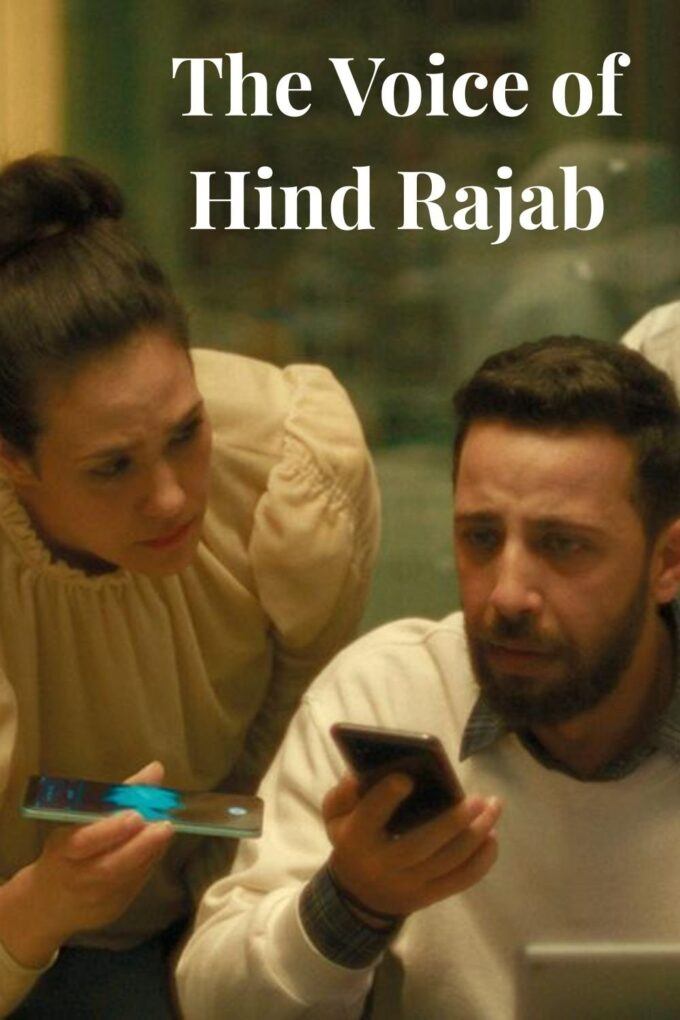
The post Gaza Diary: Can You Imagine? appeared first on CounterPunch.org.
This post was originally published on CounterPunch.org.
-



































































Photograph Source: Kremlin.ru – CC BY 4.0
Russian Foreign Minister Sergei Lavrov told an NBC interviewer last week that the expansion of the North Atlantic Treat Organization was a “violation of Russian security interests” and one of the “root causes” of the war against Ukraine. Russian officials have made these statements in their private meetings with American counterparts, but this is the most explicit public statement since the start of the war three and a half years ago. The conventional wisdom in the United States does not accept NATO expansion as a cause of the war, but I’ve been arguing since the war began that there was such linkage.
Lavrov’s comments make it clear that an end to the war with Ukraine include security guarantees for Russia as well as for Ukraine. It’s unlikely that anyone in the Trump administration understands this linkage, which means that the war is not about to reach a negotiated solution. The United States simplistically blames only President Vladimir Putin for the start of the war, but no Russian leader would have accepted the extensive U.S. and NATO buildup on Russia’s western border.
Lavrov has been critical of Trump’s failure to discuss specifics of a negotiated end to the war, which is typical of Trump’s lack of process in dealing with difficult geopolitical issues. When asked about security guarantees, Trump responded that “We haven’t even discussed the specifics.” Trump still proclaims that he doesn’t know which side to blame for the start of the war. His most absurd statement regarding the war: “We’ll know which way I’m going, because I’m going tot go one way or the other,” he told reporters last week.
In addition to limits on Ukraine’s military buildup and the occupation in Ukraine by western forces, the Russians will push for limits on Western troops based in East Europe, an end to the deployment of a regional missile defense system as well as an end to the permanent deployment of German troops in such Baltic states as Lithuania. Russia will press for limits on U.S. bases in Poland and Romania as well. Even before the war began, Putin in December 2021 proclaimed that Russia demanded talks on the NATO threat to Russian national security.
Lavrov also stated that Ukraine has the “right to exist,” but only if it stops the cultural and linguistic limits on ethnic Russians and Russian speakers who the Kremlin believes “belong to Russian culture.” The majority of the population on the Donbas is ethnic Russian. For the past 30 years, Russian leaders have claimed it is their “duty” to protect those who share the values of the Russian language and the “Russian world” (“Russkiy mir”). Moscow uses the term “near abroad” to defend its support and protection for Russian ethnics throughout the former Soviet empire. Kazakhstan, with its large ethnic Russian population could be a target of similar Russian expansionism.
The Trump administration and U.S. policymakers in general do not seem cognizant of the fact that actions Washington has taken over the past 25 years in East and Central Europe are threatening to Russia. Since the collapse of the Soviet Union in 1991, every U.S. administration has taken advantage of Russia’s national security weakness to expand the U.S. role in the region. Presidents Clinton and Bush ignored warnings not to expand NATO.
Clinton was also responsible for NATO’s bombardment of Serbia 1999 without a UN mandate and without touching base with the Kremlin, which has had a special relationship with Serbia for generations. The Bush administration was a strong supporter of the “color revolutions” in Georgia and Ukraine, where Putin believed there was a strong U.S. and CIA covert role. It was the provocative actions of the Georgian government in disputed territories that led to brief Russian military intervention in 2008. Bush clearly overplayed his hand in threatening Russia by pursuing a special relationship with a strongly nationalistic Georgia.
Bush overlooked the warnings from German Chancellor Angela Merkel to avoid encouraging NATO membership for Georgia and Ukraine. The hardliners in the administration backed off somewhat, but only reluctantly. Bush’s forever wars in Iraq and Afghanistan were perceived as threatening to Moscow because they contributed to greater insurgency and terrorism in areas close to Russia’s borders. The United Sates could have pursued diplomacy to coordinate actions with Russia in these areas, but no U.S. administration was willing to take Moscow seriously in view of Russia’s political, military, and economic weakness. Putin actually offered significant assistance to the United States in the wake of the 9/11 attacks in New York and Washington,
Meanwhile, U.S. policymakers and political analysts as well as the mainstream media totally dismiss the idea that NATO expansion had anything to do with Russia’s use of force. The New York Times and the Washington Post particularly dismissed the idea that “NATO provoked Russia’s invasion.” Again, the conventional wisdom was that Russia was engaging in an “illegitimate response to the hostile actions of a democracy.”
There is good reason for Moscow to believe that the expansion of NATO was a marker of Washington’s return to containment and a threat to its national security. Russia was angered about the expansion from the outset, particularly since President George H.W. Bush and Secretary of State James Baker had assured their Russian counterparts that the United States would not “leap frog” over Germany if the Soviets pulled their 380,000 troops out of East Germany in order to reunify the German state. The past five administrations have pursued a policy of militarism in Europe toward Russia. Contemporary foreign policy experts anticipate a Putin threat to NATO beyond the threat to Ukraine, which portends greater U.S. pressure on Russia. Meanwhile, NATO expansion virtually ensures that a Cold War will exist between the West and Russia for the near future.
The post Russia’s Foreign Minister Cites NATO Expansion as Cause of Ukraine War appeared first on CounterPunch.org.
This post was originally published on CounterPunch.org.
-



































































Photograph Source: @shanghaidaily – x.com
Russian Foreign Minister Sergei Lavrov wore a sweatshirt to the recent Alaska summit that vividly displayed his nostalgic imagination. Written in large Cyrillic letters was “CCCP” or USSR. Like Donald Trump’s red cap featuring the slogan “Make America Great Again,” Lavrov indicated that he, like Vladimir Putin, imagined the Russian Federation returning to its past glory as the Soviet Union. The 70-year-old leaders of the United States and Russia are in time warps. Geopolitics exists in linear time. Countries, like individuals, cannot return to their past glories in circular time.
Nostalgia for the past can be an obsession. I’m no exception. Each season I closely follow the results of the New York Yankees and the New York Knicks to see if they can repeat their past glories. (They have not won major championships since 2009 and 1973, respectively.) Mine is not a simple optimism about the Yankees and Knicks winning games; it is an optimism about the teams returning to their former championship status.
Now it is one thing to imagine a sports team returning to a past dominant position, it’s quite another to imagine a country returning to its past hegemonic role. Can countries or empires which were once dominant return to those previous situations? While sports seasons repeat the same number of games and similar formats to win the ultimate title, geopolitics evolves in time with no similar set of rules or formats. Baseball and basketball have regulated rules and procedures; geopolitics does not.
I know what the Yankees and Knicks need to do to win the World Series and NBA crown. I don’t know what has to happen for the Russian Federation to return to the glory of the Soviet Union. Or for the United States to be truly great again.
Edward Gibbon’s The History of the Decline and Fall of the Roman Empire and Paul Kennedy’s The Rise and Fall of Great Powers present similar temporal perspectives. Both describe how empires/hegemons rose and fell. Lavrov’s sweatshirt, and Trump’s omnipresent cap represent a different temporal perspective. Lavrov/Putin and Trump imagine that their empires/hegemons rose, fell, and will rise again.
When President Putin remarked in the post-summit that “a fair balance in the security sphere in Europe and the world as whole must be restored,” the emphasis was on restored. He implied that that is “the root causes” of the crisis with Ukraine. Putin’s nostalgic imagination is that the post 1945 Soviet Union’s regional hegemony and global power should be restored.
Trump’s cap says much the same. The American hegemonic rise also happened after World War II. The Vietnam War – if one needs a specific starting point – saw the decline of the United States. Trump’s cap’s slogan promises that he will return the U.S. to its post 1945 dominant position. When DJT says “Make America Great Again,” the emphasis is on Again.
Instead of linear time moving forward with new technologies and new geopolitics, Lavrov, Putin, and Trump imagine circular time going back to something that was before. Restored and Again are the keywords. So just as sports team repeat how the game is played, the nature of the schedule and the criteria for becoming champions, Lavrov, Putin, and Trump see geopolitics as circular in time as well.
But geopolitics and sports are not the same. European countries like Spain, Portugal, France, England, and the Netherlands all had their historic periods of geopolitical glory. They all had extraterritorial moments of domination. Today, none of their leaders envisions a return to that position. (The British Commonwealth of Nations is not the same as when “the Sun Never Set on the British Empire.”)
Sports teams can return to their previous glory. Individual athletes, politicians, and movie stars may make comebacks; empires/hegemons cannot.
And who is imagining a return to past glory? Sergei Lavrov is 75 years-old, Vladimir Putin 72 years-old, and Donald Trump is 79 years-old. All three are caught in the same nostalgic imagination. All three aging leaders project their temporal decline on a geopolitical imagination of a return to their countries’ past glories under their leadership. All three are caught in the same nostalgic time warp.
Individually, we would all like to remain young and healthy. We would all like to de-age and increase our longevity. Botox, plastic surgery, injections, exercise and pills are all part of that effort to counter linear time. Pictures of Putin’s physical prowess are regularly presented to defy his 72 years. Trump loves to show himself energetically playing golf; he often mocked Joe Biden’s age when he himself was in his late 70s. His favorite songs, the oldies but goodies his staffers play when he is in a bad mood, are “Memory” from Cats, and the Rolling Stones’ “You Can’t Always Get What You Want.”
Lavrov/Putin and Trump have taken the personal narrative of countering aging to a nostalgic, geopolitical level. 70 year-old men’s desires to maintain their youth has become part of a larger geopolitical narrative. Science may have succeeded in the de-extinction of the dire wolf, but there is no indication it will succeed with infinitely prolonging human longevity or restoring a country’s empire. Empires/hegemons rise and fall; they do not rise again. History may repeat itself in different forms, but geopolitics does not. Nostalgia for the past has its limits. And seventy year-old men should act their ages.
The post Sergei Lavrov’s Sweatshirt and Putin/Trump’s Nostalgic Imaginations appeared first on CounterPunch.org.
This post was originally published on CounterPunch.org.
-



































































CBC News, YouTube screenshot.
Anyone who has doubted the Chomsky-Herman propaganda model of mass media has surely had their skepticism tested over the past twenty-two months. The axiom that media “serve to mobilize support for the special interests that dominate the state” by distorting or suppressing facts is nowhere more evident than in Western reporting on Gaza. Likewise, the model’s depiction of “worthy” versus “unworthy” victims – portraying “murderous aggression as a defense of freedom” – perfectly encapsulates mainstream coverage of Israel’s indiscriminate killing of Palestinian civilians. Consent for this barbarity could not have been manufactured without the uniform complicity of a pliant press. Public media should provide a corrective to corporate distortions; yet Canada’s public broadcaster, the CBC, has repeatedly failed in this duty. By refusing to deliver accurate, comprehensive, and contextually rich reporting on Israel’s assault, it has denied Canadians the information they need to act on conscience and to pressure their government to help end the savagery. In effect, the CBC has made Canadians complicit in genocide.[1]
Like other Western media, Canadian coverage of Gaza suffers from a structural bias rooted in concentrated ownership. Postmedia Network, controlled by a U.S.-based hedge fund, controls roughly 112 Canadian newspapers, all pushing a uniform pro-Israel editorial line. Its flagship, the National Post, churns out content that reads as though it were ghostwritten by Likud — if not for the simplistic formulations more fitting for a middle-school newsletter. Faced with this bleak media landscape, many Canadians turned to the CBC, expecting a more impartial perspective. What they found was a public broadcaster that mirrored the same misleading narratives and manipulative reporting, offering coverage no more reliable than its corporate counterparts. And as Canadians voiced frustration, the CBC responded not with reform, but with craven, self-justifying apologetics.
As with its Western peers, the CBC has systematically stripped essential context from its reporting. The Hamas attack on October 7, 2023, was rarely framed against the backdrop of Israel’s 75-year occupation, repeated international-law violations, or dozens of UN Security Council resolutions condemning its conduct. As Israel’s brutal assault unfolded, the CBC downplayed or omitted critical information. Landmark legal rulings were barely acknowledged: in January 2024, the International Court of Justice (ICJ) found Israel’s actions amounted to a “plausible” genocide; in July, the ICJ declared Israel’s 57-year occupation illegal; in September, the UN General Assembly voted in favor of sanctions, and arrest warrants were issued for Israeli leaders. These decisions, briefly mentioned at the time, vanished from coverage, directly contradicting the CBC’s mission “to learn, understand, and clearly explain the facts to our audience.” During her November 2024 visit to Canada, UN Special Rapporteur Francesca Albanese presented an opportunity to probe the nation’s legal obligations and Israel’s atrocities. CBC ignored Albanese’s calls for a Canadian audit of collaborations with Israel, failed to cover her report documenting Gaza’s “scorched-earth catastrophe,” and did not report that her meetings with Canadian officials were abruptly cancelled, which she attributed to “very vocal, very virulent, very aggressive” pressure from pro-Israel lobby groups. These omissions deprived Canadians of essential knowledge that might have compelled political action.
The CBC also suppressed coverage of the deliberate attack on Gaza’s healthcare system. Letters from U.S. and Canadian healthcare workers warned of the methodical destruction of medical infrastructure, yet the network ignored them. The UN Independent International Commission of Inquiry classified these acts as war crimes and crimes against humanity, and the Lancet estimated Gaza’s death toll at 186,000, yet the CBC suppressed this incriminating evidence, depriving audiences of any grasp of the true magnitude of the crisis and concealing Israel’s premeditated assault on civilian life. Israel’s media blackout in Gaza, and the murder of nearly 200 journalists, likewise received minimal coverage. Even during an aid-drop flight over Gaza, the CBC acceded to Israeli restrictions against filming aerial footage, while ITV News broadcast stark images of the devastation.
CBC’s Office of the Ombudsman, under Jack Nagler, received a flood of complaints. Although the network tried to suggest that complaints were evenly split between pro- and anti-Israel voices, the reality is quite different: most of the pro-Israel complaints came not from individuals but from well-funded organizations – chief among them Honest Reporting Canada (HRC), a billionaire-backed lobby closely aligned with the Israeli government. Nagler euphemistically described HRC as merely “an organization which monitors media coverage of Israel and the Middle East” — analogous to calling the Third Reich an institution dedicated to social reform: technically accurate, but grotesquely evasive of its true purpose. HRC attacks and suppresses any critique of Israel, frequently using antisemitism smears, and nearly 40% of its alerts targeted the CBC. Nagler’s failure to disclose these dynamics is inexcusable. His reviews focus narrowly on content, ignoring the most serious flaw: the CBC’s persistent contextual omissions. In his assessments, Nagler routinely defaults to a “both sides” fallacy, the deliberate pretension that there is equivalence in the asymmetrical power relationship between Israel and Gaza. And, predictably, the reviews almost always find that the CBC upheld its Journalistic Standards and Practices (JSP), with only token criticisms on minor points, and he too often concedes points to HRC, lending legitimacy to its campaign to distort reality.
Numerous examples illustrate the absurdity. To highlight a few illustrative cases: a complainant argued that a host’s “mhm” response to a guest mentioning Gaza’s siege signaled assent and was therefore biased against Israel. Nagler accepted that it could have “affected the way listeners would interpret the segment” – a conclusion that is not only implausible but that also blatantly ignores the undeniable factual reality of Gaza’s siege. A review of the October 17, 2023 strike on al-Ahli Baptist Hospital found Israel’s denial dubious given its damage-control efforts, including promoting a fabricated video and fake audio recordings. Ombudsman Nagler defended the CBC for emphasizing Israeli denials, praising the network for treating the IDF as a “more reliable source” than Hamas. HRC challenged a story about a Palestinian girl who lost both legs in an Israeli strike, claiming Israel’s responsibility was unproven. Nagler admitted Israel was the “obvious” culprit but conceded the complaint, ignoring abundant evidence such as UNICEF’s report documenting “the largest cohort of pediatric amputees in history.” That several of the reviews garnered praise from Honest Reporting Canada is, to say the least, troubling – and deeply revealing. Receiving accolades from such a deceptive and compromised organization raises serious questions about the impartiality and credibility of the CBC’s oversight process.
Independent media critics, most notably the Canadian news website, The Breach, have repeatedly exposed CBC’s biased and substandard reporting. One former CBC producer documented a “chilling effect” in which Palestinian guests were cancelled and staff faced pressure to self-censor. The producer ultimately resigned after being smeared as antisemitic. Editor-in-Chief Brodie Fenlon responded defensively, dismissing her criticisms as “broad conclusions” and framing the controversy as an insoluble “personal and divisive” matter. His maudlin, self-pitying apology, lamenting “friends or families pulled apart by this story” and moments when CBC “stumbled,” amounts to a hollow façade of remorse. It sidesteps systemic issues of framing, sourcing, and omissions. It also ignores a fundamental truth: for one side of the so-called ‘divide’, the emotional toll is unimaginable suffering, while for the other, it is mostly the discomfort of confronting its own complicity in that suffering. And if there is any ignorance about “the story’s history and complexities,” culpability for that lies squarely with the CBC and other Western media due to their near-total omission of the historical context leading up to October 7.
CBC’s coverage exemplifies the mechanics of manufactured consent: selective language, historical erasure, and dehumanization. Gaza has endured the heaviest aerial bombardment in history — 100,000 tons of explosives, equivalent to six Hiroshimas, dropped on a densely populated enclave. Official counts of 62,000 deaths are almost certainly underestimates; some experts suggest the toll approaches half a million. Children account for a devastating proportion, with estimates of 18,000 killed and more than 50,000 killed or injured. If Canadians were consistently confronted with this reality, public outrage would almost certainly compel government action. Instead, the CBC shields its audience from these facts, ensuring moral indifference and passive complicity.
Throughout the crisis, the CBC has consistently capitulated to pro-Israel lobby pressure. CBC’s choices have not merely misinformed; they have implicated Canadians in the ongoing genocide. One CBC staff member described the network’s reporting as “the type of coverage that will one day be taught in schools and museums as a factor that contributed to genocide.” This grim judgment reflects a painful truth: the broadcaster has distorted reality, misrepresented victims, and shielded audiences from the ethical urgency of Gaza’s destruction.
While these journalists and their managers must eventually confront their own conscience, the painful reality is that the rest of us have been implicated in their failure. As Chomsky declares, “What the media are doing is ensuring that we do not act on our responsibilities, and that the interests of power are served, not the needs of the suffering people, nor even the needs of [domestic citizens], who would be horrified if they realized the blood dripping from their hands.” The CBC not only has distorted the reality of Israel’s enormous crimes, but it also has made Canadians complicit in them, their hands stained with the blood of innocent Palestinians.
Notes
1. Edward S. Herman and Noam Chomsky, Manufacturing Consent: The Political Economy of the Mass Media (New York: Pantheon Books, 1988), pp. xi, 37. ↑
The post Gaza and the CBC: The Public Broadcaster Betrays Its Mandate appeared first on CounterPunch.org.
This post was originally published on CounterPunch.org.
-
In many quarters, the New York Times’ David Sanger is considered the country’s best diplomatic journalist. After a recent article in the NYTs, titled “Trump’s Personal Diplomacy Results in a Strategic Muddle” maybe it’s time to scrutinize his work more carefully. The article made no sense whatsoever in trying to compare the personal styles of Donald Trump and Theodore Roosevelt. Sanger believes the comparison is relevant and dispositive because both Trump and Roosevelt rely on their “powers of persuasion as the central element of success in America foreign policy—and ending wars.”
A comparison of Trump and Roosevelt is flawed and fallacious on any level. Roosevelt was arguably one of the most interesting presidents in American history; Trump is the most vindictive president in American history and not even compos mentis. Roosevelt played the crucial role as the mediator in the Treaty of Portsmouth, which formally ended the Russo-Japanese War in 1905. He initiated the peace talks, despite the initial reluctance of both Russia and Japan. He skillfully guided the negotiations, and ultimately earned the Nobel Peace Prize in in 2006. Roosevelt was a strategic thinker, who understood the importance of the balance of power for U.S. interests in East Asia. As a result, he offered his “good offices” to mediate the conflict. He maintained a neutral stance throughout the process, which was key to gaining the trust of both Moscow and Tokyo.
Roosevelt is known as the “Rough Rider,” the hero of the Spanish-American War, who led a series of charges up Kettle Hill towards San Juan Heights on his horse, Texas. The Rough Riders followed on foot. Trump is the classic Chicken Hawk, who claimed bone spurs to avoid military service during the Vietnam War. In an interview during his first campaign, he couldn’t remember which foot was affected, which added to speculation that there were no bone spurs. The fact that he dictated the letter to the physician who ultimately arranged the deferment contributed to the view that Trump was lying once again.
Roosevelt’s interest in foreign affairs was no less intense than his interest in domestic reform. He was conscious of America’s growing stature as a world power and concerned that continued hostilities in East Asia would disrupt the balance of power. Roosevelt proclaimed himself “peacemaker,” and used his considerable energy—and his tact—to initiate the conference and bring about a treaty. It was no easy task. As for Trump, he used his second campaign to say that he could bring an end to the Russian-Ukrainian War in 24 hours. The mainstream media continues to cite this claim as if it were reasonable or in some way imaginable.
Trump’s face-to-face negotiations with Kim Jong-un in the first term and Putin in the second term have been risible, even disastrous. Trump was seeking disarmament with North Korea, and Kim has responded with a dramatic expansion of his nuclear arsenal. Trump was seeking a cease-fire from Russia, but Putin has responded with the heaviest bombardment of the war that began in February 2022. Roosevelt was a neutral mediator between Russia and Japan, but Trump wavers between accusing Ukraine with starting the war or emphasizing that Ukraine remain a free, independent country. It is this inconsistency that had the NATO countries and Ukraine on a virtual death watch when Trump and Putin met in Anchorage, Alaska.
Trump could not be more different from Roosevelt in all aspects. Trump is not a strategist; he is clueless regarding the creation of a process for negotiations; he is not a diplomat; he lacks a national security and foreign policy team. The unsuitability of Secretary of State Marco Rubio, who also serves as national security adviser, has left the field of negotiations to a billionaire real estate investor from Florida, Steve Wytkoff, who is regularly corrected by his staff for his numerous misstatements of fact.
Ultimately, negotiations have a chance to succeed when there are capable leaders at the table; there is a non-partisan mediator; and there are reasonable and shared goals regarding an end state. As long as Trump is playing a major role in the negotiations, there is little likelihood of success. Trump is a particularly dangerous partner for Ukrainian President Volodymyr Zelensky and a particularly naive counterpart to Putin. Trump’s expectation that Putin would agree to a cease-fire without getting anything in return was particularly risible. His promotion of some type of the NATO charter’s Article Five mutual defense guaranty without a role for the United States was a nonstarter.
As a result, Putin got a diplomatic triumph—a summit with the United States on U.S. soil—and Trump got nothing. A group of European heads of state are doing their best to keep Trump’s feet to the fire, but the prospects for Ukrainian and European security will remain uncertain.
The post The NYT’s David Sanger Foolishly Likens Trump to Teddy Roosevelt appeared first on CounterPunch.org.
This post was originally published on CounterPunch.org.
-
The mainstream media are describing John Bolton as an experienced diplomat and a serious analyst. He was neither. Many members of the media are also giving the Federal Bureau of Investigation credibility as a fair-minded bureaucracy that would not raid Bolton’s office and home without honoring the requirement that at least two magistrate judges accept the case for Bolton’s guilt. Over the past hundred years, there have been numerous examples of the FBI doing the dirty work of Democratic and Republican administrations, particularly violating laws to protect immigrants and dissidents. The racism of J. Edgar Hoover over a period of more than 50 years stands out.
First, let’s look at the FBI in terms of the Palmer Raids of the 1920; the Hoover period; Japanese internment during World War II, and the policy of Cointelpro, a counter intelligence program that broke legal and constitutional grounds throughout the Vietnam War. The Palmer raids were conducted by the Department of Justice and the FBI without arrest warrants. FBI agents directed officers to seize documents at will and permitted unrestrained force. These acts led to numerous deportations of so-called radicals and communists who were suspected of threatening the security of the United States. Currently, Secretary of State Marco Rubio is similarly targeting international students in the United States, particularly at elite institutions.
The FBI played a direct role in the internment of Japanese-Americans in WWII, conducting surveillance and wholesale arrests of community leaders and suspected sympathizers after the attack on Pearl Harbor. FBI efforts directly contributed to the mass removal and confinement of over 120,000 people of Japanese descent. Today’s paranoia about people of color is very reminiscent of the earlier fear of the “Japanese hand playing the powerful yet silent note” behind the “negro movement” and other “agitory elements.” There was no protest then; there is insufficient protest today.
Seymour Hersh’s excellent reporting in the 1970s exposed the illegal domestic spying of the FBI, the CIA, and the National Security Agency to disrupt the anti-war movement. The FBI actively disrupted lawful activities of numerous individuals and organizations, including Martin Luther King, Jr. Trump’s identification of “antifa” as the “greatest threat to our internal security is reminiscent of Hoover’s designation of the Black Panther Party as a similar threat. Of course, there was a Black Panther Party; there was no such thing as an “antifa” party.
Second, there is the sordid government service of John Bolton, who was more than willing to do Donald Trump’s bidding before he wasn’t. Bolton, who used student deferments to avoid serving in Vietnam, is the classic Chicken Hawk. Just like Trump. Bolton supported the Vietnam War, the Iraq War, and the recent U.S. bombardment of Iran’s nuclear facilities. He endorsed preemptive military strikes in North Korea and Iran, and lobbied for regime change in Cuba, Iran Libya, North Korea, Syria, Venezuela and Yemen. When George W. Bush declared an “axis of evil” in 2002 consisting of Iran, Iraq, and North Korea, Bolton added an even more bizarre axis of Cuba, Libya, and Syria. Hardly the work of an “experienced diplomat.”
When Bolton occupied high-level positions at the Department of State and the United Nations, he regularly ignored assessments of the intelligence community and made false arguments regarding weapons of mass destruction in the hands of Cuba and Syria in order to justify the use of force. As Bush’s undersecretary of state for arms control and disarmament, Bolton issued his own white papers on WMD that were challenged regularly by the intelligence community. He used his own reports when testifying to congress in 2002 in order to make the case for use of force in Iraq. Hardly the work of a “serious analyst.”
Even the former chief of intelligence at the Department of State, Carl Ford, told the Senate intelligence committee that Bolton was a “serious abuser” in pressuring intelligence analysts. it’s important to remind ourselves who Bolton really is. In Ford’s words: “I’ve never seen anybody quite like Secretary Bolton…in terms of the way he abuses his power and authority with little people.” In my 25 years as an intelligence analyst at the CIA, there was never a high-level official who politicized intelligence as frequently as John Bolton.
In other words, Trump and Bolton are in many ways two peas in a pod. Even a right-wing former toady becomes an enemy when he jumps ship.
It is important that the Bolton affair does not distract us from the current threat to American governance, particularly in view of next year’s congressional elections. There is an authoritarian president in the White House with no interest in the rule of law; a strong advocate for presidential power in terms of the Attorney General of the United States, toadying loyalists heading up the FBI, the CIA, the Department of Homeland Security, and even serving as the Director of National Intelligence. How is it possible for any U.S. citizen to have faith in law enforcement with the FBI under the “leadership” of Kash Patel and Dan Bongino?
In sending agents from the FBI, the U.S. Marshals Service, the Drug Enforcement Administration, and the Bureau of Alcohol, Tobacco, Firearms and Explosives to the streets of so-called “sanctuary cities,” we must recognize the potential harm to peaceful demonstrations and even elections. Washington, DC has already surrendered. Additional cities in blue states who happen to have Black mayors, such as Chicago and Chicago, are also being targeted. It is essential that these cities do not become petri dishes for studying the death of American democracy.
The post Remembering the FBI’s Deceit and John Bolton’s Dangerous Career appeared first on CounterPunch.org.
This post was originally published on CounterPunch.org.
-


































































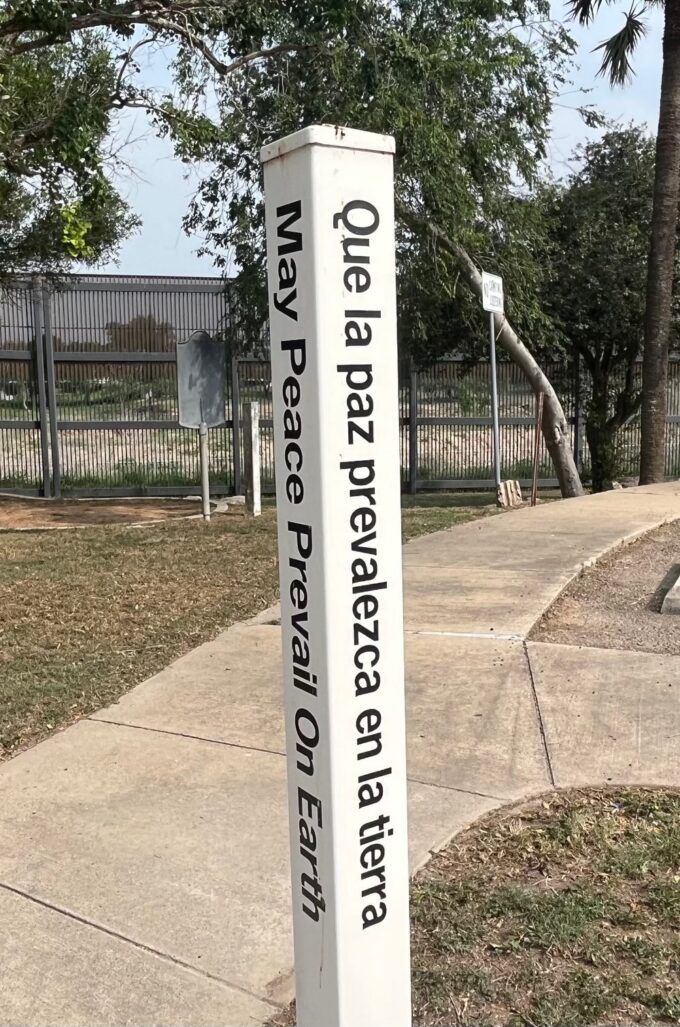
Asking for peace in front of the border wall in Brownsville, Texas. Photo: Todd Miller.
L. J. was outside her house, about 10 miles from the U.S.-Mexico border in rural Arizona, when she saw five people slowly walking down her driveway, all dressed in camouflage. At first she was startled. But after talking to the small group, she found out that they were from Guatemala en route to jobs up north. Agents had come down on them with a helicopter, stirring up so much dust that they ran. Now they were afraid Border Patrol was on their tail. They were lost, disoriented, thirsty, and hungry.
This happened several years ago.* I highlight this story because of what L. J. did next. She could have called Border Patrol and turned the group in. She could have given them water and sent them on their way. But she did something else, going above and beyond in a way that cut through the dire narratives that often plague the borderlands.
Before I get to that, though, let’s review what militarization looks like on the border today. Since Donald Trump took office in January, his administration has deployed 8,500 active-duty military to the U.S.-Mexico border, turned vast areas of the border into restricted military zones known as National Defense Areas, deployed Stryker combat vehicles to the NDAs, and built large detention camps on military bases like Fort Bliss in El Paso. This is only the last eight months, but it follows three decades of persistent border militarization executed by multiple administrations, both Democratic and Republican. Over these decades, the U.S.-Mexico land border has become one of the most militarized and deadly places on the planet.
In other words, it is time to retire the term border security. It is inaccurate. What we are witnessing on the border is an act of war. This war has been underway for a long time, whether we date it from the Pentagon’s low-intensity conflict doctrine (which spawned border strategy in the 1980s, partly based on counterinsurgency operations in Central America) or in the aftermath of the 1848 Mexican-American War, in which the U.S. seized nearly 50 percent of Mexican territory, the origin of much of today’s 2,000-mile border.

Map of Mexico from 1847 before the Treaty of Guadalupe Hidalgo. (Image: J. Distrunell, 102 Broadway, New York, Public domain, via Wikimedia Commons) A long historic process has created the conditions enabling the Trump administration to go to the extreme, to effectively declare war at the border without using those precise words, justified by the tactical, repetitive use of “invasion” as a pretext. That process is made possible by the mind-numbing term border security, which obscures violence and war, twisting it into “protection.” And how could anyone oppose protection?
The border wars are unconventional. No heroic military documentary would feature a group of defenseless Guatemalans getting dusted by a helicopter. Most border brutality occurs far from the media’s cameras, in distant deserts and seas, not just on U.S. borders but around the world. It’s not very cinematic, since enforcement targets some of the most vulnerable people on the planet—people who have suffered greatly from violence and persecution, war, environmental devastation, and severe economic inequality—sometimes all four at once. Globally, the International Organization for Migration’s Missing Migrants Project has documented more than 72,000 deaths of people crossing borders since 2014, which the organization stresses is an undercount, possibly a massive one. Last year was the most deadly yet for migrants. If border security were a person, it would be arrested for assault; it would be arrested for murder.
In the end, it is an act of war. And the silver lining is that war summons the peacemakers.
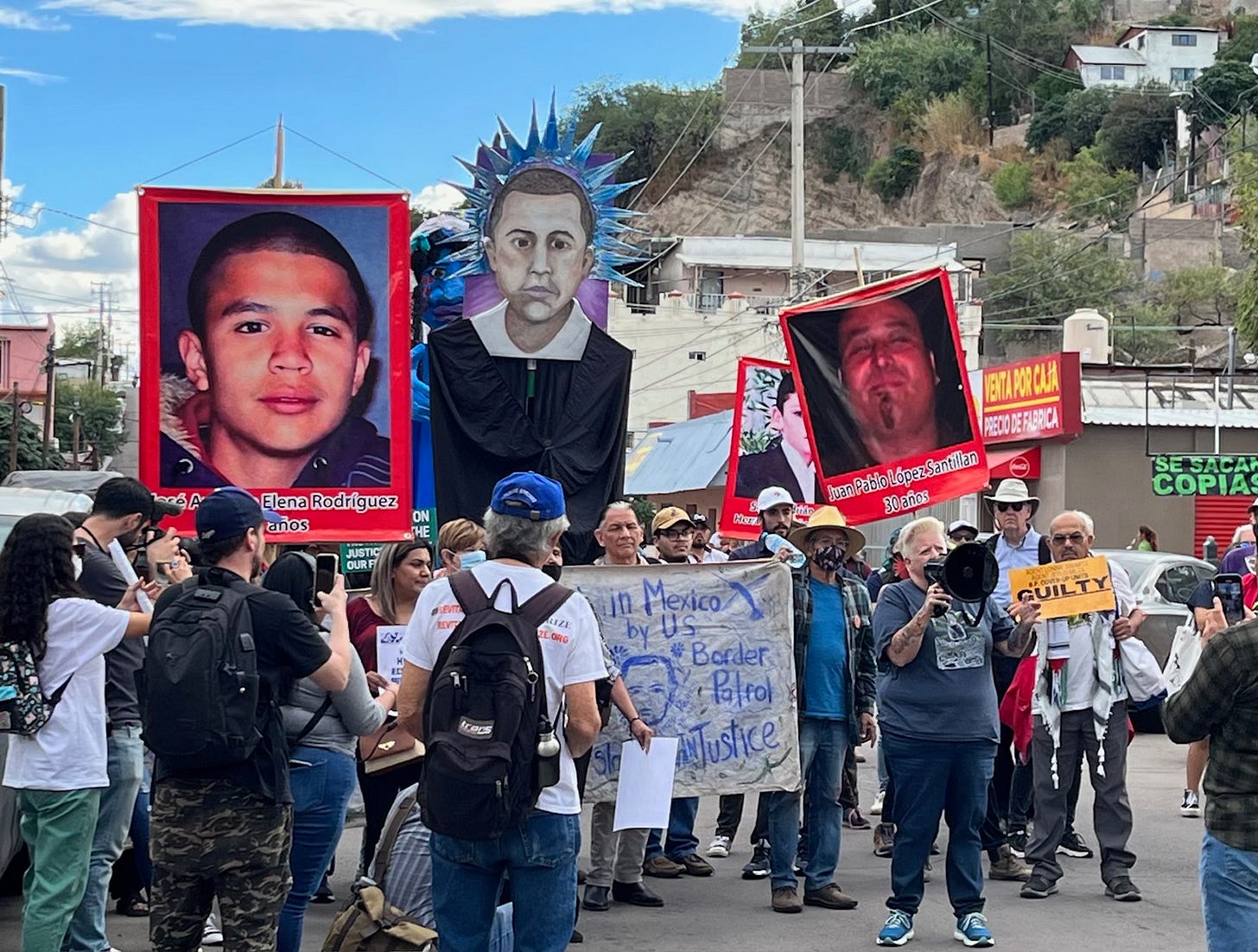
A vigil remembering the people killed in the U.S. Mexico borderlands with former U.S. Border Patrol agent and author Jenn Budd leading the march in October 2022. (Photo by Todd Miller) In late July, I attended the Veterans for Peace annual conference to speak on a panel about border issues. It was inspiring to be around so many people who had witnessed the horrors of war and who now promote and practice peacemaking, often at great risk, including court-martial. Throughout the weekend, a large screen featured a feed from a freedom flotilla, with a VFP representative aboard, carrying food aid to the Gazan shores. As anticipated, the feed abruptly cut off when the boat was intercepted by the Israeli military. The flotilla evoked the world’s historic peacemakers: Martin Luther King Jr., Mahatma Gandhi, among many others. There is a common thread among those who have intervened in places of great injustice, articulating a new vision during those interventions—a vision profoundly different from the local reality, brought forth at great risk to their own well-being. I looked across the conference hall and saw hundreds of people like this including Dora Rodriguez, who sat right next to me, the founder of the human rights organization Salvavision.
Later, I thought about what L. J. did that day on the border. The borderlands are filled with peacemakers—whether organizations, communities, or individuals. They just need to be recognized, brought out from behind the illusory blockade of “border security.”
That group of Guatemalans who walked up L. J.’s driveway had the hardened faces of people who had been through this border war. L. J. invited the group into her house, served them fresh, clean water, and opened up her bathroom for them to take showers. Then she began to make breakfast. Except it wasn’t just breakfast; it was a feast, like a holiday feast. She put a leaf in the dining room table. She laid out cloth napkins. She made scrambled eggs the Guatemalan way, with onions and tomatoes; she made black beans, heated corn tortillas, cut avocado, fried potatoes, and produced a fruit plate piled high with melons, peaches, and cherries. “I had baked blueberry muffins the day before, and not a crumb was left,” she told me.
A friend of L. J.’s later told her, “You didn’t have to do that.” The friend said, “They were already used to eating whatever canned food they could carry” and drinking cloudy water, possibly from a cattle trough and infested with bacteria. L. J. responded, “We need for people to feel like the human beings they are.” L. J. said this knowing that at any moment, Border Patrol could storm her house and accuse her of several felonies. When I asked her if she was afraid of that, she smiled and said there was nothing else she could do.
L. J.’s actions, however small, carried a vision of not only a world where people help each other, but also the type of world that Robin Wall Kimmerer writes about in The Serviceberry: Abundance and Reciprocity in the Natural World, a world where everybody flourishes. “A perception of abundance,” Kimmerer writes, “based on the notion that there is enough if we share it, underlies economies of mutual support.”
Perceptions of abundance and mutual support, however, become difficult with the One Big Beautiful Bill Act (Trump’s crowning achievement, signed into law in July), which cuts health care, housing, clean energy, among other things, to fund what would amount to the most significant increase in border and immigration enforcement in U.S. history. While this follows a long history of reducing basic human services as border and military budgets rise, the bill puts these two distinct trends together with crystal clarity.

In Myanmar, peacemakers give bouquets of flowers to a line of riot police during a demonstration against the military in February 2021. (Photo by STR/AFP via Getty Images) But the good news is that the opposite can also be done. Border budgets can be cut back to fund, say, programs like Medicaid.
Perhaps part of the peacemaking task in the borderlands is to reclaim the word security from militarism, to discard border security and replace it with human security—a distinct approach to security that prioritizes the well-being of individuals and communities, that empowers people, and that addresses any threats to their livelihood, dignity, and survival.
Border funding could be cut to finance a system in which people don’t drink poisoned water, as in Flint, Michigan; don’t end up bankrupt after going to college or a hospital; have a roof over their heads. It could even fund an authentic and durable response to the changing climate. Real security measures.
At the very least, in these times, we have to set aside the dire, predictable narratives attached to the borderlands and explore new ways of thinking. This might come at a risk, but like L. J. said, what else is there to do?
Bring on the peacemakers.
* This story is taken from Todd Miller’s book Build Bridges, Not Walls: A Journey to a World Without Borders.
The post Peacemaking in the Borderlands: A Reflection on the Farce of “Border Security” appeared first on CounterPunch.org.
This post was originally published on CounterPunch.org.
-



































































Image by TS.
The killing of seven Palestinian journalists and media workers in Gaza on August 10 and five more on August 25 has prompted verbal condemnations, yet has inspired little to no substantive action. This has become the predictable and horrifying trajectory of the international community’s response to the ongoing Israeli genocide.
By eliminating Palestinian journalists like Anas al-Sharif and Mohammed Qraiqeh, Israel has made a sinister statement that the genocide will spare no one. According to the monitoring website Shireen.ps, Israel has killed nearly 270 journalists since October 2023.
More journalists are likely to die covering the genocide of their own people in Gaza, especially since Israel has manufactured a convenient and easily deployed narrative that every Gazan journalist is simply a “terrorist”. This is the same cruel logic offered by numerous Israeli officials in the past, including Israeli President Isaac Herzog, who declared that “an entire nation” in Gaza “is responsible” for not having rebelled against Hamas, effectively stating that there are no innocent people in Gaza.
This Israeli discourse, which dehumanizes entire populations based on a vicious logic, is frequently repeated by officials who fear no accountability. Even Israeli diplomats, whose job in theory is to improve their country’s image internationally, frequently engage in this brutal ritual. In comments made in January 2024, Israeli ambassador to the UK, Tzipi Hotovely, callously argued that “every school, every mosque, every second house has access to tunnels,” implying that all of Gaza is a valid military target.
This cruelty of language would be easily dismissed as mere rhetoric, except that Israel has, in fact, according to Euro-Med Human Rights Monitor reports, destroyed over 70% of Gaza’s infrastructure.
While extremist language is often used by politicians around the world, it is rare for the extremism of the language to so precisely mirror the extremism of the action itself. This makes Israeli political discourse a uniquely dangerous phenomenon.
There can be no military justification for the wholesale annihilation of an entire region. Yet again, the Israelis are not shying away from providing the political discourse that explains this unprecedented destruction. Former Knesset member Moshe Feiglin chillingly said, last May, that “Every child, every baby in Gaza is an enemy… not a single Gazan child will be left there.”
But for the systematic destruction of a whole nation to succeed, it must include the deliberate targeting of its scientists, doctors, intellectuals, journalists, artists and poets. While children and women remain the largest categories of victims, many of those killed in deliberate assassinations appear to be targeted specifically to disorient Palestinian society, deprive it of societal leadership, and render the process of rebuilding Gaza impossible.
These figures powerfully illustrate this point: according to a report released by the United Nations Office for the Coordination of Humanitarian Affairs, based on the latest satellite damage assessment conducted in July, 97% of Gaza’s educational facilities have been affected, with 91% in need of major repairs or full reconstruction. Additionally, hundreds of teachers and thousands of students have been killed.
But why is Israel so intent on killing those responsible for intellectual production? The answer is twofold: one unique to Gaza, and the other unique to the nature of Israel’s founding ideology, Zionism.
First, regarding Gaza: Since the Nakba in 1948, Palestinian society in Gaza has invested heavily in education, seeing it as a crucial tool for liberation and self-determination. Early footage shows classrooms being held in tents and open spaces, a testament to this community’s tenacious pursuit of knowledge. This focus on education transformed the Strip into a regional hub for intellectual and cultural production, despite poorly funded UNRWA schools. Israel’s campaign of destruction is a deliberate attempt to erase this generational achievement, a practice known as scholasticide, and Gaza is the most deliberate example of this horrific act.
Second, regarding Zionism: For many years, we were led to believe that Zionism was winning the intellectual war due to the cleverness and refinement of Israeli propaganda, or hasbara. The prevailing narrative, particularly in the Arab world, was that Palestinians and Arabs were simply no match for the savvy Israeli and pro-Israeli public relations machine in Western media. This created a sense of intellectual inferiority, masking the true reason for the imbalance.
Israel was able to “win” in mainstream media discourse due to the intentional marginalization and demonization of Palestinian and pro-Palestinian voices. The latter had no chance of fighting back simply because they were not allowed to, and were instead labeled as “terrorist sympathizers” and the like. Even the late, world-renowned Palestinian scholar Edward Said was called a “Nazi” by the extremist, now-banned Jewish Defense League, who went so far as to set the beloved professor’s university office on fire.
Gaza, however, represented a major problem. With foreign media forbidden from operating in the Strip per Israeli orders, the Gazan intellectual rose to the occasion and, in the course of two years, managed to reverse most of Zionism’s gains over the past century. This forced Israel into a desperate race against time to remove as many Palestinian journalists, intellectuals, academics, and even social media influencers from the scene as quickly as possible—thus, the war on the Palestinian thinker.
The Israeli logic, however, is destined to fail, as ideas are not tied to specific individuals, and resilience and resistance are a culture, not a job title. Gaza shall once more emerge, not only as the culturally thriving place it has always been, but as the cornerstone of a new liberation discourse that is set to inspire the globe regarding the power of intellect to stand firm, to fight for what is right, and to live with purpose for a higher cause.
The post The War on Truth: Why Palestinian Journalists Are Being Systematically Erased appeared first on CounterPunch.org.
This post was originally published on CounterPunch.org.
-












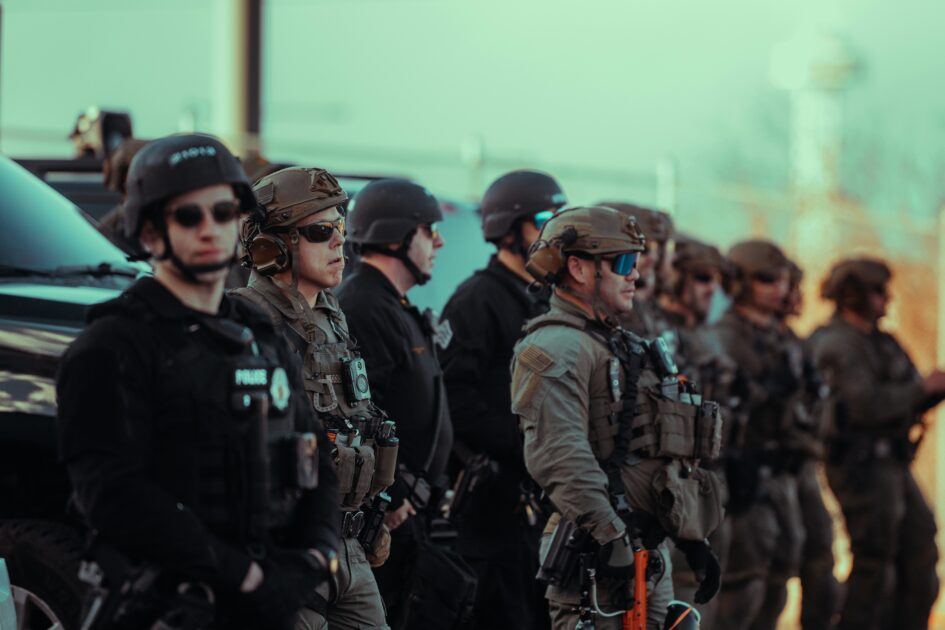

































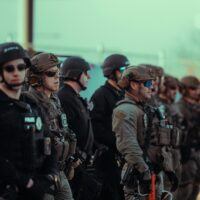




















Image by Colin Lloyd.
In my 50-some years of community and political ministry, and organizing that resisted Boston’s test with “stop and frisk” after the hoax of Charles Stuart murdering his wife and blaming it on a Black man, I thought I had seen it all. Then, when Edward Coristine, a 19-year-old former DOGE worker and software engineer known online as “Big Balls,” was assaulted in Dupont Circle in what was reportedly a carjacking incident, it was deja vu of Boston and the neighborhood where I lived, Roxbury, being turned upside down again. I thought I had already seen the worst of white reaction to Blackness, but again I was wrong. Trump and the MAGA/white supremacist chorus used the Coristine incident as justification for a city gone wild that needed to be brought under control.
I listened to all the political hyperbole on the airwaves and in social media, which I had heard before. It was another version, I thought, of Raymond Flynn, Mayor of Boston during the Charles Stuart hoax, declaring that it was a terrible night in Boston and turning loose the police on the Black community and advancing tactics like ‘stop and frisk.’ I listened and heard once again words and statements that would justify the Trump/MAGA/Authoritarian regime’s initiatives to demonstrate to his white base that at all cost white life will be protected, and the Black culprits brought into line. It seems that everyone has conveniently forgotten the feigned genesis that was used to justify this attack upon our city, on our democracy, home rule in DC, and civilian government.
I watched and listened to the legal battle that unfolded between the Trump Administration and the DC Attorney General about who would be in charge of this new municipal/federal police force. The DC attorney general took the matter to court, and it was determined that the DC Chief of Police would remain in charge – for now. Still, in compromise, the DC government bowed to the anti-sanctuary sentiments dictated by the Trump regime. Trump talked about how dangerous DC was, and that it is plagued with crime, that visitors are in danger for their lives, that the parks need to be cleaned up from homeless encampments, Confederate statues needed to be replaced, and the cracked marble on monuments need to be repaired.
Trump stressed the dangers and disrepair of Washington, DC. Challenged the Mayor, Muriel Bowser, in her management of the city, and recently has threatened to erase home-rule altogether and completely “federalize” the city. Mayor Bowser first attempted to appease the Trump/MAGA/White Supremacist regime as it came to power. She dismantled “Black Lives Matter Plaza” that was dedicated on 16th Street, NW leading up to the White House created after the murder of George Floyd and Trump’s upside-down bible photo-op in front of the Episcopal church sitting on the edge of Lafayette Square. But there would be no appeasement, and the mayor proved how out of step she was in this historical moment by citing crime statistics and the facts about crime rates being down. The Trump/MAGA/White Supremacist regime could care less about crime statistics but offered what happened to “Big Balls” as an example of a threat to all white people. Trump cited the city’s mismanagement and the dangers of living here.
I am someone who can admit to the dangers of DC today, but not in the terms presented by Trump and his band of parrots. DC is a dangerous place today and it is because of DC’s occupation by federal law enforcement and troops. What I have seen and experienced over the last week has been marked and unmarked cars with masked and unmasked personnel. I have seen their awkwardness and discomfort interacting with the people of DC. What I have seen and experienced during this brief time has been many different kinds of law enforcement agencies, stopping people for all kinds of concocted offenses. While driving with a friend a few nights ago we drove past at least ten police cars from various agencies including Secret Service with a Black man held and handcuffed standing behind a car. He was surrounded by different kinds of cops. I turned the car around, parked it, got out, and went over to question the police on what they were doing. A DC cop who seemed to decide that he was going to be my liaison explained that the man was stopped for driving with tinted windows. The handcuffed man explained and appealed to me that his grandmother who was seated in the passenger side of the car needed to get home safely. He continued, that he had taken her to dinner and she needed to get home if he was being arrested. The incident drew more than 10 cops. The man eventually was arrested for driving with tinted windows. The DC lieutenant who interfaced with me assured me that he would get the man’s grandmother home.
Another incident that I witnessed took place a few days later on a Saturday. Many of us have been running a picket line supporting the boycott of Target in conjunction with the national campaign. The Target store is located in an area with a concentration of immigrants. It is the Columbia Heights/Adams Morgan neighborhood in the city. We have been on the picket line for months, and on 14th Street, NW the street has always been busy with shoppers of diverse populations. Usually, the street is lined with grassroots vendors selling all kinds of wares and goods. The immigrant community has shopped there, immigrant vendors sell there, and the street has always been crowded with tents and tables laden with whatever people were selling.
Over the course of our time picketing Target, and in the last few weeks, we have watched the vendors disappear. We have seen the street become quieter, with shoppers diminishing. But on this particular Saturday, as the Target picket line was disbanding, the DC police stopped a Latino motorcyclist, supposedly for having the tags on his motorcycle turned upward and illegally parking. It so happened that I knew one of the DC cops and went over to talk to him. He assured me that he was not going to check the immigrant status of the individual. I thanked him for that but admonished the DC police for harassing the man in the first place. The cop I knew told me that he was under strict orders to stop people for reasons they wouldn’t normally stop them for. I told him that this was a sad state of affairs, and he agreed. Just then, Homeland Security arrived, accompanied by other agencies, all wearing brown uniforms, as if they were patrolling in Iraq or Afghanistan. It was then, when those federal law enforcement entities showed up, that the crowd that had been watching the encounter became more vocal, agitated, and unified in their demands. With cellphone cameras in hand, people began to yell, “get the fuck out of here”, “nobody wants you here”, “leave hard-working people alone,” and “get the fuck out of DC!”
The crowd of onlookers quickly swelled from 10-20 to more than 100 people. They were white, Black, Latino, male, female, youn,g and old. It was everybody. And what I realized, as I caught the image of a federal agent in a Brown stormtrooper uniform staring threateningly at the crowd with his hand on his hip near his gun, his facial expression declaring ‘I dare you’ was the real threat to residents of DC. As I looked at this anonymous agent with his blue eyes and hostile stare and presence, I realized that he was hoping and wanting something to ‘hop off’ so that the military presence might be thoroughly justified. I also saw something that is rare and that is how the jeering crowd yelling at the occupiers, demanding that they get out of DC, and hurling “F” bombs was how they were unified in their anger, defiance, and solidarity with one another and those being victimized. I observed the law enforcement response to minor and nonexistent incidents in DC, along with the community’s unified anger towards these occupiers, indicating that a response in the form of an uprising is likely to occur. This is not something I advocate for, but I have observed that the defiance and outrage over the presence of Federal Law Enforcement agencies in DC will precipitate a situation that will quickly get out of hand.
We are witnessing cop stops that would usually entail one or two police cars currently demanding five and ten cars for nonexistent and questionable legal violations. I have seen agents with no identification on them (some of them masked) and National Guard units from states where there is a lack of people of-color in the population making those National Guard details whiter. I have seen the over-concentration of Law Enforcement harassing people for no legitimate reasons. I have also seen a unity of anger not seen before from the people of Washington, DC, and along with the discomfort of many of these law enforcement occupiers among a racially and culturally diverse population is like striking matches to gasoline.
We all know that an uprising is precisely what the Trump/MAGA/White Supremacist regime wants to see. They want a rebellion so that they can call up more troops and take over more cities. We need to be aware of the racial fuse being lit that traces back to accusations of Black men raping white women or beating white men. It reaches back to the Charles Stuart hoax that I witnessed and lived through in Roxbury, Massachusetts. The indignity that “Big Balls” experienced has been referenced and represents the global threat of violence to whiteness. The fuse is being lit in cities where there are Black mayors and where cities are perceived as largely Black and non-white. They are trying to light the fuse, and the outrage that people are feeling is making every incident a terribly dangerous one. However, the danger does not come from the residents of DC, but from the occupiers, some of whom are in uniform, and others who are not. The occupation is inflaming and is likely to instigate an incident. This is what I hope doesn’t happen, but at the same time I hope that the sense of defiance and the anger that I have seen will remain intact, vigilant, and unified. And finally, I want to be very clear, this occupation is not an attempt to make our cities safer, but this is a step towards martial law. If you walk or drive around the streets of DC, you will feel it and see it – this is martial law without the declaration. Whether it is declared or not the feelings and appearance is the same. We must continue our defiance and resistance, or we will find that the entire country will be changed and made into a dangerous hostile white plantation once again but for all of us.
The post Trump’s Federal Policing Makes Us Less Safe appeared first on CounterPunch.org.
This content originally appeared on CounterPunch.org and was authored by Rev. Graylan Scott Hagler.This post was originally published on Radio Free.
-
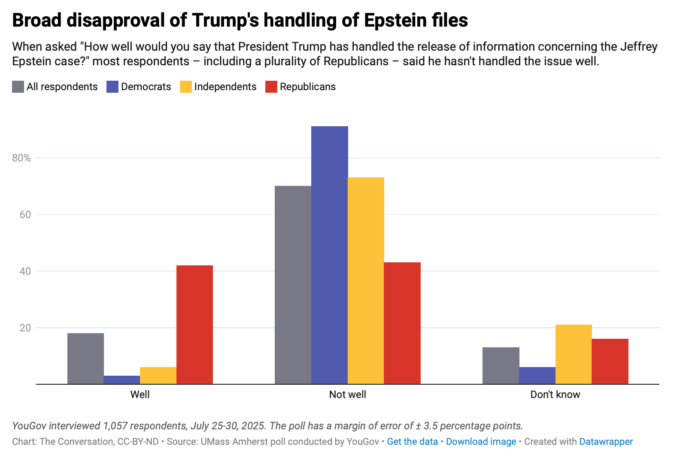








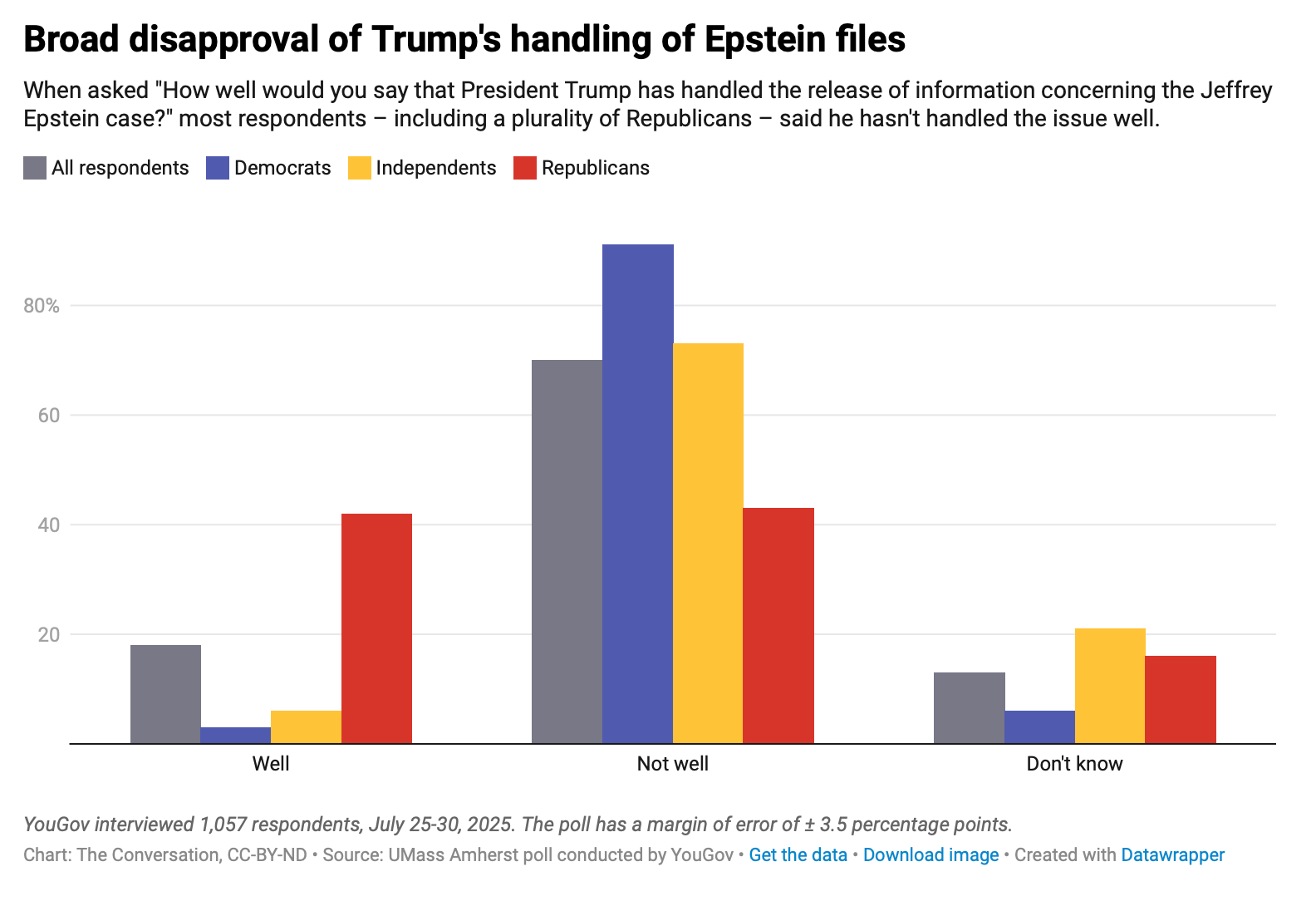




































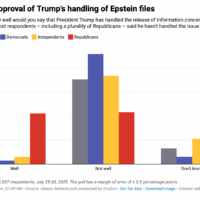



















Has President Donald Trump survived the latest and most serious firestorm of controversy over the Epstein scandal? Or has the Trump administration’s handling of the release of information concerning the prosecution of Jeffrey Epstein, a convicted child sex trafficker and Trump’s former friend, hurt the president?
A number of journalists, pointing to recent public opinion polls, have claimed that the scandal has hurt Trump. Others have argued that the public has largely moved on and the Epstein controversy no longer presents a political liability for Trump.
But both of these conclusions are based on limited polling about the Epstein controversy and thus may be premature.
Our recent University of Massachusetts Amherst national poll includes particularly detailed questions about the Epstein controversy and attitudes toward Trump, and thus provides fresh insights on how the controversy has affected public support for Trump.
We find that Trump’s handling of the Epstein controversy has done significant damage to his standing, particularly among his core supporters.

Trump ‘fumbling the matter’
Americans are paying close attention to the prolonged Epstein controversy. Our polling finds that 3 in 4 respondents have heard, read or seen “a lot” or “some” about Epstein.
Moreover, most believe that Trump is fumbling the matter.
Seven in 10 Americans believe that Trump is handling the matter “not well.” This includes pluralities of Trump’s most loyal supporters, 43% of Republicans, 43% of conservatives, and 47% of those who voted for him in 2024.
When we drill down on the 47% of 2024 Trump voters who disapprove of Trump’s handling of the Epstein controversy, we find significant cracks in the MAGA facade. Among members of this group, 28% now disapprove of Trump as president.
When we take demographics, ideology, partisanship and assessments of the economy into account, disapproval of Trump’s handling of the release of the Epstein files is still associated with an increase in disapproval of Trump.
Voter regret
Even more significantly, we find that among 2024 Trump voters, negative views of Trump’s handling of the Epstein files are associated with an increased desire to make a different choice if the 2024 election could be rerun.
More specifically, among Trump voters who believe that the president has mishandled the release of the Epstein files, more than one quarter – 26% – indicate that they would not vote for Trump if they had the opportunity to vote again in the 2024 election.
While there are no election do-overs, it is clear that the Epstein scandal has hurt Trump among his base of voters.
Much can happen between now and the midterm elections in November 2026, of course.
But if Trump fails to satisfy his political base, perceptions among Trump voters that he has mishandled the controversy could reduce enthusiasm and participation in the elections. Even if the share of Republicans alienated by the Epstein controversy is relatively small, this could hurt Republicans in close contests.
With over a year to go, the facts on the ground will likely change. But as of today, the controversy over the release of the Epstein files remains relevant. Whether the president responds in a manner that satisfies his voters is a question that could have important political consequences.

This article is republished from The Conversation under a Creative Commons license. Read the original article.
The post Trump’s Epstein Problem is Real appeared first on CounterPunch.org.
This content originally appeared on CounterPunch.org and was authored by Tatishe Nteta – Adam Eichen – Alexander Theodoridis – Jesse Rhodes – Raymond La Raja.This post was originally published on Radio Free.
-
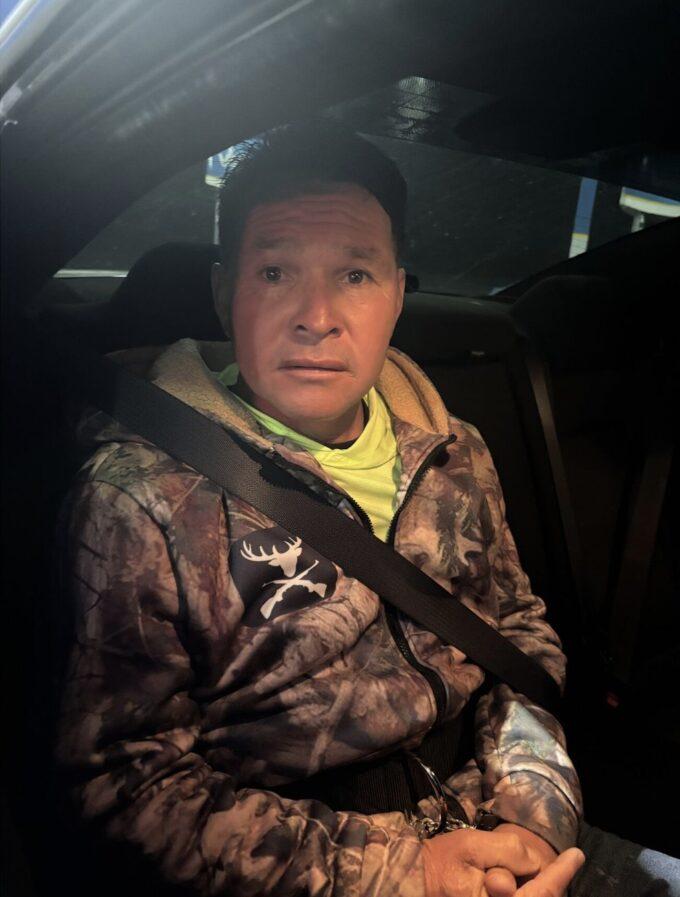











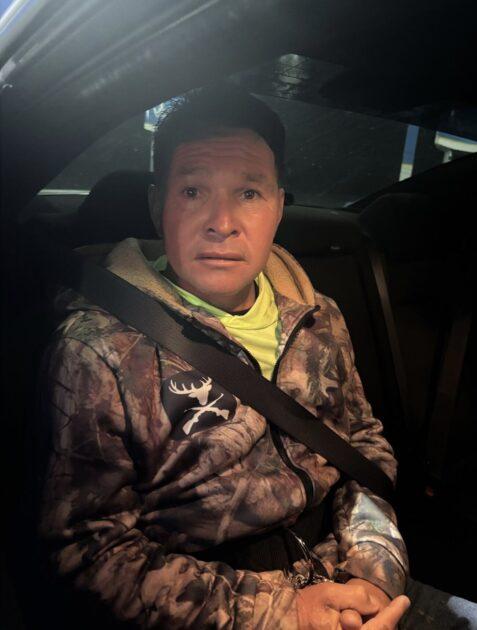






















































Theatrical release poster for John Carpenter’s In the Mouth of Madness.
“You can be sincere and still be stupid.”
― Fyodor Dostoevsky
+ Back in April, Jesús Escalona Mújicas was on his way to his job at a construction site when he was pulled over by federal immigration officers and Texas police in a joint raid near Bryant, Texas. Escalona Mújicas, a 48-year-old native of Venezuela, was pressed against his car as his hands were bent behind his back and cuffed. He was taken to a neaby gas station where he was interrogated. He was then arrested and thrown in the immigration detention jail (aka, “Processing Center”) in Conroe, Texas. The officers who arrested him claimed to have a deportation order for Escalona Mújicas based on the Alien Enemies Act, which Trump had recently invoked to speed up deportations of alleged gang members from central and south America. An agent told him: “the President does not want to see Haitians, Nicaraguans, Cubans, or Venezuelans here.” Escalona Mújicas protested that he wasn’t a gang member and had a temporary work visa. But his denials were smugly dismissed by the arresting agents.
Soon after his arrest, ICE sent out a press release including a photo of Escalona Mújicas in handcuffs, wearing a John Deere sweatshirt with the caption: “documented Tren de Aragua gang member.” But the arrest report didn’t even get Escalona Mújicas’s nationality right, claiming that he was “an alien of El Salvadorian origin without legal status in the United States.” So it’s no surprise that they falsely arrested and then publicly smeared him as a “Tren de Aragua gang member,” even though his name was not listed in the admittedly problematic (for false positives) TxGANG database. What was the evidence the Trump administration used to as proof of Escalona Mújicas’s gang affliation? His Air Jordans.
In fact, Escalona Mújicas had no criminal history and had never heard of the Tren de Aragua gang until he got to the United States. When he lived in Venezuela, he worked as a forklift operator at Empresas Polar, the Venezuealan subsidary of Pepsi. Escalona Mújicas was deported back to Venezuela in May, but the Trump administration hasn’t rescinded its false accusation that he is a gang member, a slander that may well keep him from immigrating to any other country.

ICE photo of Jesús Escalona Mújicas, which falsely referred to him as a “documented member of Tren de Aragua gang.
+ Last week, Angel Minguela Palacios, a strawberry delivery driver with no criminal record, was on his last stop of the day when he pulled up at the Japanese-American Museum where Gavin Newsom was speaking to drop off fruit to a tea room, when he was arrested by Border Patrol agents, who had surrounded the building as a show of force against the governor. Palacios knew nothing about Newsom’s event, but was soon accosted by an ICE agent. Instead of responding to the agent’s questions, Palacios handed them his red “know your rights” cards. The agents insisted he submit to their interrogation. He refused and handed the agent his ID. Then he was arrested and handcuffed. Border Patrol chief Gregory Bovino was videotaped patting the officer who arrested Angel on the back, saying: “Well done.” Palacios was the only person arrested in this “show of force” raid and in the DHS press release they implied that he was a Tren Aragua gang member and drug trafficker. Bovino brayed: “We’re here making Los Angeles a safer place, since we don’t have politicians who will do that, we do that ourselves.” But Palacios wasn’t charged with drug trafficking or gang affliation. All they ended up saying was that he had overstayed his visa, which is a civil not a criminal offense. Angel has lived with his partner, a US citizen, in LA for 8 years and helped raise her daughters and son. Together they have a six-year-old son who is autistic.

+ Javier Ramirez was at a tow yard in Montebello, California, when ICE agent raided the place. Ramirez says one of the masked men pointed at him and yelled, “Arrest him, he’s Mexican!” The agents tackled Ramirez to the ground, injuring his arm and took him to jail, where he was held for nearly a week. Ramirez is a US citizen and father of four. After he provided proof of his citizenship, ICE charged him with assaulting their agents. However security cameras showed he didn’t resist his wrongful arrest and he was eventually released. Ramirez says he now constantly looks over his shoulder, fearing another raid: “They are literally racial profiling us. If you even look Latino, they will come and get you.”
+ A 6-year-old girl living in Queens, along with her mother and teenage brother, are hundreds of miles away from each other after federal agents grabbed the family members following a routine check-in at immigration court in New York City last week. “School is supposed to start in three weeks. Dayra and her mother should be buying school supplies,” Councilmember Shekar Krishnan, a Democrat representing Jackson Heights, told News 4. Instead, Dayra, a student at PS 89, the Jose Peralta School of Dreamers in Queens, and her mother are in a detention facility nearly 2,000 miles away in Texas.
+ George Retes, an Iraq war vet and US citizen, is a security guard who was driving home in Los Angeles and happened to encounter an immigration raid. When he asked ICE agents to let him pass, the masked men smashed his windows, dragged him out of his car, and held him for 3 days and nights without charge in an isolation cell, where he was prohibited from making a phone call, contacting a lawyer or seeing a judge. He was finally released without charges. While he was in detention, his daughter turned three.
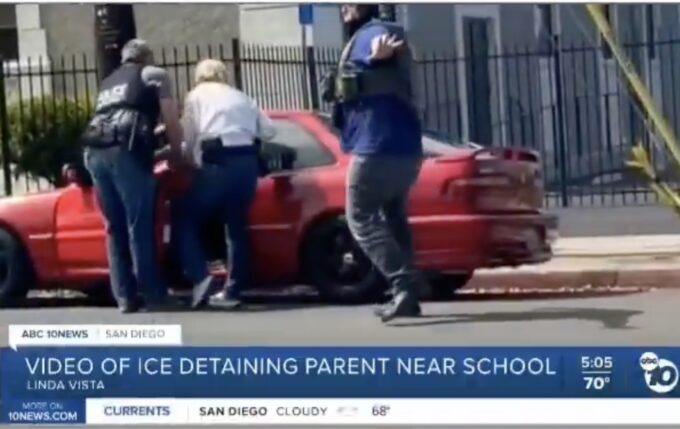
+ A dad was waiting in his car to pick up his kid outside the Linda Vista Elementary School in San Diego, when masked ICE agents pulled him and took him away. School staff had to sort out arrangements for child left behind by ICE. Principal: They’re very little—to not get picked up by your parent is very traumatizing.” This was the second arrest outside an elementary school in Southern California this week.

+ ICE abducted and plans to deport Muhammad Zahid Chaudhry, the husband of Melissa Chaudhry a US citizen and former Democratic congressional candidate in Washington State. Chaudhry is a disabled U.S. Army veteran, who is confined to a wheelchair—after suffering debilitating injuries during training for his deployment in Iraq.
Chaudhry, a native of Pakistan, is a green card holder who has been living legally in U.S. for over 25 years. Despite this, ICE arrested him at his naturalization hearing at at the United States Citizen and Immigration Services office in Tukwila, Washington
Chaudhry has been awarded multiple medals for his service:
+ Army Service Ribbon
+ Global War on Terrorism Service Medal
+ Armed Forces Reserve Medal
+ Reserve Achievement Medal
+ National Defense Service Medal
+ Recruitment Achievement Medal
+ Army Strength Management AwardAfter his discharge from the Army, Chaudhry has worked with the local chapter of Veterans for Peace in Olympia, Washington.
+ The Wall Street Journal reports that most of the arrests in the military occupation of DC have been targeted at immigrants, including raids of pre-schools: “Earlier this week, federal agents parked outside Casa Lala, a bilingual daycare center near Mount Pleasant, and made arrests. “The staff were terrified. Students were scared. Parents were scared,” Santos said. She said her 5-year-old son “asked if Donald Trump was going to come into his school.”
+ We don’t have the right to shout “ICE” in a train station?

+ ICE is holding at least 150 Canadians in custody, including two toddlers. ICE held one 2-year-old child for 51 days, twice the time permitted by law. A three-year-old was confined for four days in a room meant for a maximum of 12 hours of detention. According to a lawsuit filed against the barbaric conditions at the South Texas Family Residential ICE Detention Center in Dilley, Texas, the children are provided with no toys, organized activities or schooling. The lawsuit quotes on 13-year-old saying, “I don’t want to die here.” It alleges that a nine-month old infant lost 8.82 pounds after being held in custody for a month.
+ This is demonstrably untrue. But for this administration, “support for terrorism” could mean watching Nature or Burns’s The Civil War on PBS…

+ The lawyers for Kilmar Abrego Garcia asserted to a federal judge that the Trump administration is attempting to coerce him into a guilty plea by offering to deport him to Costa Rica. If he refuses, they’ve threatened to deport him to Uganda…

+ A judge ruled that the state and federal governments acted illegally by not conducting an environmental review before building the Alligator Auschwitz in the Florida Everglades. The judge ordered the closure of the concentration camp within 60 days. The suit was brought by the Miccosukee Tribe. DeSantis has already announced he will defy the court ruling. If he does so, Gov. Pritzker has should send the Illinois National Guard to Florida to enforce the judge’s order. It wouldn’t be the first incursion into the South by troops from Illinois. Illinois troops, which contained the first two black regiments in the US Army, played vital roles under Grant in the battles of Shiloh, Vicksburg, and Chickamauga.
+ According to a killer report by the Miami Herald, many of the contractors DeSantis picked to build and operate Alligator Auschwitz have been accused of fraud and price-gouging:
“One of the firms allegedly allowed armed Mexican nationals with no legal immigration status to be brought into the United States by a subcontractor to provide security for its work in building a border wall as part of a federal contract. Another recently agreed to a multimillion-dollar settlement addressing allegations that it had sold to the U.S. federal government products made in prohibited countries like China. A third shares top executives with two businesses that were accused by ex-employees of filing inflated hurricane insurance claims in federally-declared disaster areas.”
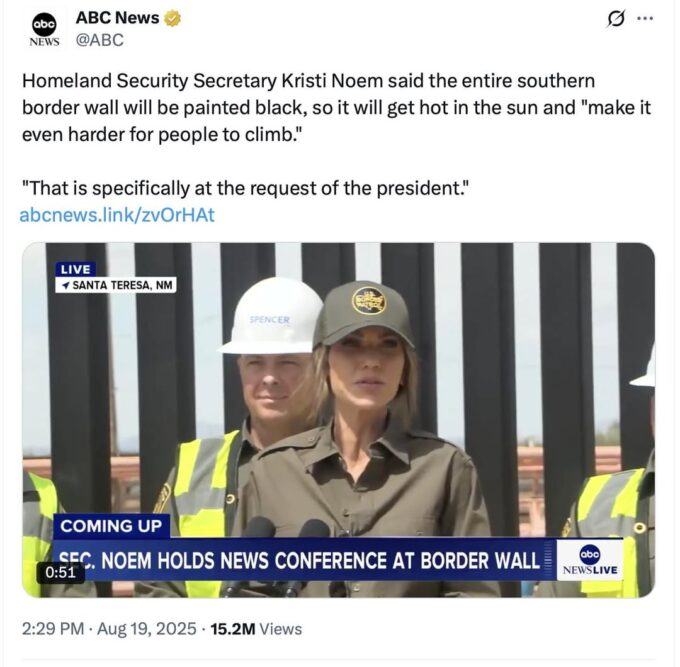
I look inside myself
\And see my heart is black
I see a white wall
I must have it painted black+ Cost of painting Trump’s border wall black: $500 million.
+ ICE recently shelled out $2.4 million for a fleet of new trucks and SUVs, which were custom detailed with gold wraps reading “DEFEND THE HOMELAND, INTEGRITY, COURAGE, and ENDURANCE.”
+ ICE has lowered the hiring standards (it will no longer require agents working the southern border to speak Spanish) and raised the salaries for ICE agents. The starting salary is now $90,000 with a $50,000 signing bonus.
+ According to the budget lab at Donald Trump’s alma mater–The Wharton School of Business at the University of Pennsylvania–Trump’s mass deportations will increase deficits by nearly $1 trillion…
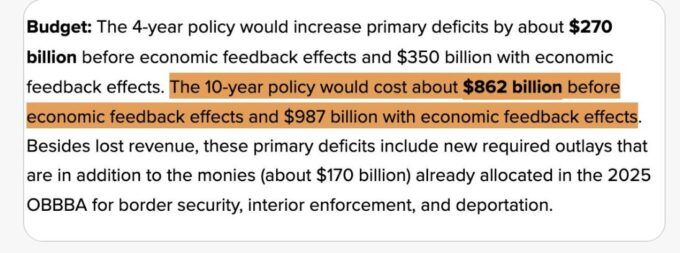
+ ICE is using the “Taylor Swift” loophole in private aviation regulations ( designed to make it more difficult to track the ftravel of celebrities) to condeal the routes of its deportation flights. ICE is also using fake license plates on its cars and vans.
+ New Yorker: “The last person who asserted the authority to use military personnel for routine law enforcement anywhere in the country for any reason was King George.”
+ Charlie Kirk took to X to announce that “President Trump is going out on patrol tonight in DC. Shock and awe. Force. We’re taking our country back from these cockroaches. Just the start.” Alas, Trump didn’t go on patrol, but he did manage to make it to a Park Service staging area for federal law enforcement and national guard troops and addressed them on the topic of restoring the grass on the National Mall and other “national parks:”
One of the things we are going to be redoing as your parks. I know more about grass than any human being anywhere in the world. We are going to be regrassing your parks, new sprinklers systems. It will look like Trump national golf club. Grass has a life. You know that? Grass has a life. We have a life, and grass as a life. The grass here died about 40 years ago.
+ Stephen Miller on the protests against the military occupation of DC: “All these demonstrators that you’ve seen out here in recent days, all these elderly white hippies, they’re not part of the city and never have been … we’re gonna ignore these stupid white hippies that all need to go home and take a nap because they’re all over 90 years old.”
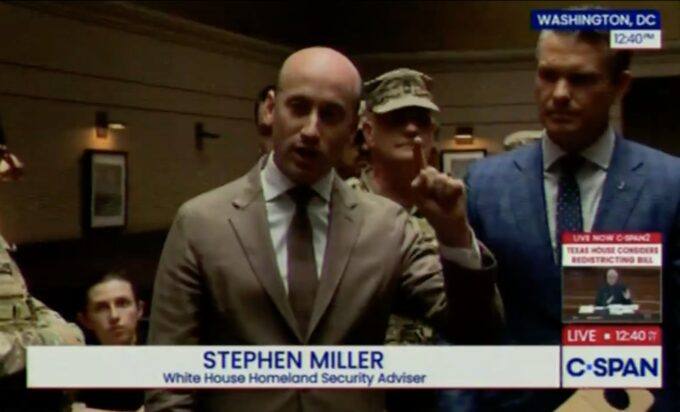
+ About 8 in 10 Americans, 79%, say immigration is “a good thing” for the country today, an increase from 64% a year ago and a high point in the nearly 25-year trend. Only about 2 in 10 U.S. adults say immigration is a bad thing right now, down from 32% last year. Trump doesn’t care what most Americans think. Neither do his political opponents.
+ A year and a half ago, our modern-day, puppy-shooting Annie Oakley said this about Biden potentially sending National Guard troops into cities…
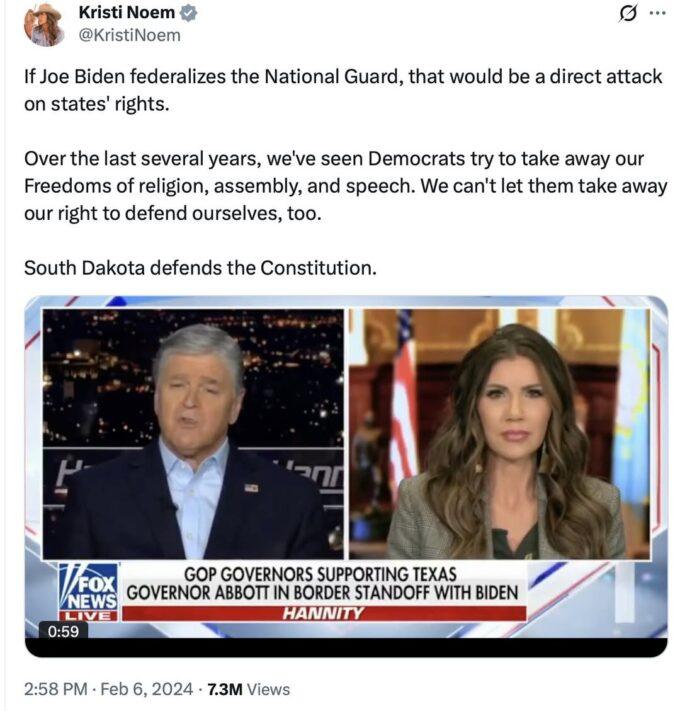
+++

Meteorologist Jeff Beradelli on the explosive growth of Hurricane Erin:
Hurricane Erin achieved something most storms do not this weekend. “Extreme Rapid Intensification”. Did climate change play a part? Science says, yes.
In 12 hours winds increased by ~65 mph. Only 3 other storms have done that and Erin was the earliest & only August storm to do so.
Also, there was a 78 mb drop in 24 hours, a feat only achieved by 2 other storms since 1980, and those were both in October (Milton & Wilma).
Erin was the 5th earliest cat 5 on record.
The image below shows that water temps in the vicinity of the Rapid Intensification (RI) were almost 2F above normal, hot waters made much more likely by climate change. In fact, studies show episodes of Rapid Intensification (esp. extreme RI) have increased significantly over the past few decades as waters have warmed. RI has increased by almost 5 mph per decade over the past 40 years. That means that a storm – which in the 1980s – had a RI of 40 mph in 24 hours, would likely have an RI of 60 mph in 24 hours now (on average). That makes storms much more destructive (if they landfall of course)
It’s not coincidence, it’s climate change.
Now, worth mentioning you need a whole lot more than hot water for a cat 5 & RI – all factors must line up – but if they do, hotter than normal water makes it much more possible.

+ Meteorologist John Morales: “The rapid intensification threshold is 35 mph in 24 hours. For extreme rapid intensification, it’s 58 mph in 24 hours. Erin saw an 85 mph gain in max windspeed in 24 hrs. By barometric pressure, it is a top-20 strongest Atlantic hurricane.”
+ What AI data centers have done to your electricity bill: prices in the US are up 38% in the last 5 years, after being stable for the previous 5 years.

+ A study in Nature found glaciers in the Alps and Pyrenees mountains of Europe have lost about 40% of their mass since 2000. 2022 and 2023 set new records for percentage of ice loss.
+ The Mediterreanean is becoming a tropical sea. With water temperatures of 32C, these warming water have encouraged hundreds of species native to the Red Sea, such as the lionfish, to invade the Mediterranean via the Suez Canal. The consequences to the sea’s ecosystems could be devastating.
Heatmap: “From 2020 to 2023, the average American breathed in concentrations of smoke-related PM2.5 that were between 2.6 and 6.7 times higher than the 2006 to 2019 average.”
+ Former NOAA scientist Holden Harris, whose doctorate was funded by the National Science Foundation, on life after being fired by the Trump Administration: “Today, among my four part-time and consulting jobs, I sell frozen chocolate bananas on the beach in Jacksonville Beach. That cannot be the best return on taxpayer investment.”
+ Trump called the Native American tribal leaders fighting an open-pit copper mine owned by the subsidiary of a foreign company that will destroy Oak Flat, one of the most sacred sites in the Southwest “anti-American.” MAGA!
+++
+ BatchData: 30% of homes in West Virginia are owned by investors.
+ There are now more people over the age of 50 with outstanding student loan debt (9.2 million borrowers with an average debt of $48,000), than there are under the age of 25 (6.8 million with an average debt of $13,400). Soon there will be more people over the age of 70. Many people can never pay these off…
+ While Fox News is having a meltdown over Mamdani’s plans for a few city-owned grocery stores, the Trump Administration is buying up massive stakes in US corporations…
image
+ Is this state capitalism? Mussolini-style economic fascism or a pump-and-dump scheme?
+ Maia Mindel: “Hearing that the U of Chicago cuts to the humanities come from the university taking out loads of debt to expand over the past two decades and being unable pay the interest. The problem with the Chicago School of Economics is that eventually you run out of other people’s money?”
+ Florida Senator Rick Scott disclosed $26,000,000 in stock trades. The disclosure was made more than a year.
+ Nancy Mace: “In my time in Congress, I actually helped secure the largest infrastructure grant in state history, in South Carolina history. So I’ve worked very hard on the policies that matter to voters here.” She voted against the Biden infrastructure bill.
+ Mace had to cancel a downhill in her district, when only 8 people showed up.
+ In order to guard against “radical leftist ideology” infecting their youngsters, the State of Oklahoma will require teacher certification applicants from California and New York to pass an exam administered by the rightwing, propagandized history mill PragerU before they can teach in the Sooner state.
+ The Democratic Party is going the way of the Whigs. Everybody hates Trump, but no one wants to join the Democratic Party of broken promises, corporate money grabbers and senile leaders, who hold on to their seats by killing off every youth movement fueled by new popular ideas. They can’t raise money and they can’t register new voters. Since 2020, the Democrats have lost ground to the Republicans in all 30 states where voter registrartion is tracked. In the last four and a half years, the Republicans have registered 4.5 million more new voters than the Democrats.
+ Michael Pruser, a data analyst at Decision Desk HQ: “I don’t want to say, ‘The death cycle of the Democratic Party,’ but there seems to be no end to this. There is no silver lining or cavalry coming across the hill. This is month after month, year after year.”
Whatever happened to all this season’s losers of the year?
Every time I got to thinking, where’d they disappear?
Then I woke up, Mom and Dad are rollin’ on the couch
Rollin’ numbers, rock and rollin’, got my KISS records out
Mommy’s alright, Daddy’s alright
They just seem a little weird
Surrender, surrender
+ Once a champion of the working class, Sherrod Brown is now running as the pro-crypto (fraud) candidate…Another Can’t Beat ‘Em Join ‘Em Democrat.

+ Brown’s 72, has already served in congress for 32 years and is apparently willing to bend nearly every principle he once professed to hold just to get back to DC. Is this recycled and re-branded candidate the best the Ohio Democrats can offer?
+ James G. Zogby, Executive Committee of the Democratic National Committee:I ask a serious question: Why’s the Dem Party establishment hell-bent on self-destructing? Some Dem leaders refuse to endorse NYC’s Mamdani; MN Dems overturn the endorsement of Omar Fateh; & leaders refuse to recognize the big majority of Dems who want to stop arms to Israel.
Mamdani decisively won the Dem primary – he is the party’s nominee. And yet the Dem leaders of the House & Senate & the national party haven’t endorsed him.& some Dem consultants & elected officials are working for discredited former Governor Cuomo.
Omar Fateh won the endorsement of the Minneapolis Dem caucuses. Some Dem officials were threatening to withhold money from the party if Omar is the nominee. So the state party overturned the endorsement saying the caucuses were flawed. Losers always say elections are messy.
Mamdani & Fateh are both people of color, Dem socialists, & supporters of Palestinians. Both have generated tremendous excitement among voters Dems must win.
Why does the party want to refuse to understand the need to change, alienate voters they need & snuff out excitement.
+ One of Eric Adams’ top campaign advisers, Winnie Greco, handed a reporter for The City a bag of chips stuffed with cash after an Adams campaign event. When the reporter refused the bribe, Greco replied: “I make a mistake,” she said. “I’m so sorry. It’s a culture thing. I don’t know. I don’t understand. I’m so sorry. I feel so bad right now. I’m so sorry, honey.” Later she called the CITY offices, pleading:
Can we forget about this? I try to be a good person. Please. Please. Please don’t do in the news nothing about me…I just wanted to be her [the reporter] friend. I just wanted to have one good friend. It’s nothing.
Here’s how the NYT described the attempted subbornment of the press…”The news that an adviser to Mr. Adams, Winnie Greco, had attempted to pay a reporter from an online news outlet, The City, stood out as a bold departure from political norms. Ms. Greco had put a red envelope stuffed with cash inside a potato chip bag and slipped it to the reporter after a campaign event.” A “bold departure from political norms?”…the language in the NYTs gets more tortured by the day. The Daily News would just call it a “bribe.”
+ Cuomo on seeking his old buddy Donald Trump’s help to defeat Mamdani:
Let’s put it this way: I knew the president very well. I believe there’s a big piece of him that actually wants redemption in New York. He feels that he was rejected by New York. We voted for Hillary Clinton. Bill de Blasio took his name off things. So I believe there will be opportunities to actually cooperate with him. I also believe that he’s not going to want to fight with me in New York if he can avoid it.
+ Mamdani told the press this week that Cuomo is still running because “Andrew Cuomo is someone who doesn’t understand that no means no.” He’s good.
+ Sex and the City, the Mamdani Reboot: Fewe $1,000 shoes, more sex!

+ I hope Mamdani commissions the de-Disneyfication of Times Square and returns it to its debouched and iniquitous roots.
+++
It’s impossible to drum up any sympathy for John Bolton, but the FBI raid on his house is a pretty ominous sign for the rest of country. Interesting move to start the round-up of Trump’s enemies with Bolton. If there’s no GOP or Fox News pushback from his former colleagues, it will make it a lot easier to go after his other “persecutors”: Comey, Clapper, Brennan, Letitia James…
+ As I said during the similar raid on Mar-a-Lago, nearly all alleged “national security” documents are over-classified, designed to conceal potential malfeasance by our government, not external threats to it.
+ Trump signed an executive order last week instructing Pam Bondi to bring criminal charges for protester who burn the American flag for creating a public nuisance and violating environmental law (most of which his administration has gutted).
+ The “Free Speech” president’s latest attack on free speech: Trump to sign executive order criminalizing the burning of the American flag. Even Scalia said such a law or executive order is unconstitutional. So this order itself is a crime against the Constitution and against the flag itself and its protected right to be burned by its owner.
+ The fact that the Pentagon recommends burning “worn-out” US flags (on Flag Day, no less) shows that Trump’s EO criminalizing the burning of flags is a direct assault on free speech, since it only applies to those who burn flags as a form of political protest.

+ Can’t wait to see what the African-American History Museum looks like after Trump’s “attorneys” go through it…

+ And who is the lawyer Trump is sending to audit the Smitshonian for “improper ideology”? One of them is Lindsey Hallihan.
+ Does it look or sound like Lindsey has spent more time in her life in a museum or at a hair salon?….White House official Lindsey Halligan: “While slavery is obviously a horrible aspect of our nation’s history, you can’t really talk about slavery honestly unless you also talk about hope and progress … we need to stop focusing so much on the lack of progress.”

+ Halligan competed in the Miss Colorado USA pageant twice. In 2009, she was a semifinalist, and in 2010 she was third runner up. Halligan got a BA in”Enemies of the State” (ie, journalism) at Regis (never heard of it) College in Denver. She got her law degree from the University of Miami (ranked 92 in the country) and then practiced “insurance law” in “Miami FLA” where she was sanctioned by a judge for “not acting in good faith.” This impressive resumé lured Trump into appointing her special assistant to the president in charge of rooting out “improper ideology” at the Smithsonian.
+ Terence Tao, the “Mozart of Math,” on getting his funding cut by Trump: “This is not a routine policy shift – it is a deliberate dismantling of the institutions, funding, and freedoms that have sustained American science for generations.”
+ Stephen Walt on the abbreviated Trump-Putin summit: “Trump is a terrible negotiator, a true master of the ‘art of the giveaway.’ He doesn’t prepare, doesn’t have subordinates lay the groundwork beforehand, and arrives at each meeting not knowing what he wants or where his red lines are. He just wings it.”
+ A German court ruled that Karl Marx’s writings are inconsistent with “free, basic, demoratic order.” How soon before a similar finding is made by Rubio’s State Department or the soon-to-be declared, Department of Homeland History, which will be sure to ban Marx’s letter to Lincoln, whom he greatly admired: “The working men of Europe feel sure that as the American war of independence initiated a new era of the ascendency of the middle-class, so the American Anti-slavery war will do for the working class.”
+++
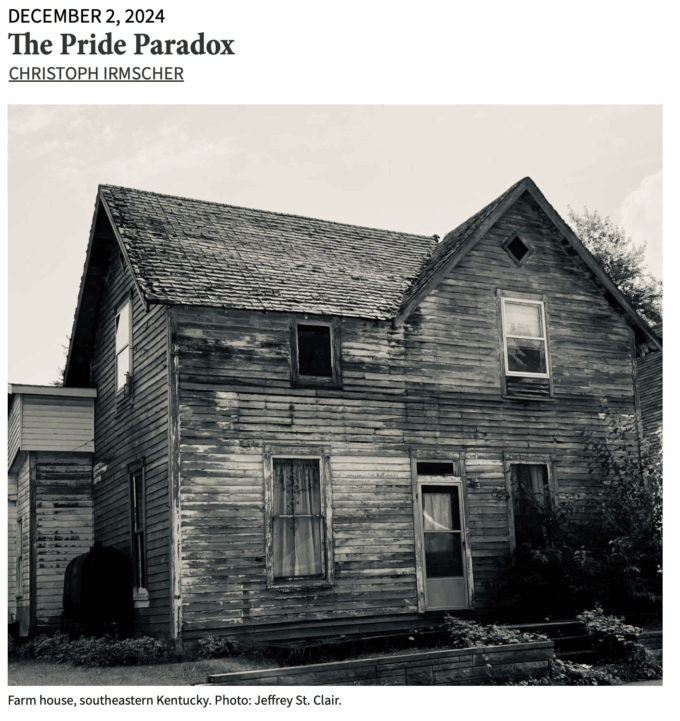
I never envisioned CounterPunch winning a journalism award from Washington Monthly magazine. But that delusion ended this morning when Christoph Irmscher won the Kukula Award for Excellence in Nonfiction Book Reviewing. Christoph is a professor of English at Indiana University and the author of excellent books on Audubon, Louis Agassiz, and Longfellow. Washington Monthly honored his piece The Pride Paradox, a review of Arlie Hochschild’s Stolen Pride: Loss Shame and the Rise of the Right. Ever humble, Christoph told me that my photograph of a decaying farmhouse in southeastern Kentucky was the decisive factor. But it’s really all about his well-chosen words. Congrats, Christoph!
+ Fox’s Jesse Watters: “In order to have masculine politics, you need to live your life as a man. You need to live a life of action, and you have to live it outdoors. The first step is having your own compound. Trump had Trump Tower. He’s got his golf courses. He’s got the White House now. You call people in and hold court and control everything. That is what they need.”

+ For a manly man, Jesse spends a lot of time getting his eyebrows shaped..
Supreme Court Justice Flavio Dino ruled that foreign court orders aren’t legally binding in Brazil unless they’re approved by the Supreme Court. This means the Magnitsky Act sanctions against Justice Alexandre de Moraes aren’t legally binding on Brazilian soil: “Brazil has been the target of numerous sanctions and threats,” wrote Dino, “which constitute an attempt to subvert our national sovereignty by reducing its institutions to a vehicle for the automatic ratification of external agendas…”Foreign judicial decisions can only be enforced in Brazil following due homologation or compliance with established international judicial cooperation mechanisms.”
Thanks, Judge. I’m going to use “homolagtion” in a sentence one day.
+ Is it wrong to hope that you’ll be abducted by aliens and whisked off of this crazy-ass planet?
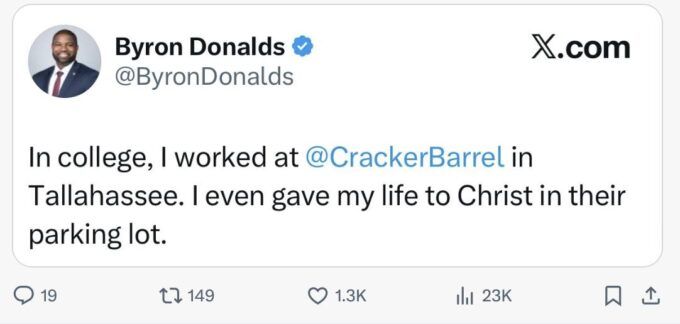
Trump on the US hosting the World Cup: “I may play…I’m a very good athlete. My son is a good athlete. A good soccer player. On the tall side for soccer…I may put on shorts, I look extremely good in shorts, and join the play.” Trump in shorts. I’m surprised they didn’t use that image to torture If there’s one thing the poor folks being held in Gitmo can be thankful for, it’s that their torturers didn’t force them to stare for hours like Alex in Clockwork Orange at an image of Trump in shorts.
+ Derek Guy: “I need politicians to be as mad at housing prices as they are about Cracker Barrel’s new logo.”
+ The largest shareholder of Cracker Barrel, that gritty symbol of the White South, which shall not be messed with: Black Rock.
+ I’ve been trying to clean out (well, move things around, anyway) my office and came across this front-page clipping from a 1989 press conference with a group of farmers in central Indiana who were fighting a Texas high-pressure natural gas pipeline from being implanted beneath their fields. The photographer caught me losing temper when a reporter started quoting some crap from the pipeline company about how their pipelines never leak or spontaneously explode or contaminate the soil or groundwater and I blurted out, “Fucking think about how stupid that sounds, will you?” The farmers applauded, the pastors of the local churches we’d recruited into the fight asked if there wasn’t someone “more Christian” who could speak on their behalf the next time…

+ In the same slagheap of photos and clippings, I relocated one of my favorite photos of Alexander Cockburn, taken on a hike that was meant to traverse the King Range to the mouth of the Mattole River. But we ended up descending into the wrong canyon, with none of us willing to admit that we were lost on the Lost Coast, heading vaguely east instead of west, each hour farther and farther from our destination. Alex was typically non-plussed about our embarrassing predicament, soaking up the sunshine on one of the King Range’s golden hillsides. He’d brought wine and hard cider in his leather satchel, which may or may not have diminished our navigational faculties. Still, we ate two or three great meals (grilled try-tip and barbecued salmon), told some wild stories, spread some salacious gossip, slaughtered the blues late into the night under the Perseids meteor shower, spent a full day hiking in hip deep water when the canyon narrowed into a slot and ended up at some weird ranch of unknown and possibly hostile political affinity, where we had to call someone to pick us up. One of the few trips Alex didn’t write up in a column, though it had all of the elements for being one of his funniest…(Those socks!)

I’m Mad, Ha Ha…
Booked Up
What I’m reading this week…The War on Illahee: Genocide, Complicity and Cover-Ups in the Pioneer Northwest
Marc James Carpenter
(Yale)How to Save the Amazon: A Journalist’s Quest for Answers
Dom Phillips
(Chelsea Green)Free Gifts: Capitalism and the Politics of Nature
Alyssa Battisoni
(Princeton)Sound Grammar
What I’m listening to this week…New Radiations
Marissa Nadler
(Sacred Bones)Hyperglyph
Chicago Underground Duo
(Internatinoal Anthem)Figure in Blue
Charles Lloyd
(Blue Note)What Humans Are Capable Of…
“Someone who is permanently surprised that depravity exists, who continues to feel disillusioned (even incredulous) when confronted with evidence of what humans are capable of inflicting in the way of gruesome, hands-on cruelties upon other humans, has not reached moral or psychological adulthood.”
– Susan Sontag, Regardiing the Pain of Others
The post Roaming Charges: From of the Mouths of Madness appeared first on CounterPunch.org.
This post was originally published on CounterPunch.org.
-
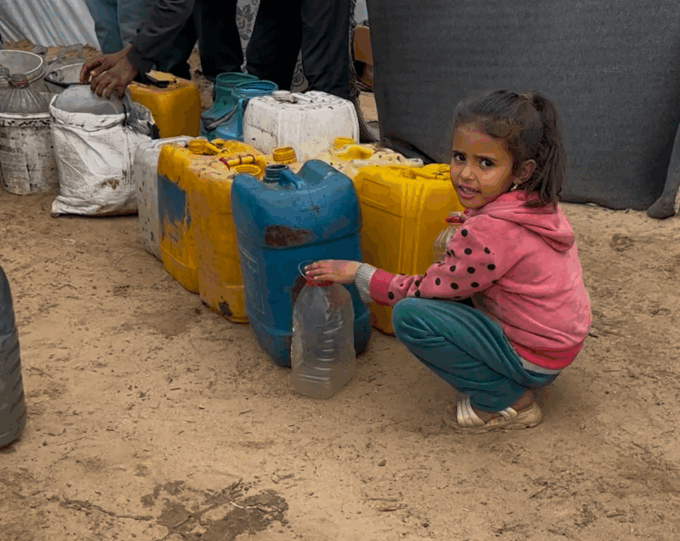








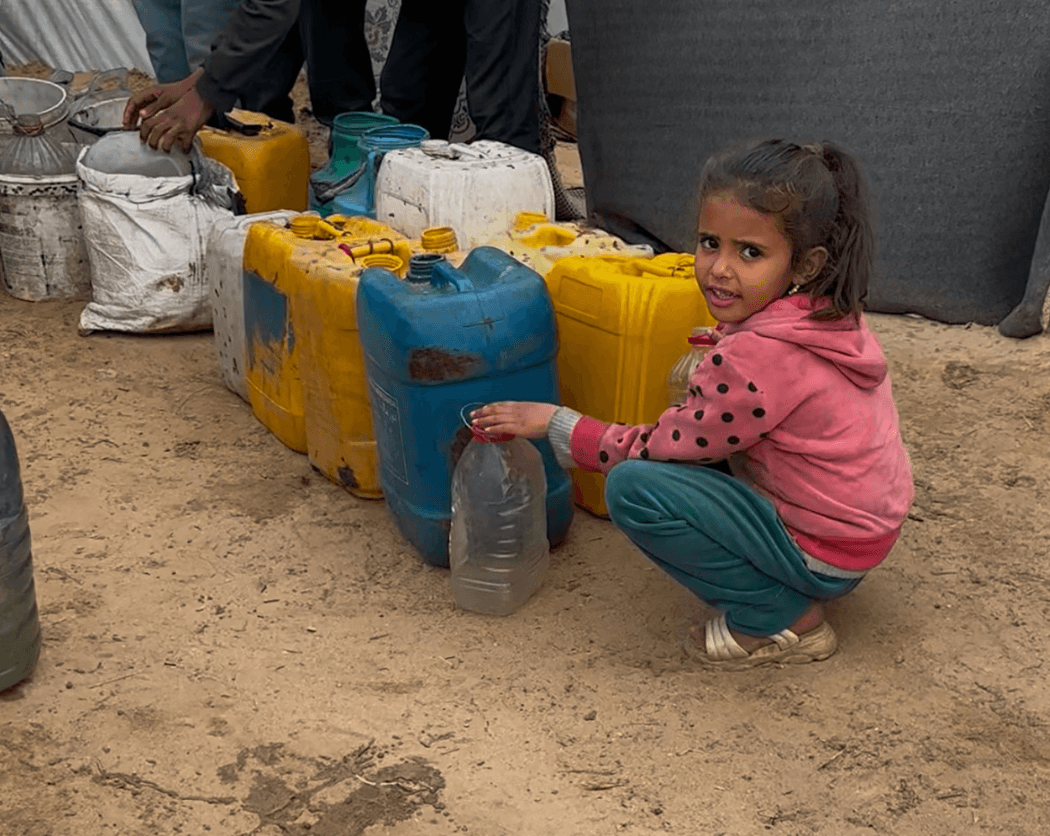


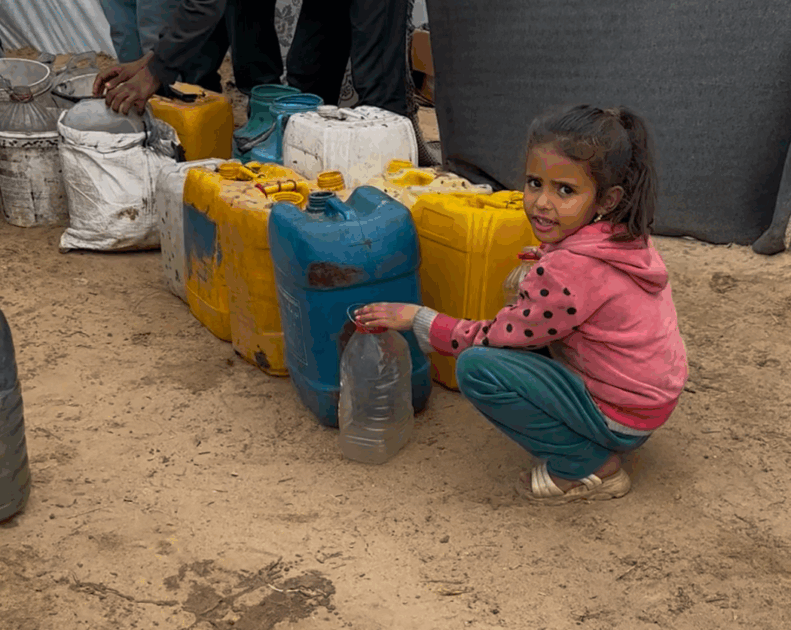

































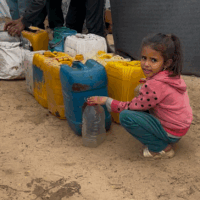




















Image by Emad El Byed.
Israel war of genocide is not about October 7; it is not about freeing Israeli captives. It is, first and foremost, about preserving a racist Jewish governing coalition and seizing a historic opportunity while a submissive administration in Washington looks the other way. The aim is to advance a biblical expansionist project and create the conditions for “self” ethnic cleansing, as part of the permanent erasure of the Palestinian people from their homeland.
As the U.N. officially declared a famine in Gaza City, Israel rejected the ceasefire and threatened to flatten Gaza City “like Beit Hanoun.” On July 11, Israeli Minister of War Israel Katz openly flaunted an aerial image of the razed cities of Rafah in the south and Beit Hanoun in the north, vowing that Gaza City would suffer the same fate.
Intoxicated by international impunity, Israel plans to force one million civilians from the north into a concentration camp, euphemistically called a “Humanitarian (Tent) City” in the south. Stripped of homes, starved, and bombed, Palestinians are being herded into cages to prepare for the “voluntary” expulsion from their country. In this regard, racist Finance Minister Bezalel Smotrich told the Israeli military chief Eyal Zamir, “Whoever doesn’t evacuate . . . No water, no electricity, they can die of hunger…”
In the occupied West Bank, Smotrich has dusted off the old Israeli blueprint to further carve Palestine into disconnected fragments. His plan dismembers any supposed “future Palestinian state” into three broken pieces: two sealed-off ghettos in the West Bank and another in Gaza. The aim is to undermine the geographical contiguity of any future Palestinian state, while cementing the Israeli “Jewish-only” colonial project of “from the river to the sea” as a permanent reality.
Europe knows this well. It condemns these illegal colonies, urges Israel not to expand them, and pretends to show indignation. And then? Nothing. Worse than nothing, Europe continues granting Israel privileged trade status, even importing goods produced in the very “Jewish-only” colonies it labels “illegal.” By financing Israel’s war economy while issuing toothless statements, Europe is complicit in the machinery of Jewish apartheid and war.
Across the Atlantic, the Donald Trump administration does more than enable Israel, it emboldens it. Washington has written Israel a blank check to flatten Gaza and strangle the West Bank, and even the killing of American citizens, along the way.
As children in Gaza starve, Trump, building on Joe Biden’s and Antony Blinken’s Israel-first diplomacy, is pushing to reward Tel Aviv with normalization deals with Arab regimes. In Paris, American mediator Tom Barak brokered a meeting between the Syrian foreign minister and Israel’s strategic affairs minister, while simultaneously pressuring Lebanon to disarm the resistance. All the while, Washington sanctions Israel’s occupation of strategic areas in southern Lebanon and its expansion deep into Syria in flagrant violations of ceasefire agreements.
Israel’s grip on Washington runs deeper than mere politics. The pro-Israel Zionist lobby, AIPAC, maintains bipartisan obedience through an “equal-opportunity” campaign financing. Beyond money, Israel has long wielded leverage through kompromat, media manipulation, and extortion. Its power is so pervasive it can even override the American justice system, enabling Israeli citizens, or American Jews, to evade accountability for crimes committed on U.S. soil. Tom Alexandrovich is just one new case, arrested in a recent sting operation for luring American children for sex. He was released from a Las Vegas prison after posting a $10,000 bail and allowed to leave the country.
But he is not an exception. From financial fraud, organ trafficking to sexual pedophiles, Alexandrovich was but one of many who escaped American justice. He joins a long list of offenders who found home in Israel, or what has become the global sanctuary for foreign Jewish pedophiles.
Furthermore, through potential Mossad sayanim from Jeffrey Epstein’s blackmail networks to the Monica Lewinsky scandal, Israel has been suspected of exploiting political weaknesses to bend American, and world leaders, to Israel’s will. Through bribes, sex, threats, and relentless lobbying, they steer the U.S. foreign policy to serve Tel Aviv over the interests of the American people.
Trump, like his predecessors, appears to be entangled in the same AIPAC’s web of influence and corruption.
The cost of all this is measured in Palestinian lives. Gaza lies in ruins, and its residents are victims of a U.N. declared Israeli-made famine. The starved are forced to line up for food under drones and sniper scopes at the misnomer “Gaza Humanitarian Foundation.” In the West Bank, daily life is a gauntlet of checkpoints, Jewish-only roads, home demolitions, and marauding Zionist Youth mobs emboldened by the state.
Ironically, Israel has never hidden its goals: ethnic cleansing, no Palestinian sovereignty, no right of return, and Jewish apartheid imposed on the indigenous people of the land. Gaza is being emptied, and the West Bank is fragmented into Bantustans. The so-called international community—Europe, the U.S., and Arab regimes foremost among them, are complicit through coverup, silence, and betrayal.
We have been here before. South African apartheid did not collapse because it grew a conscience. It collapsed because the world forced it down, through boycotts, sanctions, and the moral power of global grassroots solidarity. The same must happen now. Every bomb dropped on Gaza, every burned olive tree, every acre stolen to build Jewish-only homes in the West Bank, carries not just Israel’s fingerprints but also those of the governments and institutions that finance, directly and indirectly, these racist policies.
Palestinians will not survive on hollow statements or empty promises. Europe’s recognition of Palestine means nothing without concrete action: sanctions, divestment, and an end to trade with Israel and its illegal Jewish-only colonies. Meanwhile, Trump, a master of hypocrisy urges Russia and Ukraine to stop the killing, while he backs Israeli resumption of the genocide and prodding it to finish its murdering job. Arab dictators must stop hiding behind so-called “international obligations” when those obligations translate to mass starvation and genocide.
Until then, Israel will press on with its war of genocide, shielded by Trump’s unconditional support and Europe’s double standards. Its arrogance and apartheid are fueled not only by bombs and bulldozers, but by the absence of accountability, Western collusion, and Arab paralysis.
Just as with the Holocaust, there is no middle ground on the Palestinian genocide: you’re either with it or against it.
The post U.N Declares Famine in Gaza: No Middle Ground on Genocide appeared first on CounterPunch.org.
This post was originally published on CounterPunch.org.
-









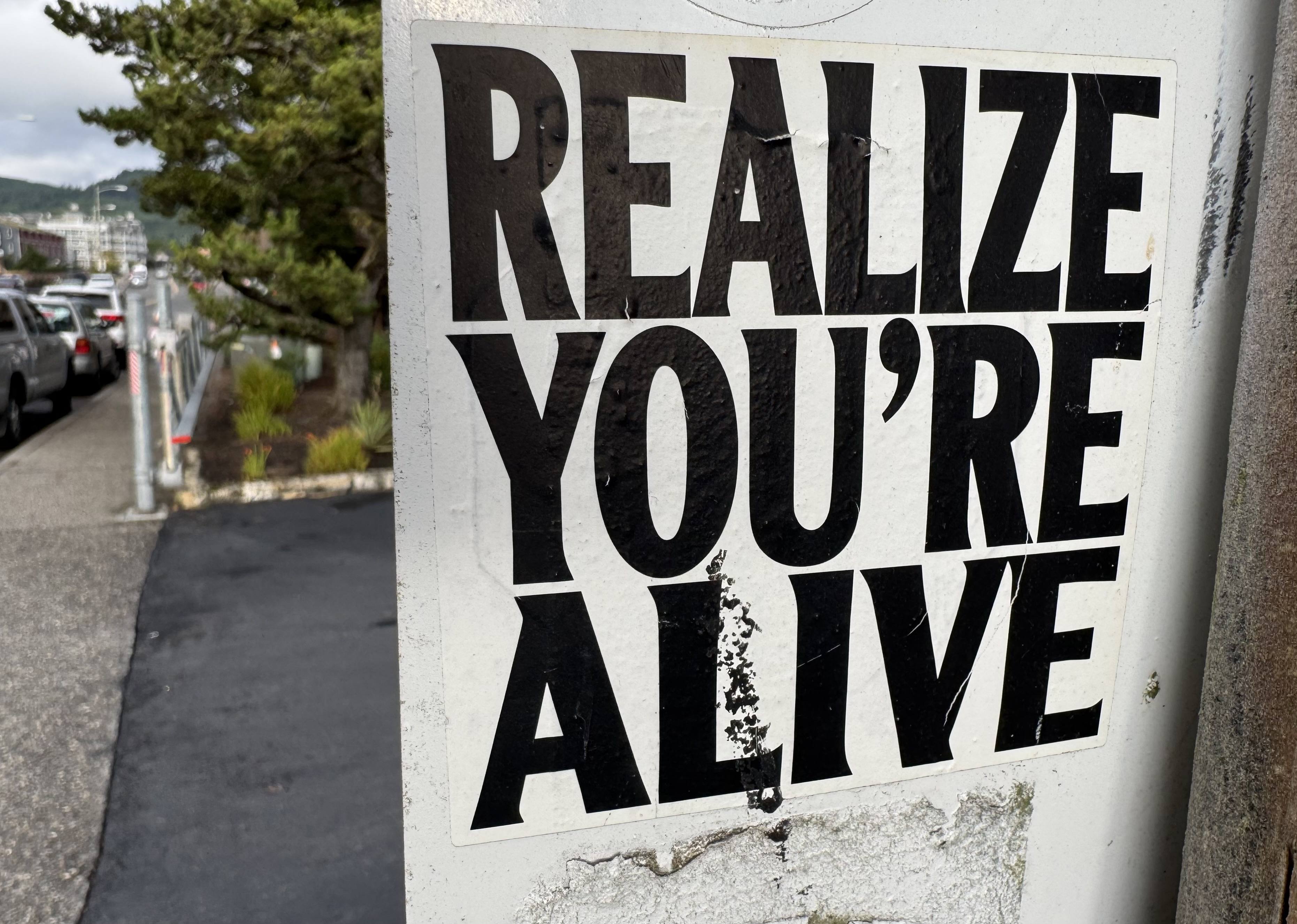

























































Photograph by Nathaniel St. Clair
I am living in a world that no longer exists.
I once lived in a vital world whose only limit was no-limit, “free frame of reference,” as the Haight Street Diggers thought. It was a world of beatniks, Buddhists, hippies, free-jazz poets, pacifists, wandering guitar soloists, postmodern fabulists, soulful anarchists, and collaborative maunderers. It was also a world of close readers, deconstructors, and afficionados of the beautiful, all performing in the heady atmosphere of refusal, a general strike of the Imagination.
It was the rebirth of the romantics, bohemians, Poets with a capital P, and Oscar Wildean dandies. In the face of the work ethic, bohemians old and new had the “right to be lazy,” as Marx’s son-in-law Paul Lafargue declared, or the right to “do your own thing,” as hippy culture would later agree. Of course, this is not a description of a real world, “how it was back then,” but of a psychic climate, the lovely mists and roiling waters of which still sustain my inner life. As Ted Gioia writes in his book Music: A Subversive History, the era brought “a highly contagious psychic treason to prevailing values.”
This world and its open assumptions about possibility slowly dissipated over a thirty-year period. As the late Sly Stone put it, “The possibility of possibility was leaking out.” It seemed quite dead by the millennium, our collective mind aspirated into glass pipettes by techno-oligarchs and assorted others who bore us no love. We were left with Data World, the Great American Smartphone Society. We have been priced out of cities, so there are no avenues to barricade, no “scenes” where artists and musicians can hang out, and our universities are in ruin, occupied by “indentured students,” in Elizabeth Tandy Shermer’s telling phrase, studying only what the boss wants. And what the boss wants has nothing to do with poets. Even at Canterbury’s Christ Church University, the destination for Chaucer’s pilgrims in The Canterbury Tales, poetry is “no longer viable in the current climate.”
And yet my heart/mind still resides in that other world, that yesterday world, the world that no longer exists.
Whatever for?
Of course, the feeling of living in a non-existent world is not a new thing. Every human life that goes beyond the thirtieth year will be familiar with it to some degree. The Austrian writer Stefan Zweig wrote a book about it titled The World of Yesterday.
For Zweig, that meant late nineteenth and early twentieth century Europe and its generation of elite artists and intellectuals like Freud, the novelist Romaine Rolland, and the modernist composer Richard Strauss. But in 1939, after the rise of Hitler, Zweig and his wife, Lotte, went into exile not only from Austria but from a world rich with music, words, images, and ideas. His novels had been placed on the Nazi’s list of proscribed books and burned, and it was increasingly clear that, as a Jew, he himself was likely on a different and deadlier list. They went to London first, then to the United States, where they were guests of Yale University, and finally to a small German colony in Petrópolis, Brazil, of all unlikely and far-flung places for a Viennese aesthete. In 1942, he committed suicide with his wife by an overdose of sleeping pills. As he explained in a note, “I think it better to conclude in good time and in erect bearing a life in which intellectual labor meant the purest joy.”
A photograph was taken of the bodies of Zweig and Lotte lying on a small bed. He is shaved, mustache
neatly trimmed, in a shirt and tie. She is in fetal posture, snuggled at his side, as if they were just napping after sex, or as if patiently waiting for whatever life came next. Her left hand covers and comforts his folded hands. The fatal box of sleeping pills sits on the bedside table beside a water glass. There is no book on the table for bedtime reading. No need for that any longer. Zweig had sent the manuscript of his last book, The World of Yesterday, to his publisher the previous day. Everything is tidy, nothing left undone, except all the things he might have done had he chosen to live on. Suicide was Zweig’s way of checking out of the grand fantasy of cosmopolitan Europe, soon to become a mass grave.
Also in 1939, the first year of Zweig’s exile, Jean Renoir’s movie The Rules of the Game was released. It tells the story of that historical moment, Germany and France once again on the threshold of war, but in a very different way. Rather than mourning the death of Europe’s rich culture, Renoir suggests that Zweig’s privileged class was to a degree responsible for the nearing catastrophe.
The film takes place at a country estate called La Colinière among members of the haute-bourgeoisie. This is the stage for Renoir’s display of the upper-crust’s moral indifference to everyone and everything (especially rabbits) outside of their own class. For them, life is simply the “rules of the game” that apply inside of their caste. As the character Octave explains, “You see, in this world, there is one awful thing, and that is that everyone has his reasons.” In other words, everyone knows the rules/reasons of the social class game, even if it is inhuman to follow them. As Renoir explained:
[W]hat is interesting about this film, perhaps, is the moment when it was made. It was shot between Munich and the war, and I shot it absolutely impressed, absolutely disturbed by the state of mind of a part of French society, a part of English society, a part of world society.
The Rules of the Game is not a tragedy but a terminal comedy. It is a farewell party. It is “laughter out of dead bellies,” in Ezra Pound’s phrase.
Zweig was part of the “state of mind” that Renoir describes. Zweig confesses that the intellectual elite of Vienna were not awake to the rough beast slouching toward them. Zweig writes, “[We] noticed little of these dangerous changes in our native land; our eyes were bent entirely on books and pictures.” In Nietzsche’s words, Zweig lived “in a happy blindness between the past and the future.”
The World of Yesterday is an acknowledgment that this abundance of kultur, all these erudite manners, the strict enforcement of elite conduct, all this endless cultural elaboration and haughty indifference, would soon be, literally, ash in the wind. Like so many at the time, Zweig was in exile not only from his home, but from everything he had taken to be reality, and he was incapable of imagining a new reality. For Zweig, suicide was nothing because his world was already dead. He was a victim of history twice over: as a refugee and as someone who could not live beyond the memory of a world that no longer existed. As Nietzsche wrote in The Use and Abuse of History, an obsession with the past destroys the possibility of a living present:
One who cannot…forget the past, who cannot stand on a single point, like a goddess of victory, without fear or giddiness, will never know what happiness is; and, worse still, will never do anything to make others happy.
On the other hand, Renoir was one who could see the history that Zweig was ruined by but then proceed to the next “joyful deed,” the making of a work of art. Renoir was Zweig’s health-giving opposite, a rule-breaker and a world-maker. As the British Socialist Worker described his work in 2006:
[The] great quality in Renoir’s movies is that he is always a rebel. In Renoir’s movie world, rules are for breaking, conventions are for disregarding, and authority is for mocking.
In our own very much more dangerous world—threatened not only by fascism but also by nuclear annihilation, climate disruption, spreading food deserts, and ever-larger and more desperate masses of migrants—we too fail to see the writing on the wall even though, once again, it is right before us in
“letters of fire,” as Zweig wrote. Worse, it is not at all clear that we can do what Nietzsche thought was crucial: “to assimilate and digest the past and turn it to sap.”Happily, it will always be possible to create stories that liberate us from the stories of our masters. This is what William Blake called for when he wrote in Jerusalem (1815), “I must create a system or be enslaved by another man’s; I will not reason and compare: my business is to create.” Or, even more assertively, William Carlos Williams in Kora In Hell (1920):
There is nothing sacred about literature, it is damned from one end to the other. There is nothing in literature but change and change is mockery. I’ll write whatever I damn please, whenever I damn please and as I damn please and it’ll be good if the authentic spirit of change is on it.
That, for me, has always been gospel.
Blake’s quote is “heavy,” as hippies used to say, because it asks, as Tolstoy put it, “What is to be done?” The answer to that question might simply be “tell better stories.” Live through better stories. Live through stories that will be understood in an as yet unimagined world, just past the next bend in the river, where the Imagination lives in all its inherited riches. So, let us be Nietzschean, all too Nietzschean, without fear or giddiness, and seek liberation for ourselves and others.
The post Psychic Treason appeared first on CounterPunch.org.
This post was originally published on CounterPunch.org.